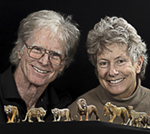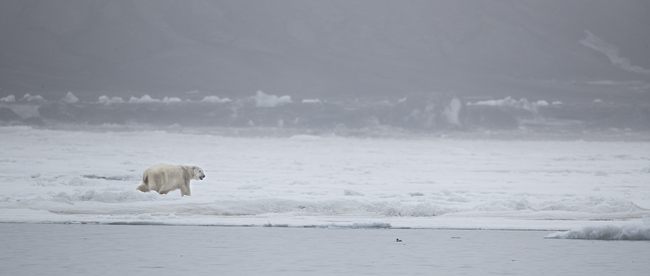
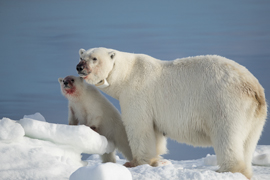
Trip Report:
Svalbard - Polar Bears
and the Wildlife and Birds -
Photo Tour
2017
Check out the 5 minute video on
Svalbard's wildlife photography
opportunities -- filmed on these
two trips in 2017.
Check out our 2019 Brochure
for our next trip to Svalbard!
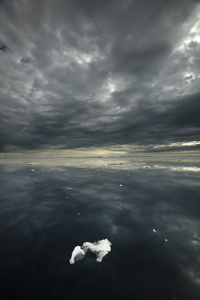 This was our fifth visit to Svalbard, an island archipelago far above the Arctic Circle, and our two trips this year were perhaps the best yet. Encompassing the first three weeks in June we arrived when snow still covered most of Longyearbyen, the largest town in Svalbard, and the hillsides and mountains throughout the islands. During our three weeks we watched, in near astonishment, as the snow covered disappeared, as did much of the 'fast' ice lining the shorelines and glacier bays. By the end of our trip the temperature in Longyearbyen was 42 degrees, ten more than when we had arrived.
This was our fifth visit to Svalbard, an island archipelago far above the Arctic Circle, and our two trips this year were perhaps the best yet. Encompassing the first three weeks in June we arrived when snow still covered most of Longyearbyen, the largest town in Svalbard, and the hillsides and mountains throughout the islands. During our three weeks we watched, in near astonishment, as the snow covered disappeared, as did much of the 'fast' ice lining the shorelines and glacier bays. By the end of our trip the temperature in Longyearbyen was 42 degrees, ten more than when we had arrived.
The wildlife viewing and photography was truly spectacular. While everyone's hopes and primary focus are on Polar Bears, Svalbard offers a wide variety of Arctic species and this year we did exceptionally well with all. We had great photo opportunities with Atlantic Walrus, Bearded Seals, Northern Fulmars, Eiders, Brunnich's Guillemot and Black Guillemots, and more.
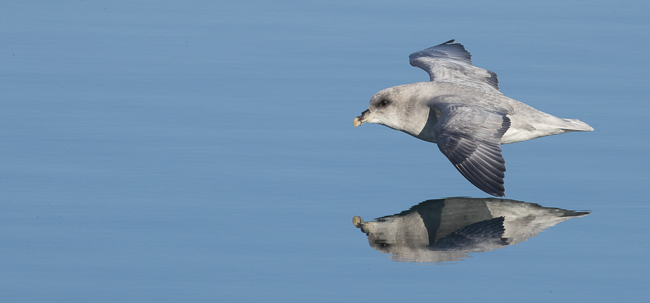
Northern Fulmar
This year we did two trips, our 'normal' seven day tour and a special ten day trip. For both, we headed south, rounding the southern end of Spitsbergen (the main island) and entering the Storfjorden Strait or sea, heading towards Edgeoya, the largest island in the south east and near to one of the Polar Bear nursing grounds. Pack ice from even further north had blown and drifted south, blocking the northern route around Svalbard -- which was just fine for us. The wildlife in the south is fantastic, as our experiences so richly showed. We had plenty of Polar Bears - 16 on the first trip, 13 on the second. As on almost all trips,

Bearded Seal
I've included both Trip Reports here -- so if you'd like to only read Trip Two's report, just scroll down, but you'll miss some great images if you do so! At any rate, here's the reports
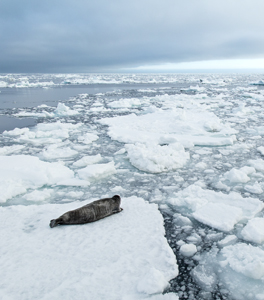
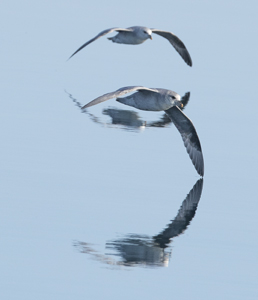
Bearded Seal; Northern Fulmar
Trip 1
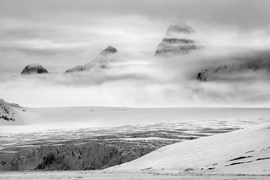
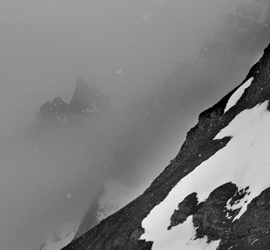
Day 1. We arrived in Svalbard without incident. Several of us had purchased ‘extended’ or premium-style tickets that gave us first-boarding rights for the connection from Oslo to Svalbard. Consequently, the worry about getting carry-on luggage was averted.
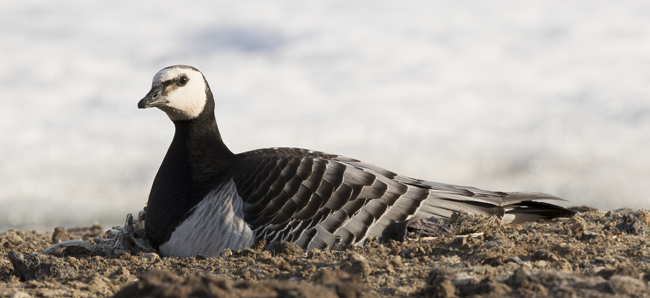
Barnacle Goose
We arrived to a cold but sunny Longyearbyen. Snow carpeted the hillsides, and in most of the long, flat stretches of floodplain or coastal plain the land was covered with more than 50% snow. Mary and I rented vehicles for an afternoon game-drive with the group, and checked out both the dog-sledding area, where Eider Ducks nest, and the coal-mining hillside, where Svalbard Ptarmigan, a subspecies of Rock Ptarmigan, can be found.
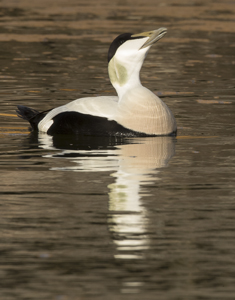 The Eider colony was not as crowded as it was two years ago, at least to our recollection, but we still had dozens of pairs of ducks on nests and numerous, brightly colored males swimming about, tossing their heads back periodically to give a call, ‘ah-whooo’, a gentle moaning purr. Parasitic Jaegers, the principle bird of prey of the islands, circled periodically, swooping down to harass a duck and, hopefully, to steal an egg. We saw none succeed. The sun was behind the birds, making the shooting somewhat contrasty, but that soon changed. A sea fog had drifted in, making the light dull and the roadside shooting somewhat dangerous, as trucks and vehicles materialized out of a gray white-out like condition without warning. The fog chilled, too, and so we headed back towards town and higher elevations to look for Ptarmigan.
The Eider colony was not as crowded as it was two years ago, at least to our recollection, but we still had dozens of pairs of ducks on nests and numerous, brightly colored males swimming about, tossing their heads back periodically to give a call, ‘ah-whooo’, a gentle moaning purr. Parasitic Jaegers, the principle bird of prey of the islands, circled periodically, swooping down to harass a duck and, hopefully, to steal an egg. We saw none succeed. The sun was behind the birds, making the shooting somewhat contrasty, but that soon changed. A sea fog had drifted in, making the light dull and the roadside shooting somewhat dangerous, as trucks and vehicles materialized out of a gray white-out like condition without warning. The fog chilled, too, and so we headed back towards town and higher elevations to look for Ptarmigan.
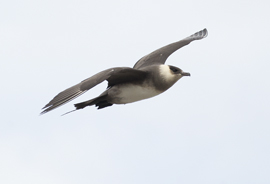
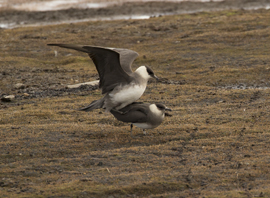
A pair of Parasitic Jaegers
hunted above the Common Eider colony.
At one point the two paused for equally important business.
We found one pair of these grouse relatives. Although they appeared further away than I’d like, I was surprised at the image size captured by those who photographed the birds. It was decent. The birds moved across a small ridgeline above us, with the female, although clearly within sight, being nearly invisible with her cryptic coloration, lines of black on a rock-colored brown/gray ground color. The male, clad completely in white, stood out conspicuously, with only a small red crest above the eye breaking up his form.
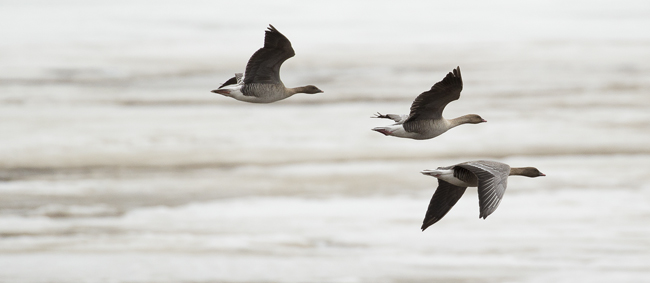
Pink-footed Geese
After dinner, stuffed uncomfortably, several of us went for a walk, discovering a pair of Pink-footed Geese in an open lot quite close to the road. They were the best I’ve seen for photo opportunities, and Cindy  headed back for her camera. The rest of us continued, but a pair of Barnacle Geese, striking in the clear late afternoon light, was too much.
headed back for her camera. The rest of us continued, but a pair of Barnacle Geese, striking in the clear late afternoon light, was too much.
(Eider Duck, left)
We headed back for our cameras, too, and the van, to make the trip a bit easier.
The birds had retreated to less favorable spots by the time we returned, and so we headed back to the dog sled area, hoping that the light had swung around and now faced the birds, as the fog had lifted. It had, and we had some decent shooting of both Eiders and Barnacle Geese before we called it a day.
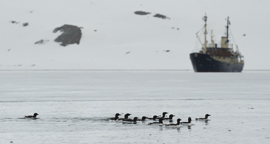 Day 2. We had a 7AM breakfast – the earliest the hotel’s restaurant served – before returning to the dog sled area for eiders. The day began windy and sunny, with rain forecasted for later, and while we photographed the light gradually softened and died. Although windy, few birds flew about and the shooting was only marginal. We headed for the ptarmigan area but we were unable to find another pair of these striking birds.
Day 2. We had a 7AM breakfast – the earliest the hotel’s restaurant served – before returning to the dog sled area for eiders. The day began windy and sunny, with rain forecasted for later, and while we photographed the light gradually softened and died. Although windy, few birds flew about and the shooting was only marginal. We headed for the ptarmigan area but we were unable to find another pair of these striking birds.
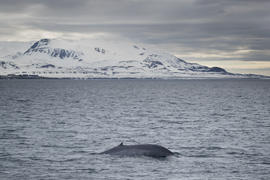 In the afternoon after a great pizza lunch we headed to the museum where our guide, Adam, gave a short talk on some of the subjects we’d be shooting, as well as a synopsis on the whaling and early settling of the islands. At 4PM we headed to our ship, boarding and squaring ourselves in the cabins before heading out to sea. An exciting bonus was a Blue Whale, the largest mammal on earth and, most likely, the largest animal to ever live. Hunted to near extinction, their numbers are still low, and the whales are rare here.
In the afternoon after a great pizza lunch we headed to the museum where our guide, Adam, gave a short talk on some of the subjects we’d be shooting, as well as a synopsis on the whaling and early settling of the islands. At 4PM we headed to our ship, boarding and squaring ourselves in the cabins before heading out to sea. An exciting bonus was a Blue Whale, the largest mammal on earth and, most likely, the largest animal to ever live. Hunted to near extinction, their numbers are still low, and the whales are rare here.
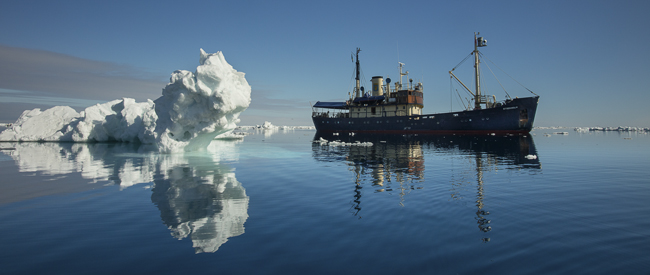
Day 3. We cruised through the night – or what should be night if the sun would set – and arrived at the fjord towards the southern tip of Svalbard, Storfjorden. At 9:30 we did a zodiac cruise along the glacier front, looking for birds and seals. It was dreary and a light drizzle dampened us, before the rain turned to hard, BB-sized balls of hail. Some of the shooters had some nice encounters with Murres and Arctic Terns, and although very far off, our first Arctic Fox. Adam spotted the fox as it ran across the fast ice (ice that stays attached to the shoreline and remains ‘fast’ until it melts in summer), which then ran along the shoreline before speeding its way up the steep hillside. The fox’s upward climb was fast, and most impressive.
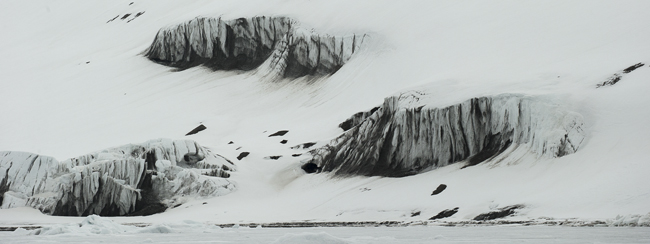
After lunch we explored deeper into the fjord where, at the terminus of more fast ice at the foot of another glacier, Adam and Mary spotted a very, very distant Polar Bear. Mary thought she saw it standing, and later Adam was fairly positive we had a bear, which Jim later confirmed when we used his 800mm, 1.25X converter, 1.6X crop-factor camera, and zoomed in on the LCD to make out a Bear lying on her side. A later shot revealed that she had three Cubs. Unfortunately the bear remained far away and after a bit of waiting it shoved off from the ice and continued south, to eventually clear the southern tip of the island and hit open sea, on our way to the birthing grounds of the Polar Bears on the pack ice. Regarding the ice – Satellite imagery revealed that the pack ice had been far north of the islands in the early part of the year. If that had continued, we’d have had to travel much 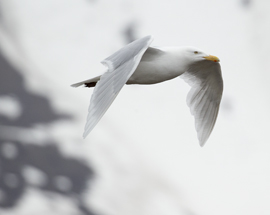 further north to encounter ice, and bears.
further north to encounter ice, and bears.
(Glaucous Gull, left)
Fortunately, though, by March the weather always seems to shift, and now, in early June, the entire top of Svalbard is encased in ice, making passage there impossible. The pack ice swept down the eastern side of the archipelago, extending south past the southeastern island and into the birthing grounds. That’s where we’re heading, and here, either tonight in the early AM hours of tomorrow, or tomorrow morning, we’ll be cruising along the edge of the ice fields, hoping to find bears.

Bearded Seal
Day 4. During the night we hit the ice, the sound of small berger bits and floes crashing against the bow and sides of our reinforced ship waking us from sleep. Half-alert for the knock and call, ‘bears!’ we dozed until 6 to a sunny, cloudless sky without a trace of wind. We spent the day passing through one stretch of ice pack into another, until towards Edgeoya Island, the large island landmass in the southeast section of the archipelago, we moved continuously through the ice pack. We had two Bearded Seals, one quite oblivious to us while the other, in brilliant light, eventually scooted into the sea – making for a nice motor-drive sequence. 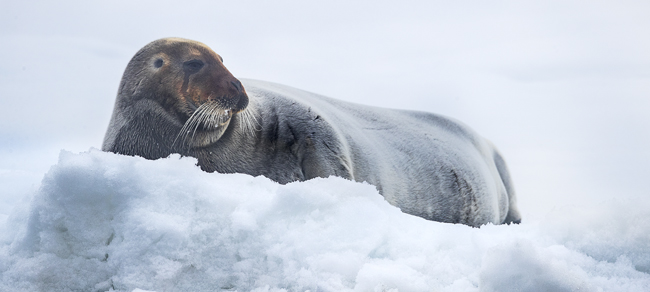
Bearded Seal
Mary and Bill both made it up into the Crow’s Nest, a mini-adventure for both, and Adam and Marty, our guides, spent a total of 5 hours there, fruitlessly searching for bears. We did a zodiac ride through the ice fields, giving everyone great opportunities to photograph our ship, the Stockholm, amidst the ice, and a few chances at Greater Black-back Gulls and the 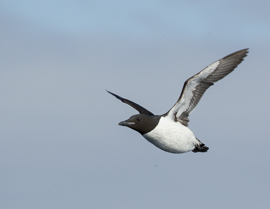
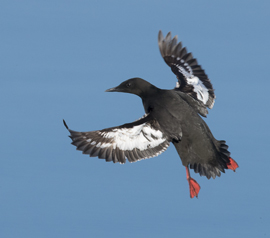
Brunnich's Guillemot; Black Guillemot
Murres, or Guillemots, that passed by. Our guides beached our zodiacs on a large ice floe, where we took a group photo and shared a large bar of chocolate, topping off our afternoon.
In the late afternoon we headed up the western side of the island through Storfjorden, the bay separating Edgeoyoa from Spitsbergen. The western shoreline was beyond the horizon line but despite the vastness of this sea the water was pond-like, perfectly still except for the V-shaped wake our ship created. Northern Fulmars began to follow the ship, and when gliding low, less than a body width above the water, their reflections were nearly perfect. Adam was about to give a lecture when the shooting got good, and so we cancelled the talk for productive shooting that continued until dinner. Afterwards, we continued cruising north, with the water now marred by a light breeze, erasing the earlier magic.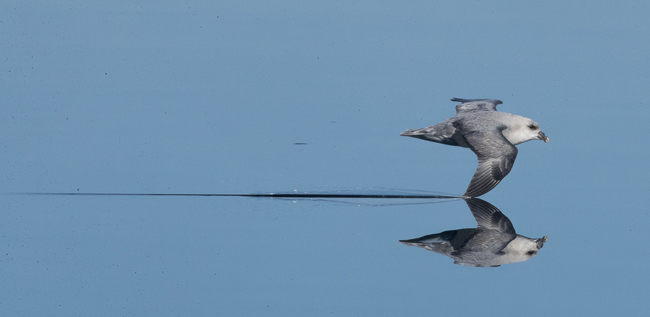
Northern Fulmar
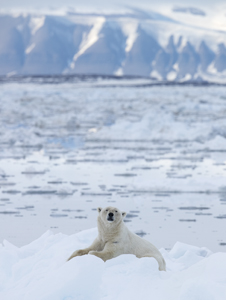 Day 5. In the early AM hours we reached more pack ice, and around 4AM Adam knocked on our doors to inform us that a Polar Bear had been spotted. We dressed, woke everyone up, and got on deck while the bear was still quite far away. The bear, a large male, was sleeping, but as we approached he awoke and, with weaving, almost snake-like movements of his head, inspected us, but soon fell back to sleep. Our ship pressed into the same ice floe, far enough away as to not disturb the bear, and periodically the bear would awake, check us out, or scratch, or look away towards a distant horizon, then drop back to sleep. We hoped that when it did finally get up it would inspect us more closely, but when the bear finally rose he walked along the ice edge, then turned, and delicately backed into the water before turning and swimming, ignoring other floes where he could have come to rest and instead disappearing into a gray gloom as fog descended on the sea.
Day 5. In the early AM hours we reached more pack ice, and around 4AM Adam knocked on our doors to inform us that a Polar Bear had been spotted. We dressed, woke everyone up, and got on deck while the bear was still quite far away. The bear, a large male, was sleeping, but as we approached he awoke and, with weaving, almost snake-like movements of his head, inspected us, but soon fell back to sleep. Our ship pressed into the same ice floe, far enough away as to not disturb the bear, and periodically the bear would awake, check us out, or scratch, or look away towards a distant horizon, then drop back to sleep. We hoped that when it did finally get up it would inspect us more closely, but when the bear finally rose he walked along the ice edge, then turned, and delicately backed into the water before turning and swimming, ignoring other floes where he could have come to rest and instead disappearing into a gray gloom as fog descended on the sea.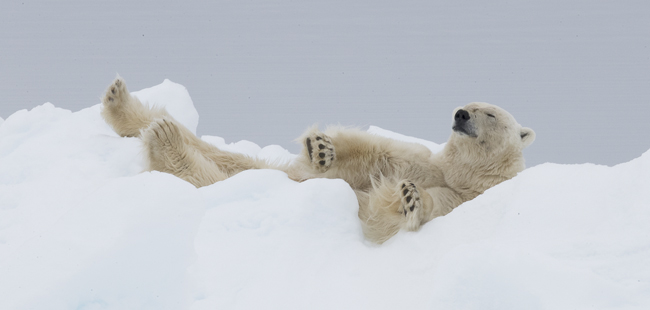
Most of us went back to bed – it was now 6AM, but soon afterwards we had our first Walruses. A female and a calf lay on a floe, and most of us got a few shots – through a masking veil of fog – before the two slid into the sea. After breakfast we had another, who also retreated quickly, and at 11AM we had two more, who did the same.
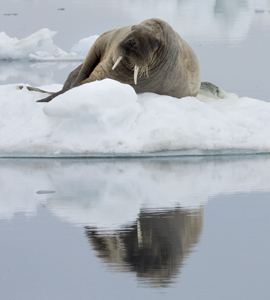 Throughout the day we had a few more Walruses and Bearded Seals but the shooting was marginal as we had a thick fog through most of the day. Our journey took us through and along pack ice all day, perfect country for bears and walruses, but the visibility was very limited. We did have Polar Bears – a mother with two cubs running across a distant ice field, and a male that, unfortunately, we surprised up close and who then ran off. We tried waiting in the ice, our ship held fast by pack ice, for the mom and cubs to approach us out of curiosity, but none did. Between some birds, some Walruses, and some Bearded Seals we had a nice day, but we fear we missed several chances at Bears that we simply missed in the heavy fog.
Throughout the day we had a few more Walruses and Bearded Seals but the shooting was marginal as we had a thick fog through most of the day. Our journey took us through and along pack ice all day, perfect country for bears and walruses, but the visibility was very limited. We did have Polar Bears – a mother with two cubs running across a distant ice field, and a male that, unfortunately, we surprised up close and who then ran off. We tried waiting in the ice, our ship held fast by pack ice, for the mom and cubs to approach us out of curiosity, but none did. Between some birds, some Walruses, and some Bearded Seals we had a nice day, but we fear we missed several chances at Bears that we simply missed in the heavy fog.
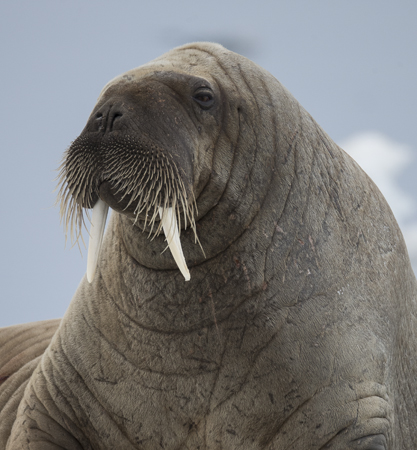
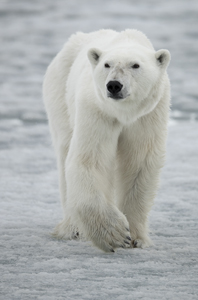 Day 6. We began heading south, following the eastern shoreline of Spitsbergen island and the fast ice that hugged its shore. Our route had us in an ‘inland waterway’ between the fast ice and the thick band of pack ice further out to sea, although often we barreled through bands of ice that blocked the route, and pancake slabs. The day was crystal clear – a refreshing change from yesterday, and we had high hopes.
Day 6. We began heading south, following the eastern shoreline of Spitsbergen island and the fast ice that hugged its shore. Our route had us in an ‘inland waterway’ between the fast ice and the thick band of pack ice further out to sea, although often we barreled through bands of ice that blocked the route, and pancake slabs. The day was crystal clear – a refreshing change from yesterday, and we had high hopes.
Marty, up in the Crow’s Nest, spotted his first Polar Bear for this trip. A cubless female, she was lying by a seal hole hunting. We ‘parked’ our ship in the ice, with our captain pushing forward, backing up, and hammering deeper into the ice to close the distance, and, locked in ice, creating a stable platform for shooting once the engine stopped. The bear was doing nothing so everyone returned to editing or sleeping, as we hoped the bear would get curious. It did, and Adam, our head guide, rushed down to tell us that the bear was approaching, fast!
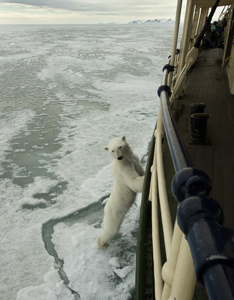


We hurried on deck and the bear did a direct, surprising rapid approach to our ship, eventually walking right up to the hull where, under the ship’s curves, it disappeared. We checked both sides of the ship to see where she went, finally discovering her on the same side she had approached, but now peering, one by one, into the ship’s portholes. At one point she stood up and sniffed the boat deck – her head level with my feet, but as I moved in for an intimate wide-angle she dropped back to the ice. She walked to the back of the boat, continuing along the water route we had just carved through the pack ice, and finally crossed that open water. Amazingly, the open water dotted by the blocks of broken ice had already begun to refreeze, and the bear had a stable series of steps or platforms as it walked across the slabs, keeping her balance and remaining dry as she crossed, and continued out onto the pack ice.
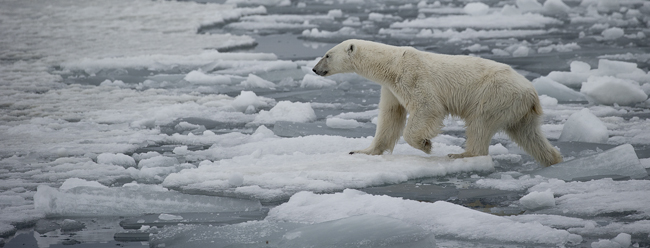
Though the remainder of the day we spent more time with three other Polar Bears that were hunting Ringed Seals far in the distance. One pair appeared to be only thirty yards or so from a Seal that remained on the ice despite the occasional head movements and foot-shifting of what we supposed was a hunting bear. Although we hoped one would approach, none did, and eventually we moved on.
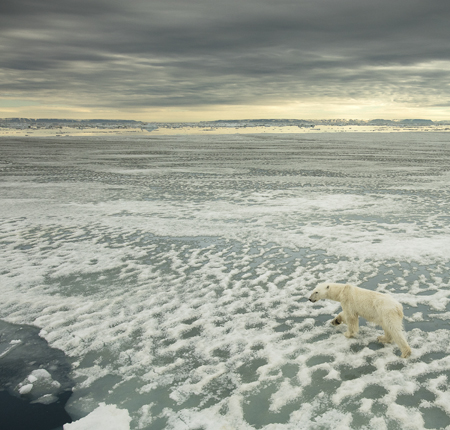
Adam spotted another bear far in the distance. He suspected it was feeding on a seal – quite the assumption considering the mile-plus distance that separated us. It was close to dinner time and instead of approaching then, we had dinner – rapidly, then boarded zodiacs to attempt a water-level approach. Adam had cautioned us that bears are often tolerant of a big ship but fearful of zodiacs, the exact opposite that applies for Walruses, but expectations were high as the water-level possibilities were exciting.
We motored out, moving very slowly and, as we neared the bears, making a snaking approach, giving the bear time to see us and become accustomed. 

As we neared she rose – she had a COY (cub of the year) with her, and hissed a warning. She didn’t yawn or shake her head – usual signs of annoyance or aggression, but instead approached the edge of the ice floe, stopped, then turned and jogged to the opposite side of the floe, entering the water and swimming off. Her cub climbed aboard for a piggy-back ride, but too distant for a shot. We left her, hoping she’d return to what looked like an untouched kill and hoping that she’d be more tolerant of the ship when we returned later.
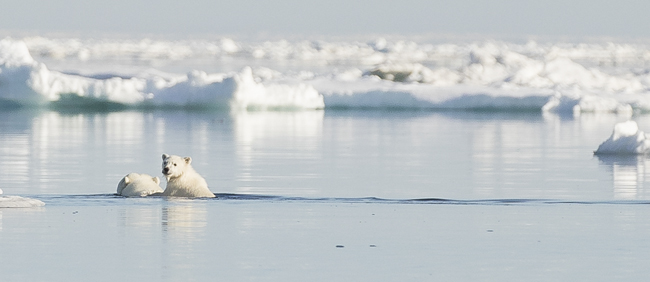
Prior to our reaching the bear I had suggested that our photographers go to the front of the ship in case our approach spooked the bear again. Jim and Mary did go to the front, but everyone else, hoping for a lower angle, stayed on the lower deck. I was the last in line there, and had a miserable view, and as no one else chose to move up, I did, taking an open position at the front. It was a much better viewpoint.
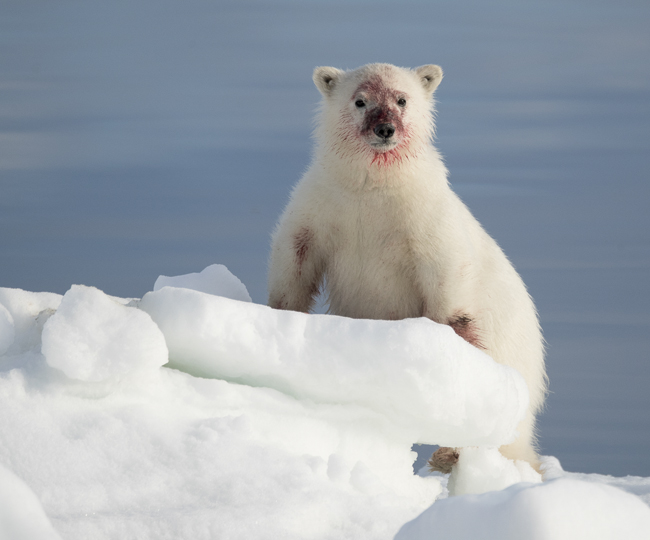
Although the ship didn’t move, and no one did anything to prompt a change, the bear eventually stopped feeding and reentered the water. Her cub followed, but instead of climbing upon mom’s back the cub just swam behind, the two of them moving away from us and rapidly retreating. We left them, backing up to give the bears some room, and resumed our journey south. We passed the bears, still swimming, although we suspect they’ll return to the kill. If they did not, other bears would soon find the stinking carcass.
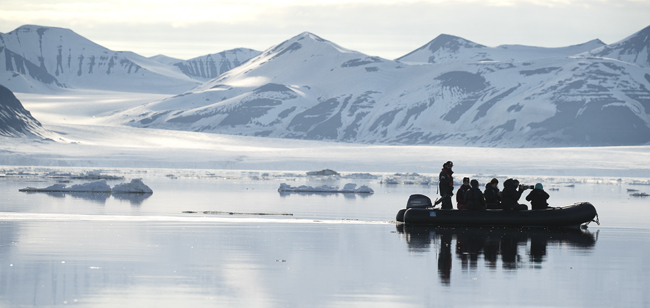
For the record, both our guides and the captain felt poorly about the bears leaving the kill. Our approach by zodiac was text-book correct, slow and meandering and everyone silent and still, and the bear gave no indication of annoyance – they’ll usually yawn as a distraction display as a clue – before she rose and left the floe. For the ship encounter, the bears fed steadily for about twenty minutes, seemingly uncaring, and then, suddenly and unexpectedly, rising and leaving. Perhaps, then, they were full, but either way, we would have preferred leaving the bears as they continued to feed. Still, everyone was satisfied and it was a good evening shoot.
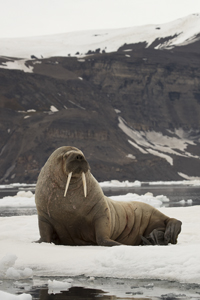 Day 7. We continued heading south, traveling along the pack ice without too many distractions, with a mindset, perhaps, that the trip was drawing to a close. Close to the southern tip of Svalbard Adam spotted a lone Walrus on the ice, and this time we tried a zodiac approach. The walrus cooperated, as we did a very slow and silent route that snaked along, finally drawing us within a great range for shots of the Walrus against a mountain backdrop. The walrus was asleep when we first neared, but periodically would awaken, look about or rise up, then flop back down to fall asleep again. Although we’d seen several Walruses on the trip, most were in fog, and this one was a real gen.
Day 7. We continued heading south, traveling along the pack ice without too many distractions, with a mindset, perhaps, that the trip was drawing to a close. Close to the southern tip of Svalbard Adam spotted a lone Walrus on the ice, and this time we tried a zodiac approach. The walrus cooperated, as we did a very slow and silent route that snaked along, finally drawing us within a great range for shots of the Walrus against a mountain backdrop. The walrus was asleep when we first neared, but periodically would awaken, look about or rise up, then flop back down to fall asleep again. Although we’d seen several Walruses on the trip, most were in fog, and this one was a real gen.


Bird cliffs; Black-legged Kittiwake
 Day 8. We steamed north toward Longyearbyen, but the seas were benign and we made unexpectedly good time, giving us an opportunity to explore a glacial front on the north side of the Longyearbyen sound. (Bearded Seal, left) A small group of Common Eiders had, in company, one male King Eider and a few immatures and females. All were skittish, and eventually flew, but did so flying cross-wise towards us and several of us got some decent shots.
Day 8. We steamed north toward Longyearbyen, but the seas were benign and we made unexpectedly good time, giving us an opportunity to explore a glacial front on the north side of the Longyearbyen sound. (Bearded Seal, left) A small group of Common Eiders had, in company, one male King Eider and a few immatures and females. All were skittish, and eventually flew, but did so flying cross-wise towards us and several of us got some decent shots.
While cruising the fast ice separating us, at a great distance, from the glacier front, Mary spotted a Polar Bear on a small bird island that separated the sea from the narrow fjord. The bear was sleeping, but as we approached it awoke and walked along the crest of the hill , dropping into the snow to retrieve the final remains of a seal carcass. The bear moved away, so we circled the island, hoping to get close as it fed. Instead, however, the bear was shy, and as we neared it got up and entered the water, crossing a small stretch of open water before climbing back onto the ice, shaking fur, and walking off. We paralleled the bear, and framed the distant bear against a backdrop of the glaciers – a very effective image. With that, our 16th bear for the trip, and a shooting opportunity with a King Eider, we called it a day.
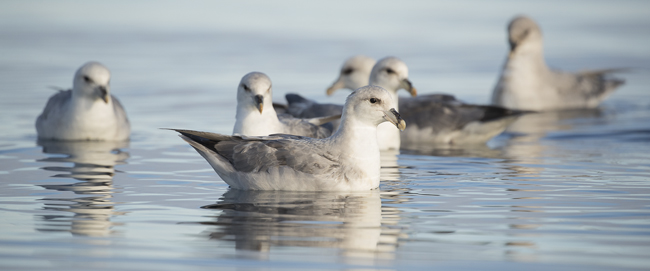
Northern Fulmar
After dinner we said thanks to our guides, first giving them a thick ‘tip’ envelope that we asked them to open. Inside, were ‘tips,’ like ‘don’t eat yellow snow,’ etc., which gave everyone a laugh. After that act we presented the guides and crew with the real envelopes, and finished the evening with a Participants’ Portfolio of shots from the trip.

Brunnich's Guillemot
To see this trip from a participant's perspective, here's a short essay from Lorelei Metildi. She and Steve did the seven day trip this year.
Impressions of Svalbard
 Sailing along the Artic seas, hugging the coastlines of a group of islands known as Svalbard, situated between mainland Norway and the North Pole. Feeling like explorers in a vast, rugged landscape, searching for wildlife among the pack ice below massive glaciers, and icebergs floating jauntily beside us. In the land of the midnight sun, we could explore for hours on end, and not be constrained by the light. Sun shone most of the time, with puffy clouds creating contrast with the deep blue of the sky. In our small ship, we could go into areas that were more isolated. Then emerge from the other side, into the open seas. Water, so calm, still….the surface like glass- smooth, reflective, of all that surrounded it. We cut through that ice though! Some large chunks that had looked so imposing, cut in two in a manner of seconds. Jamming them into other iceflows, lifting upward, toward the sky, with nowhere else to go in a sea already full. Up in the engineer’s room or further up in the crow’s nest, spotters worked tirelessly to find wildlife. We usually had plenty of time to get “camera ready”, once alerted. And we would line up on deck, and wait… and a polar bear would appear, or a walrus, or a bearded seal. Floating right next to our ship, on iceflows. Or a minke whale, right off our bow. Other times, we would ram our ship into the edge of the pack ice. And wait. At least once a day we’d go into the zodiacs and take off toward a sighting. We’d then float next to a walrus lounging about, or a polar bear mother and cub feasting on a seal carcass, and then swimming, cub atop her mother’s back. That last sighting was on my birthday. What a gift! Speaking of gifts, that same birthday morning, we parked and watched as a polar bear walked toward our ship, from quite a far distance. We soon found ourselves peering downward from the deck, as he stood on his hind legs and peered into each of the portholes! Then, he walked away from us, his curiosity met.
Sailing along the Artic seas, hugging the coastlines of a group of islands known as Svalbard, situated between mainland Norway and the North Pole. Feeling like explorers in a vast, rugged landscape, searching for wildlife among the pack ice below massive glaciers, and icebergs floating jauntily beside us. In the land of the midnight sun, we could explore for hours on end, and not be constrained by the light. Sun shone most of the time, with puffy clouds creating contrast with the deep blue of the sky. In our small ship, we could go into areas that were more isolated. Then emerge from the other side, into the open seas. Water, so calm, still….the surface like glass- smooth, reflective, of all that surrounded it. We cut through that ice though! Some large chunks that had looked so imposing, cut in two in a manner of seconds. Jamming them into other iceflows, lifting upward, toward the sky, with nowhere else to go in a sea already full. Up in the engineer’s room or further up in the crow’s nest, spotters worked tirelessly to find wildlife. We usually had plenty of time to get “camera ready”, once alerted. And we would line up on deck, and wait… and a polar bear would appear, or a walrus, or a bearded seal. Floating right next to our ship, on iceflows. Or a minke whale, right off our bow. Other times, we would ram our ship into the edge of the pack ice. And wait. At least once a day we’d go into the zodiacs and take off toward a sighting. We’d then float next to a walrus lounging about, or a polar bear mother and cub feasting on a seal carcass, and then swimming, cub atop her mother’s back. That last sighting was on my birthday. What a gift! Speaking of gifts, that same birthday morning, we parked and watched as a polar bear walked toward our ship, from quite a far distance. We soon found ourselves peering downward from the deck, as he stood on his hind legs and peered into each of the portholes! Then, he walked away from us, his curiosity met.
 The Polar Quest leaders, Adam and Marty were exceptional, getting us to where we needed to be, for optimal viewing, and photo angles. Always ready to share their knowledge of the area, as well as answer any questions that came their way.
The Polar Quest leaders, Adam and Marty were exceptional, getting us to where we needed to be, for optimal viewing, and photo angles. Always ready to share their knowledge of the area, as well as answer any questions that came their way.
(Black Guillemot, left)
Adam’s “animated” slide shows in the lounge area (whenever we had any down time) were entertaining, as well as informative.
The ship’s crew, they were always working, always helpful and always pleasant. Pieter, the chef, worked magic with the allotment of food he was given at the beginning of the season.
His newly created recipes turned our meals into gourmet feasts, from crepes stuffed with prawns, to reindeer stew to blueberry mousse. We sat out on deck one sunny afternoon and had pea soup, Swedish pancakes with berry preserves and whip cream. And some delicious liqueur, downed in one shot, to celebrate a Swedish holiday amid crewmembers singing a rousing Swedish song. There were desserts available in the lounge mid-morning and mid-afternoon as well. In celebration of my birthday, a delicious white creamy cake with strawberries was made for the occasion. A Happy Birthday banner was strung above, my Svalbard pamphlet filled with well wishes from everyone, Adam’s photo postcard of a polar bear face stuck in the porthole of OUR cabin, and champagne ready to be popped. Happy Birthday sung in both English and Swedish.. All those beaming faces, happy at the chance for a celebration….
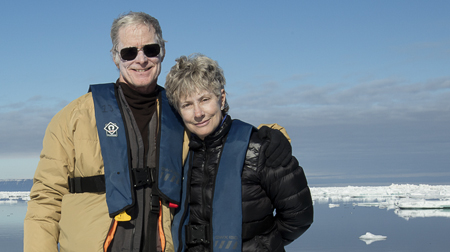 Our group was so much fun to be around. All of us, grateful to be sharing such rare and wonderful experiences together. And, I finally got to meet Mary Ann McDonald! She was warm, upbeat, positive and generous. I so enjoyed getting to know her better as we all gathered round the dining area and talked long after every meal. And Joe McDonald, always so happy! Can always count on him for a story, or an inquisitive pondering about the nature of things. His jokes became “running jokes” the entire trip, making laughter a big part of our time together.
Our group was so much fun to be around. All of us, grateful to be sharing such rare and wonderful experiences together. And, I finally got to meet Mary Ann McDonald! She was warm, upbeat, positive and generous. I so enjoyed getting to know her better as we all gathered round the dining area and talked long after every meal. And Joe McDonald, always so happy! Can always count on him for a story, or an inquisitive pondering about the nature of things. His jokes became “running jokes” the entire trip, making laughter a big part of our time together.
That first day, when we arrived in Longyearbyen, via a night in Oslo, we as a group, explored the area and found reindeer, ptarmigan, geese, and eiders nesting between two areas housing sled dogs. Dinner, at an establishment with a “rustic” decor. The next day we explored the area more, taking photos of old abandoned mines and the town itself. Afterward, shopped just a bit before lunch. We all shared several “inventive” pizzas, the best of which had a bok choy cabbage topping! Of course, jokes were made about that, too. Then we all toured the Polar Museum, a history of whaling and mining, with Adam as our guide.

Black Guillemot
For six and a half glorious days, we sailed the SS Stockholm, a 130-foot ship that was smooth and comfortable, thanks in part to the owner, who steered us (quite masterfully) through it all. We journeyed south, rounded northward, through fjords surrounded by glaciers and ice, under mostly sunny skies - except for one fog enshrouded day. Although I must say, seeing a walrus and her young one through a misty haze, was really quite mystical to me. And for the most part, as was mentioned, the water was like glass. Only on the last day were we in open, choppy waters, making it rough going, for some people (like me!)
I’ll always remember the sight of Northern Fulmars flying behind the wake of our ship, or swimming closer to us, heads cocked in a curious fashion, as we positioned our zodiacs to de-board. Or the time we were awoken by a 2:30 AM announcement: “Polar Bear”! Photographing for four hours, a bear, in a hollowed out bed of sorts, yawning, stretching, sitting up, sniffing the air towards us, repositioning himself, then finally going into the water, gently, backwards, so a splash would not interfere with his hunting.
 Or the time Adam rammed our zodiac up onto a floating iceberg and we all got off and took group photos. The motor was still running, making the iceberg go in circles, creating a surreal merry-go-round effect. As if being on top of an iceberg in the middle of the Artic Ocean wasn’t surreal enough!
Or the time Adam rammed our zodiac up onto a floating iceberg and we all got off and took group photos. The motor was still running, making the iceberg go in circles, creating a surreal merry-go-round effect. As if being on top of an iceberg in the middle of the Artic Ocean wasn’t surreal enough!
Even though while aboard ship, time had such a nice, leisurely flow to it….just right, really, the end of the trip came all too quickly.
All too quickly, indeed.

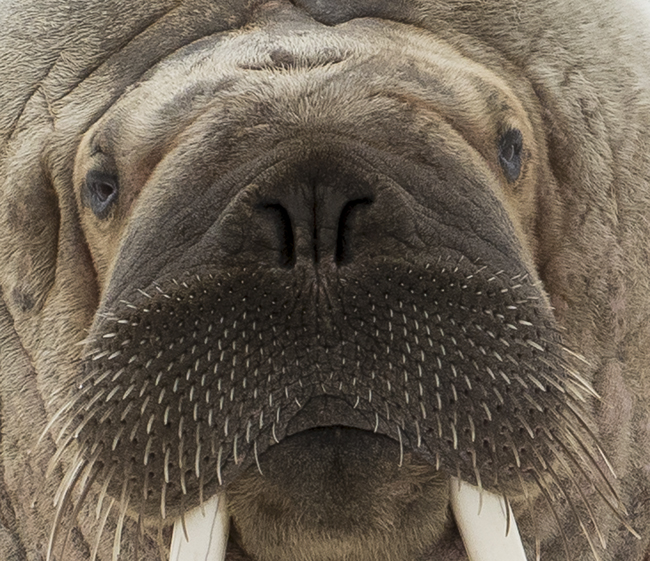
Trip Two
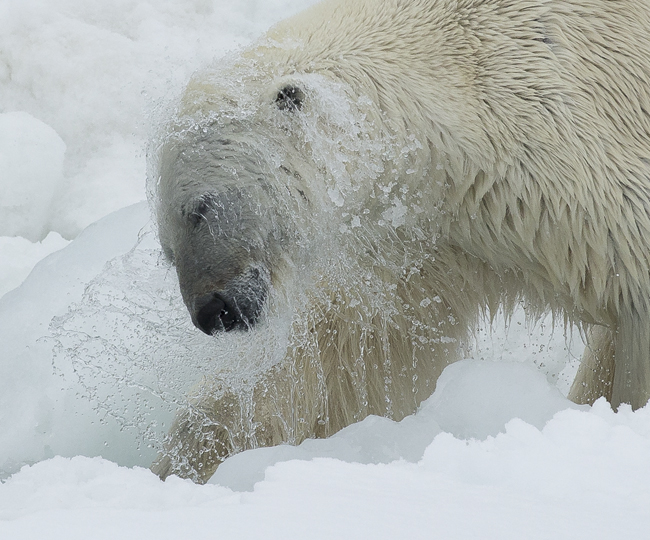
Day 1. We arrived in port on the last evening of our first group, and this morning, Mary, Bill, Larry and I took a taxi into town to meet the new group and retrieve our cars for a morning trip for Eiders and Ptarmigan. As we left the taxi – a big van – we left our winter coats and clothes behind, in a back seat. We were about to go for the Eiders when we discovered this, and we headed back into town to hunt down the taxi. He, it turned out, had driven his van to his house and parked, and ignored the phone calls from the dispatcher regarding our clothes. Eventually I drove on to the Eiders while Mary tracked the taxi guy down, finally getting our clothing and joining us at the ducks.
The shooting was slow, with the light rather dreary. In contrast to the last trip, just eight days earlier, the bay and hillsides were now virtually snow free. Eiders had laid eggs, and several worked their down and the grasses rimming their nest to cover their eggs whenever they left for a swim or a feed. No gull or jaegar raided a nest while we were there.
With a half hour left before we had to quit we drove on to the Ptarmigan area. I spotted one male, soaring in its descending, swooping courtship flight, but the bird landed high on the mountain slope and presented no chances for photos. We saw no reindeer.
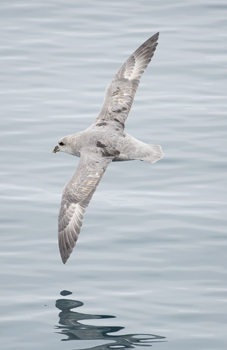 Returning to the town, our group started lunch while we said our good-byes to our first group. It was sad to see them go. After the museum visit, Judy, Suzanne, Mary, and I walked to the ship while the rest drove, giving some a bit of extra time to square away their new lodging.
Returning to the town, our group started lunch while we said our good-byes to our first group. It was sad to see them go. After the museum visit, Judy, Suzanne, Mary, and I walked to the ship while the rest drove, giving some a bit of extra time to square away their new lodging.
We left port at 4, and had great Northern Fulmar opportunities. I wasted much of those chances by trying – probably unsuccessfully – to do slow shutter speeds and panning as the birds sailed by. Judy did wide-angles instead, as the birds often flew quite close. She captured some great shots of frame-filling birds with a mountain backdrop.
We finished the day with a fast-moving Blue Whale. Early on, in this encounter, the whale raised its tail high – almost like a Humpback, but the whale was still quite distant. Although we saw the whale several times it never presented its tail again, and we headed on south.
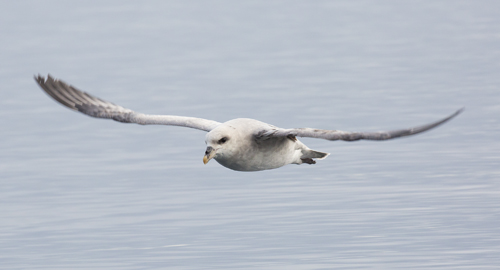
Day 2. We rounded the southern tip of Spitsbergen and headed east towards the pack ice. We had a great photo opportunity with Walruses, four sub-adult or teenage males lounging on a surprisingly small floe. We did at least a half-circle of the four, getting close enough to shoot animal-in-habitat wide-angle shots, without disturbing the animals. After forty minutes or so we backed off and continued, now northward to hug the eastern side of Spitsbergen.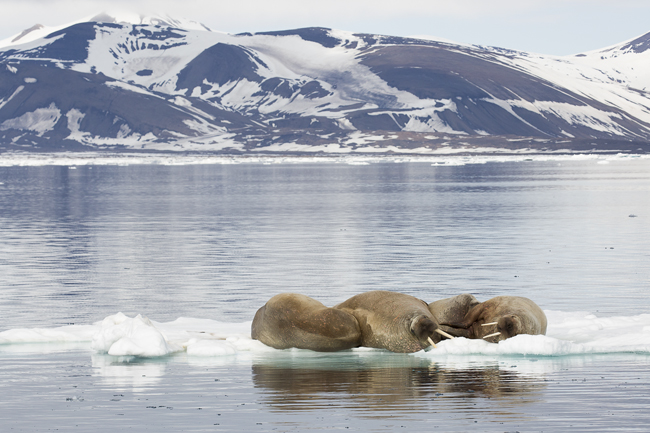
Mary spotted a distant Polar Bear swimming towards shore, which we could only enjoy from afar. The waters here were unchartered, so we couldn’t risk the ship, and the bear was too far away to think of using a zodiac. Still, it was our first bear!
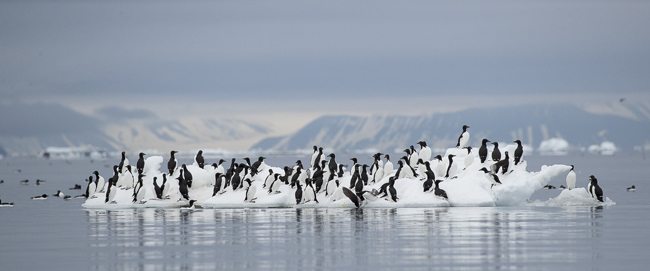
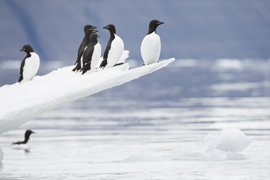 We motored on, in mirror-like waters, with occasional flocks of Murres streaming passed. We did a zodiac cruise in this magical setting, visiting an unnamed bird cliff with thousands of Brunnich's Guillemots. Birds by the dozens swam about, approached us, or perched on berger bits and small icebergs, making this a favorite day for some for the entire trip. As the afternoon drew to a close the weather closed in, with clouds forming, changing the temperature from the warm, sunny conditions we enjoyed since breakfast.
We motored on, in mirror-like waters, with occasional flocks of Murres streaming passed. We did a zodiac cruise in this magical setting, visiting an unnamed bird cliff with thousands of Brunnich's Guillemots. Birds by the dozens swam about, approached us, or perched on berger bits and small icebergs, making this a favorite day for some for the entire trip. As the afternoon drew to a close the weather closed in, with clouds forming, changing the temperature from the warm, sunny conditions we enjoyed since breakfast.
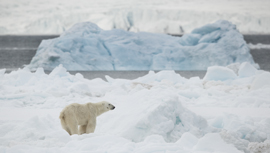 Day 3. At 2:40AM we were awakened by report of a bear. I was slow getting on deck and the bear was already a bit past peak, now walking parallel to the ship as it slowly meandered off. John K and several others got some great shots early on, with the Polar Bear standing amidst chunks of blue ice, but everyone got something – a fairly good bear for our first morning in the ice. We stayed with the bear until 4AM or so, when we decided the bear was too far away and would not return.
Day 3. At 2:40AM we were awakened by report of a bear. I was slow getting on deck and the bear was already a bit past peak, now walking parallel to the ship as it slowly meandered off. John K and several others got some great shots early on, with the Polar Bear standing amidst chunks of blue ice, but everyone got something – a fairly good bear for our first morning in the ice. We stayed with the bear until 4AM or so, when we decided the bear was too far away and would not return.
As we motored on through the morning we saw several more bears, bringing our count to 9 by lunch. The afternoon cruising took us through  incredible ice fields. We had one pup Ringed Seal that slugged itself across the ice as our ship approach, before slipping into the water. I ran out with my 800mm, but stupidly, I was still set on video and hand-held the 800 on a moving boat at a crawling seal at 1/60th sec. The images were not sharp … but not too bad for a trip report or our end of trip portfolio.
incredible ice fields. We had one pup Ringed Seal that slugged itself across the ice as our ship approach, before slipping into the water. I ran out with my 800mm, but stupidly, I was still set on video and hand-held the 800 on a moving boat at a crawling seal at 1/60th sec. The images were not sharp … but not too bad for a trip report or our end of trip portfolio.
Through the day Mary spotted 3 bears, I had 2, and Adam, one of our guides, had none. However, after dinner Adam redeemed himself in spades.
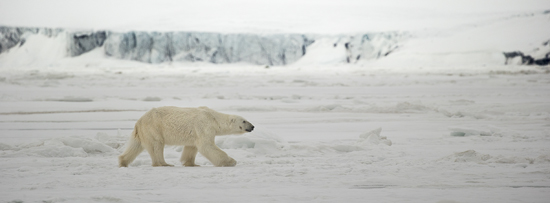
He spotted a distant bear that seemed inaccessible, with pack ice and ice floes between us, but our captain slowly and carefully plowed through, and got quite close to the bear. At first we were afraid it was shy, as the bear 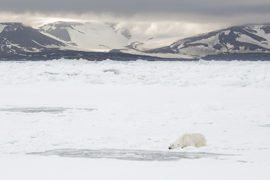 got up and walked away, but it ended up settling beside a small open lead where it lay down, facing the water and presumably waiting for a seal. We stayed with the bear until midnight, when it finally walked off. We had the bear for 3.5+ hours.
got up and walked away, but it ended up settling beside a small open lead where it lay down, facing the water and presumably waiting for a seal. We stayed with the bear until midnight, when it finally walked off. We had the bear for 3.5+ hours.
Getting to sleep was tough, and no one fell asleep before 2AM.
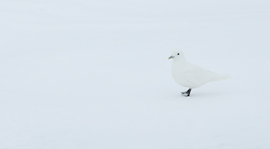 Day 4. Nothing showed up during the night giving us a short but quiet night. After breakfast Andreas, our other guide, spotted a bear again, which he thought was our bear from last night. The bear was far out but, almost as expected, he ambled in towards us. It was our bear from last night, distinctive with a spot on his cheek, and again it was very tame. We moved in close and watched as the Polar Bear dug into the snow, sometimes hopping up and down as if to crash into a seal den, and frequently pausing to eat snow. At one point he walked to the front of the ship where he entered the water, butt first, and disappeared beneath the ice. He stayed under for about one minute, surfacing at a different opening, diving again, and finally crawling out, shaking, and circling the boat. The bear investigated more leads, finally moving off and ending our shoot. We had the bear for a bit over an hour.
Day 4. Nothing showed up during the night giving us a short but quiet night. After breakfast Andreas, our other guide, spotted a bear again, which he thought was our bear from last night. The bear was far out but, almost as expected, he ambled in towards us. It was our bear from last night, distinctive with a spot on his cheek, and again it was very tame. We moved in close and watched as the Polar Bear dug into the snow, sometimes hopping up and down as if to crash into a seal den, and frequently pausing to eat snow. At one point he walked to the front of the ship where he entered the water, butt first, and disappeared beneath the ice. He stayed under for about one minute, surfacing at a different opening, diving again, and finally crawling out, shaking, and circling the boat. The bear investigated more leads, finally moving off and ending our shoot. We had the bear for a bit over an hour.
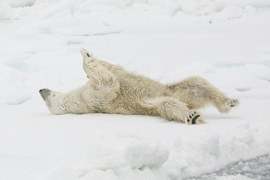
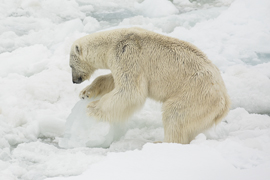
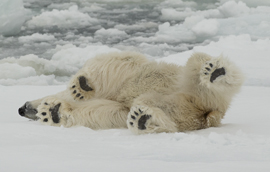
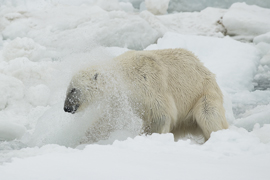
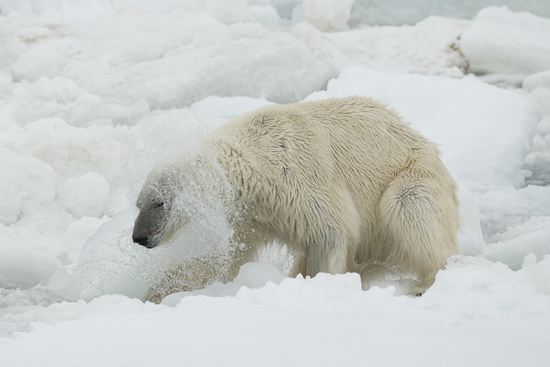
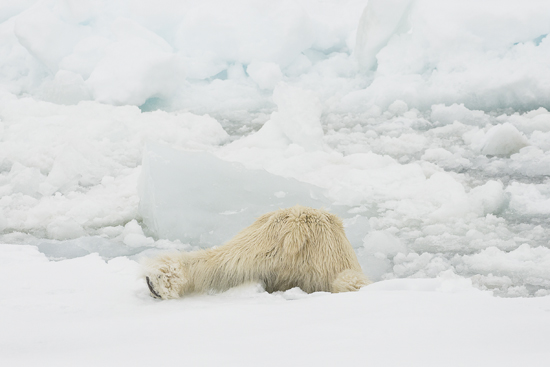
We continued on, but somehow our route brought us to our Polar Bear again. The bear was walking along the edge of the pack ice, giving us great side views, with a huge glacier face far in the background. Eventually our progress was stopped by a U curve in the ice, and the bear continued on. It was time for a late lunch.
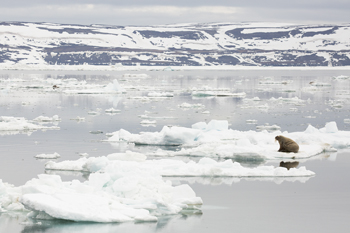 After lunch we had another Walrus lounging on ice. The Walrus was surrounded by formations of berger bits, and the water was still enough for fair reflections. We moved in to near frame-filling distance, with the Walrus occasionally rising to look at us, or roll over, or scratch with a hind flipper. Exhausting all angles, we moved on, now 3:25PM.
After lunch we had another Walrus lounging on ice. The Walrus was surrounded by formations of berger bits, and the water was still enough for fair reflections. We moved in to near frame-filling distance, with the Walrus occasionally rising to look at us, or roll over, or scratch with a hind flipper. Exhausting all angles, we moved on, now 3:25PM.
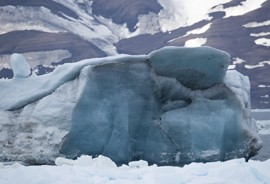
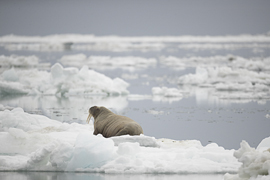
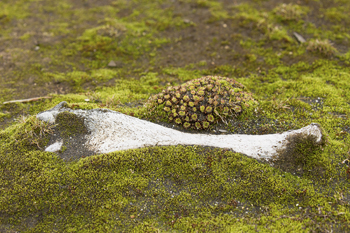 Day 5. We headed towards Freeman Strait, where we hoped to enter the sea on the eastern side of the Svalbard archipelago. This is an area of strong tidal forces, and the loose ice, which we plowed through nearly continuously, finally stopped us and we had to do a U-turn, to begin to head to the southeast. This route brought us to a Walrus haul out, along a beach that we visited on our first trip on the Stockholm.
Day 5. We headed towards Freeman Strait, where we hoped to enter the sea on the eastern side of the Svalbard archipelago. This is an area of strong tidal forces, and the loose ice, which we plowed through nearly continuously, finally stopped us and we had to do a U-turn, to begin to head to the southeast. This route brought us to a Walrus haul out, along a beach that we visited on our first trip on the Stockholm.
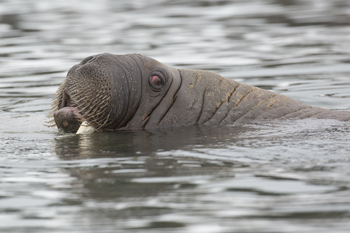
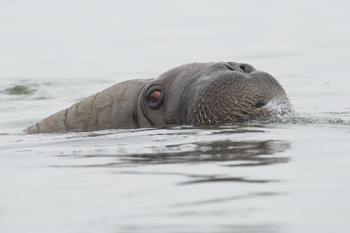
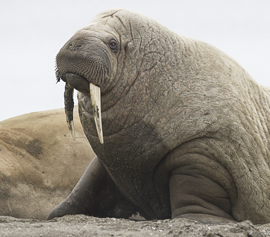
A dozen or more Walrus lounged on the beach and we approached slowly and noisily, giving the resting Walruses time to hear and see us, and thus avoid a panic to the sea. A heavy, low cloud cover dropped the light levels quite low, making video shooting the best option, although these massive animals were still and an easy shoot with stills. At one point a Parasitic Jaeger harassed a Black-legged Kittiwake, the conflict announced by keening cries from the gull.
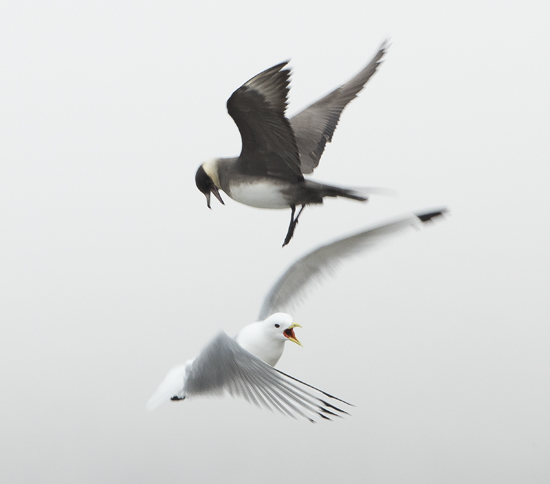
It was quite a dogfight, which I missed, as my lens hood was still reversed on my 100-400mm and I couldn’t zoom out in time. Mary got some nice shots and Judy, who took her lens off the tripod to follow the action, captured the entire sequence wonderfully. She was using the Tamron 150-600mm and she reported that the AF kept up just fine! We returned to the boat for a later than normal dinner, and afterwards continued a short distance before anchoring for the night, giving us a quiet, still night’s sleep.
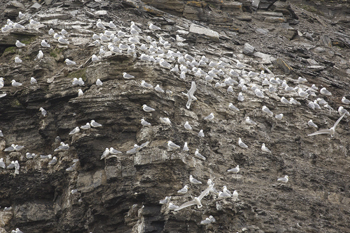 Day 6. We left the ship at 6AM today to visit an incredible Black-legged Kittiwake nesting colony that clad both sides of a steep canyon in a snow-like cover of birds. As we approached the black slit the first glimmer of birds became visible, like tiny specks of white dust swirling about, flicking and disappearing as wing positions changed. As we drew closer the sight grew only more impressive, swarms of birds swirling against the cliff face. The viewing would only get better.
Day 6. We left the ship at 6AM today to visit an incredible Black-legged Kittiwake nesting colony that clad both sides of a steep canyon in a snow-like cover of birds. As we approached the black slit the first glimmer of birds became visible, like tiny specks of white dust swirling about, flicking and disappearing as wing positions changed. As we drew closer the sight grew only more impressive, swarms of birds swirling against the cliff face. The viewing would only get better.
We had to land with a high tide because of the shallow waters, and today the sea was the roughest we’ve had. Disembarking from the ship onto the zodiacs was the most challenging to date, but nothing at all compared to Antarctica, and everyone boarded safely. Landing was fairly easy, too, as the breakers we feared didn’t materialize.
The canyon was about 1 km away over surprisingly soft ground, covering a route that took us uphill onto an older beach, one raised by isotonic forces as the land recovered from the weight of past glaciers. During the ice ages, glaciers actually pushed the land down, and now that land is ‘springing’ back. Andreas said the record spring back is in Sweden, with 11mm a year gain in elevation.
One lone, bull Svalbard Reindeer grazed on an eroded terrace of green, reminding me of a Bali rice field. The Reindeer was quite tolerant, providing frame-filling shots before climbing a snow bank and disappearing from sight.
Overhead, as we entered the narrow canyon, Kittiwakes swirled in a near chaotic flight display, as birds returned to their nest sites with gobs of moss or mud, or simply wheeled about in the air.
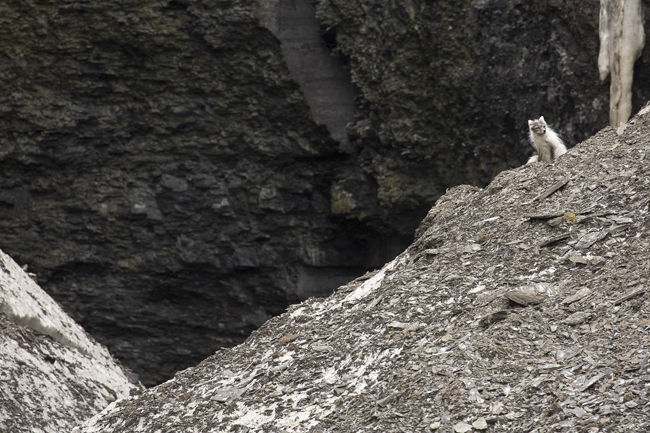
One of what would be at least six Arctic Foxes passed by us as we hiked towards the Canyon. The first carried the remains of a Kittiwake. Soon after, another passed.
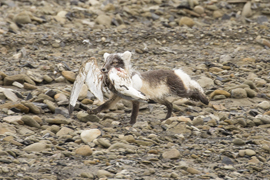
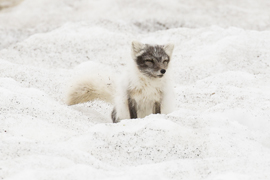
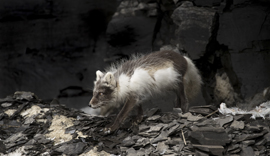
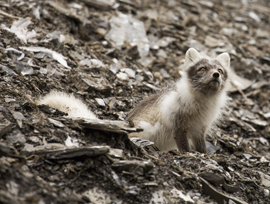
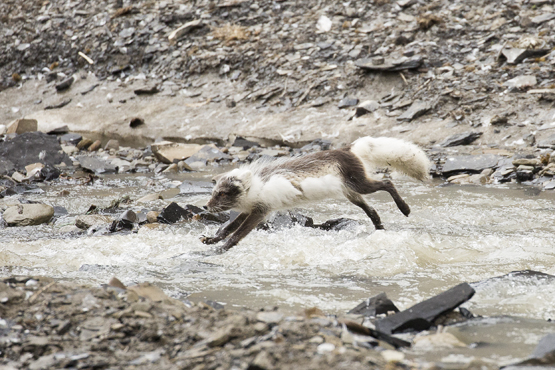
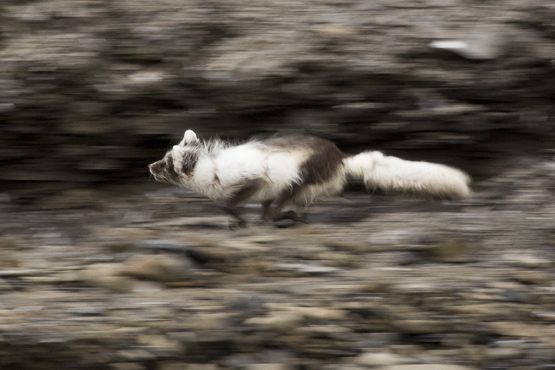
Three or four Arctic Foxes visited the canyon, sometimes walking, trotting, running, or sitting just meters from us. All were in molt, with patches of white fur sticking out, all akimbo, prompting Suzanne to ask if they fluff out their fur like a bird might with its feathers. We stayed until 9AM, when we returned to the zodiacs and struggled mightily to push these heavy craft into water deeper enough for floating. The seas were far smoother when we returned to the ship.
Our plans changed, and we headed back across the straight towards the fast ice lining the eastern shore of the western island, hoping for more bears. En route we had a great Bearded Seal and another young Walrus, both tolerating our ship and not slipping into the sea when we finally left them.
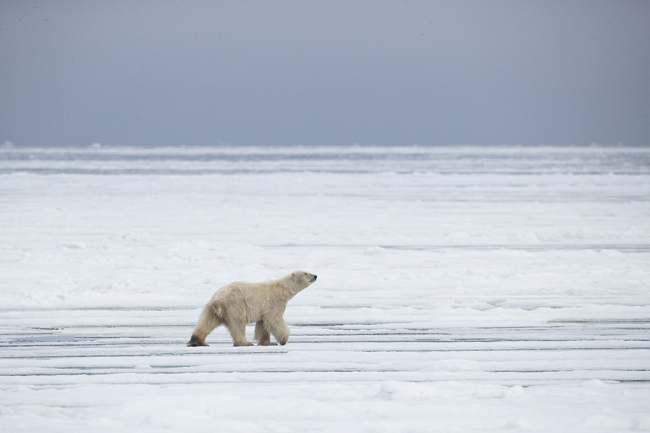
Around 6:30PM we had another Polar Bear, a brown-colored male, stained and muddy from his time ashore and his feet looked as if they were wearing boots. We were in fast ice that was now floating free, creating a flat vista of winding strips of white ice broken, in a series of ribbons, by melt water pools. From an upper deck the patterns were exquisite, extending to a horizon of dark, nearly black clouds. For me, this was the most iconic image of a bear on polar ice. We paralleled the bear for nearly an hour, although the bear always kept some distance between us. Several times it swam between small stretches of open water or fell through soft ice, scrambling up to another landing.
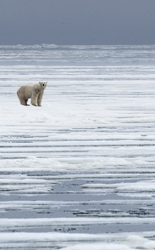
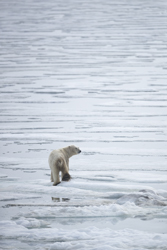
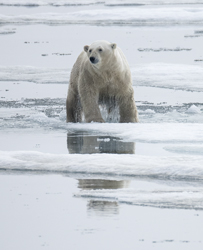
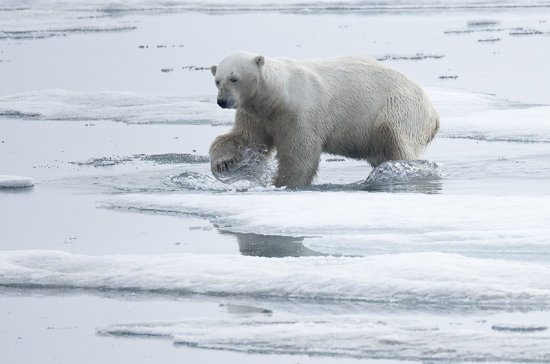
Finally, having crossed in front of the ship and wandering far to our right, we left the bear – now a distant speck – and went to dinner.
Several of us watched the Stockholm classic, ‘An Enemy to Die For,’ a WWII story that was filmed in Svalbard on the Stockholm. Now 11:30PM most of us went to bed, but within an hour we had the call of another Polar Bear. This one, a female, had been located by the ship’s radar, as we were stationary and the ice flat, and its progress was marked as a snaking green line leading toward the boat. Fog had settled in and the images were faint and ethereal, white bear in a white-out fog, and soon the bear wandered off, vanishing in the whiteness.
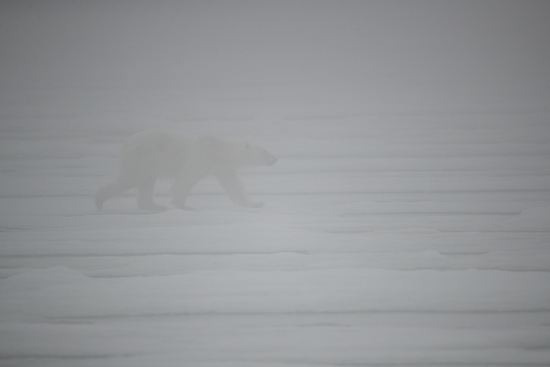
Day 7. We stayed in the ice, 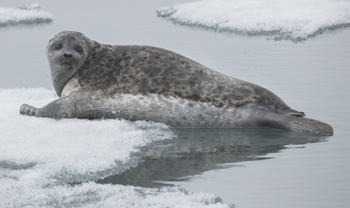 searching continuously for bears. Fog came and went, sometimes restricting our visibility terribly and sometimes lifting to give long views of ice extending to the horizon or the distant mountains of Svalbard. We had several Walruses and a few Bearded Seals, and an excellent Ringed Seal that apparently scooted away from its escape hole, leaving it stranded on the pack ice. The fog had cleared sufficiently that we had fairly good visibility for bears, and hoping that one would see our seal we remained within sight of the Ringed Seal for several hours. No bear appeared, and eventually we moved on.
searching continuously for bears. Fog came and went, sometimes restricting our visibility terribly and sometimes lifting to give long views of ice extending to the horizon or the distant mountains of Svalbard. We had several Walruses and a few Bearded Seals, and an excellent Ringed Seal that apparently scooted away from its escape hole, leaving it stranded on the pack ice. The fog had cleared sufficiently that we had fairly good visibility for bears, and hoping that one would see our seal we remained within sight of the Ringed Seal for several hours. No bear appeared, and eventually we moved on.
Day 8. After breakfast we did a zodiac excursion where we hoped, once again, to get close to Red Phalaropes, the polyandrous shorebird. Females are brightly colored, and promiscuous, mating with a male, laying eggs, and leaving the male to incubate and care for the chicks while she finds another male, repeating the process several times during the nesting season. We saw one, distantly, but it flew off.
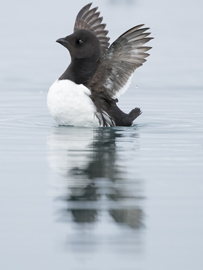
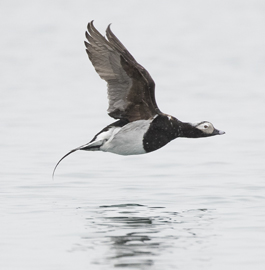
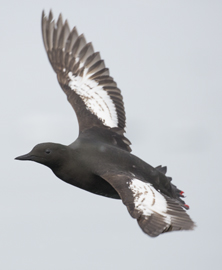 Dovekie; Long-tailed Duck; Black Guillemot
Dovekie; Long-tailed Duck; Black Guillemot
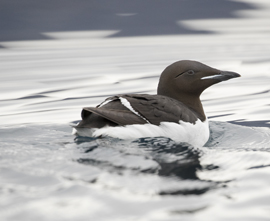
King Eider; Brunnich's Guillemot
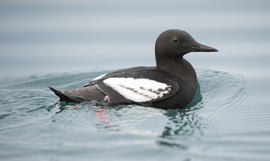
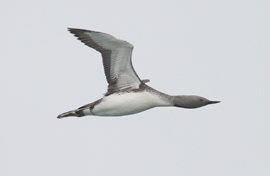
Black Guillemot; Red-throated Loon
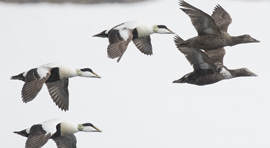
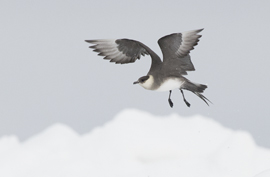
Common Eiders; Parasitic Jaeger
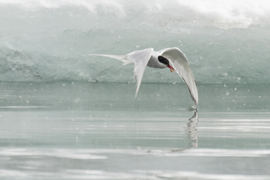
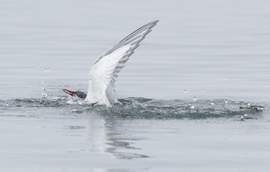
Arctic Tern
We did, however, encounter several King Eiders, and we got the closest I think we’ve ever been, following one pair that simply swam parallel or ahead of us, and never took flight. We also had great luck with Oldsquaw Ducks, now called the Long-tailed Duck, as the male sports a long, spine-like tail feather. Parasitic Jaegers flew by and perched on ice, allowing close approaches, and a pair of Dovekies, or Little Auks, were the tamest I’ve ever seen, giving us near frame-filling shots. Likewise, we had a very tolerant Black Guillemot, and several Arctic Terns that permitted very close approaches. We ended the nearly four hour zodiac ride with three Atlantic Walruses hauled out on the pack ice.
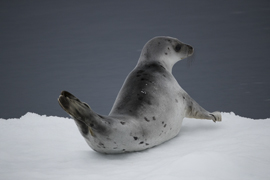 We spent the rest of the day cruising through ice, looking for bears. At 1AM Andreas knocked on our door, informing me that there were hundreds of ‘Greenland’ Seals, the Norwegian name for Harp Seals. I went on deck to check it out, but the seals were far off and I didn’t wake everyone immediately. Judy was already shooting – she started at 11PM to shoot the magic color of a western sky and ice. The seals were tolerant, and I had Andreas wake everyone. We spent over an hour with the Seals, many of which allowed frame-filling approaches.
We spent the rest of the day cruising through ice, looking for bears. At 1AM Andreas knocked on our door, informing me that there were hundreds of ‘Greenland’ Seals, the Norwegian name for Harp Seals. I went on deck to check it out, but the seals were far off and I didn’t wake everyone immediately. Judy was already shooting – she started at 11PM to shoot the magic color of a western sky and ice. The seals were tolerant, and I had Andreas wake everyone. We spent over an hour with the Seals, many of which allowed frame-filling approaches.
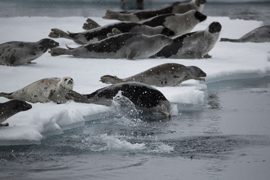
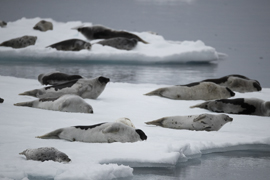
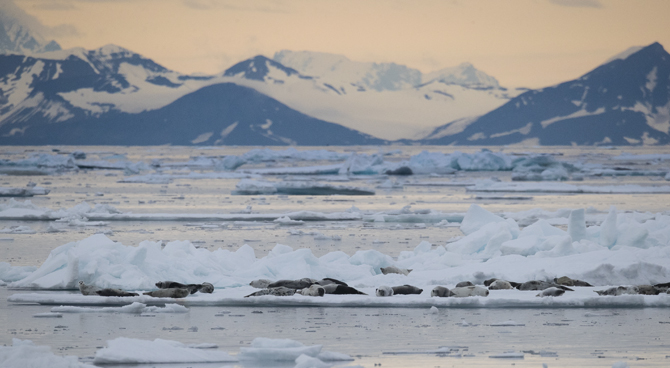
Day 9. We spent the morning cruising through ice-free waters towards the southern point of Svalbard, rounding the point and entering the southernmost large fjord in the late afternoon. The scenery was stunning, and the cloudless skies afforded magnificent lighting. At 5 we did a zodiac cruise to a landing below a towering bird cliff, and soon after encountered a pair of Parasitic Jaegers that were nesting nearby, and curious. The birds were fearless and allowed close approaches, with many of us crawling on  our belly over the cobbled rocks for a subject-level perspective.
our belly over the cobbled rocks for a subject-level perspective.
The beach scenery was outstanding, with huge eroded boulders forming globular sea stacks, framed by the distant mountains and, up close, by tidal pools. Kittiwakes swirled above us several times, and high overhead the air was filled with birds around the cliffs. We wore shirts or vests – the weather was warm, and we did several portraits of everyone against the incredible backdrop.
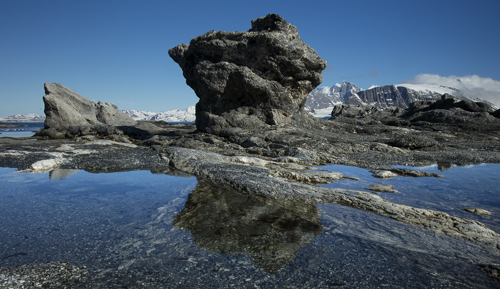
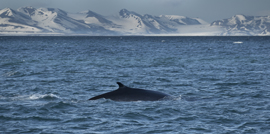 After dinner, as we headed back into the open sea we had a mother Fin Whale and calf. They did their blows several times, and Sherry, at least, got a great shot of the two with the mountains in the background.
After dinner, as we headed back into the open sea we had a mother Fin Whale and calf. They did their blows several times, and Sherry, at least, got a great shot of the two with the mountains in the background.
Day 10. Our last day and one we expected to be anticlimactic. It was not. We had planned to visit a bird cliff at ‘The Horn,’ a destination Mary and I visited on our first scouting trip to Svalbard. Back then, our 50 pax ship had us unloaded at a site where a small cabin was located, and a long, soggy, exhausting and ultimately unproductive hike ensued. We were not looking forward to the landing. Fortunately, another ship preempted us, and we changed our plans, doing a zodiac cruise around a glacier. We had more King Eiders, Common Eiders, Arctic Terns, and a great landing on a gravel bar where, finally, we had everyone for a group photo. The weather was beautiful, sunny but cooler than expected.
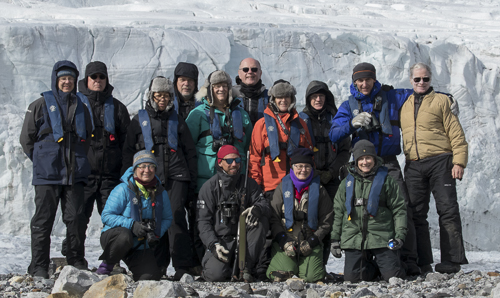
After lunch we headed to The Horn, but this time we landed on a small beach directly below the bird cliffs. After a scramble up a steep cut in the cliff bank we were on relatively level ground, soggy as this was wet tundra. Svalbard Reindeer grazed nearby, and eventually one of the bulls walked directly to and passed me. Soon after, Bill spotted an Arctic Fox, and Adam a few minutes later spied their den.
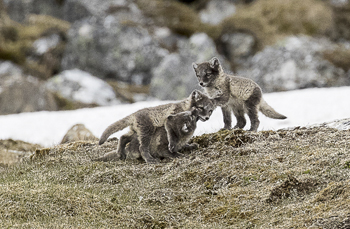
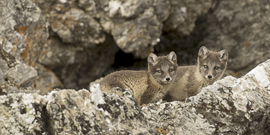 Seven pups played nearby, in small groups that originally made guessing the actual number of pups a challenge. The plans were, originally, to do a short landing, return to the ship, and be refueled, but while we were on ashore the captain took off, did the refueling, and leaving us with an entire afternoon to spend, as we slowly creeped in closer to the den. We got reasonably close (I’d have loved to be even closer since we only had 400mm), but at the distance we had the image size was OK and, most importantly, the pups were carefree. We finally left when we thought they were finished and napping, but as we carefully retreated they began to play again. We left them anyway, with a few pups sitting at the den entrance (a slit in the rock pile) watching us go. Bill shot over 64gb, and I did close to that between the Reindeer and the foxes. It was a great way to end.
Seven pups played nearby, in small groups that originally made guessing the actual number of pups a challenge. The plans were, originally, to do a short landing, return to the ship, and be refueled, but while we were on ashore the captain took off, did the refueling, and leaving us with an entire afternoon to spend, as we slowly creeped in closer to the den. We got reasonably close (I’d have loved to be even closer since we only had 400mm), but at the distance we had the image size was OK and, most importantly, the pups were carefree. We finally left when we thought they were finished and napping, but as we carefully retreated they began to play again. We left them anyway, with a few pups sitting at the den entrance (a slit in the rock pile) watching us go. Bill shot over 64gb, and I did close to that between the Reindeer and the foxes. It was a great way to end.
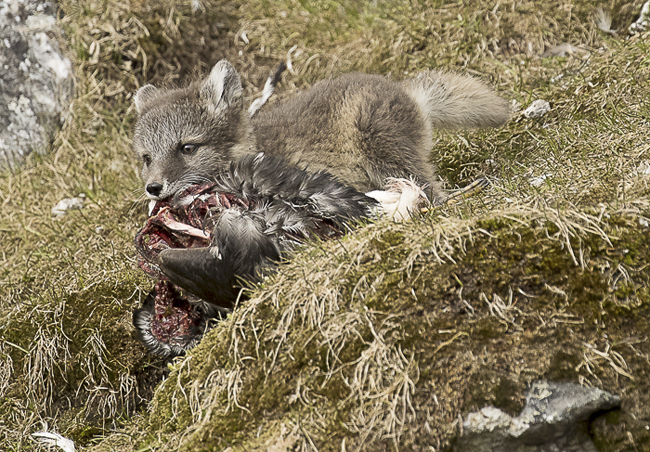
That evening we did highlights, which were as diverse as the trip itself, and reviewed favorite shots, locations, etc. We ended with a 470 image slide show, put together rather quickly since the afternoon was spent with foxes, not computers, but the images were great and many of the boat crew sat in to watch. Don put together a short video movie, featuring foxes and bears, as a bonus. The show as a wonderful, great conclusion to a very productive trip.
Day 11. We left the ship at 10, headed to the Radisson for an hour (spent shopping for many), and boarded the bus for the airport promptly at 11. The flight to Oslo went smoothly, and with a pizza dinner at the airport we said goodbye to everyone, as Tom, Don, and Judy were off to northern Norway and Suzanne had an early flight. It was sad to see everyone go.
Why you should travel with us
Testimonials
Read an Interesting Interview with Joe
Read the latest Interview
New Question of the Month!
New Tip of the Month!
Join us on Facebook at: Follow Hoot Hollow
Office Phone: (717) 543-6423
Or FAX us at: (717) 543-5342
Mary and Joe are proud to endorse the Photo Retailer that has
done the absolute most in supporting nature photography in all
its facets ---

Check out their Monthly Specials


Trip Report:
Svalbard - Polar Bears
and the Wildlife and Birds -
Photo Tour
2017
Check out the 5 minute video on
Svalbard's wildlife photography
opportunities -- filmed on these
two trips in 2017.
Check out our 2019 Brochure
for our next trip to Svalbard!
 This was our fifth visit to Svalbard, an island archipelago far above the Arctic Circle, and our two trips this year were perhaps the best yet. Encompassing the first three weeks in June we arrived when snow still covered most of Longyearbyen, the largest town in Svalbard, and the hillsides and mountains throughout the islands. During our three weeks we watched, in near astonishment, as the snow covered disappeared, as did much of the 'fast' ice lining the shorelines and glacier bays. By the end of our trip the temperature in Longyearbyen was 42 degrees, ten more than when we had arrived.
This was our fifth visit to Svalbard, an island archipelago far above the Arctic Circle, and our two trips this year were perhaps the best yet. Encompassing the first three weeks in June we arrived when snow still covered most of Longyearbyen, the largest town in Svalbard, and the hillsides and mountains throughout the islands. During our three weeks we watched, in near astonishment, as the snow covered disappeared, as did much of the 'fast' ice lining the shorelines and glacier bays. By the end of our trip the temperature in Longyearbyen was 42 degrees, ten more than when we had arrived.
The wildlife viewing and photography was truly spectacular. While everyone's hopes and primary focus are on Polar Bears, Svalbard offers a wide variety of Arctic species and this year we did exceptionally well with all. We had great photo opportunities with Atlantic Walrus, Bearded Seals, Northern Fulmars, Eiders, Brunnich's Guillemot and Black Guillemots, and more.

Northern Fulmar
This year we did two trips, our 'normal' seven day tour and a special ten day trip. For both, we headed south, rounding the southern end of Spitsbergen (the main island) and entering the Storfjorden Strait or sea, heading towards Edgeoya, the largest island in the south east and near to one of the Polar Bear nursing grounds. Pack ice from even further north had blown and drifted south, blocking the northern route around Svalbard -- which was just fine for us. The wildlife in the south is fantastic, as our experiences so richly showed. We had plenty of Polar Bears - 16 on the first trip, 13 on the second. As on almost all trips,

Bearded Seal
I've included both Trip Reports here -- so if you'd like to only read Trip Two's report, just scroll down, but you'll miss some great images if you do so! At any rate, here's the reports


Bearded Seal; Northern Fulmar
Trip 1


Day 1. We arrived in Svalbard without incident. Several of us had purchased ‘extended’ or premium-style tickets that gave us first-boarding rights for the connection from Oslo to Svalbard. Consequently, the worry about getting carry-on luggage was averted.

Barnacle Goose
We arrived to a cold but sunny Longyearbyen. Snow carpeted the hillsides, and in most of the long, flat stretches of floodplain or coastal plain the land was covered with more than 50% snow. Mary and I rented vehicles for an afternoon game-drive with the group, and checked out both the dog-sledding area, where Eider Ducks nest, and the coal-mining hillside, where Svalbard Ptarmigan, a subspecies of Rock Ptarmigan, can be found.
 The Eider colony was not as crowded as it was two years ago, at least to our recollection, but we still had dozens of pairs of ducks on nests and numerous, brightly colored males swimming about, tossing their heads back periodically to give a call, ‘ah-whooo’, a gentle moaning purr. Parasitic Jaegers, the principle bird of prey of the islands, circled periodically, swooping down to harass a duck and, hopefully, to steal an egg. We saw none succeed. The sun was behind the birds, making the shooting somewhat contrasty, but that soon changed. A sea fog had drifted in, making the light dull and the roadside shooting somewhat dangerous, as trucks and vehicles materialized out of a gray white-out like condition without warning. The fog chilled, too, and so we headed back towards town and higher elevations to look for Ptarmigan.
The Eider colony was not as crowded as it was two years ago, at least to our recollection, but we still had dozens of pairs of ducks on nests and numerous, brightly colored males swimming about, tossing their heads back periodically to give a call, ‘ah-whooo’, a gentle moaning purr. Parasitic Jaegers, the principle bird of prey of the islands, circled periodically, swooping down to harass a duck and, hopefully, to steal an egg. We saw none succeed. The sun was behind the birds, making the shooting somewhat contrasty, but that soon changed. A sea fog had drifted in, making the light dull and the roadside shooting somewhat dangerous, as trucks and vehicles materialized out of a gray white-out like condition without warning. The fog chilled, too, and so we headed back towards town and higher elevations to look for Ptarmigan.


A pair of Parasitic Jaegers
hunted above the Common Eider colony.
At one point the two paused for equally important business.
We found one pair of these grouse relatives. Although they appeared further away than I’d like, I was surprised at the image size captured by those who photographed the birds. It was decent. The birds moved across a small ridgeline above us, with the female, although clearly within sight, being nearly invisible with her cryptic coloration, lines of black on a rock-colored brown/gray ground color. The male, clad completely in white, stood out conspicuously, with only a small red crest above the eye breaking up his form.

Pink-footed Geese
After dinner, stuffed uncomfortably, several of us went for a walk, discovering a pair of Pink-footed Geese in an open lot quite close to the road. They were the best I’ve seen for photo opportunities, and Cindy  headed back for her camera. The rest of us continued, but a pair of Barnacle Geese, striking in the clear late afternoon light, was too much.
headed back for her camera. The rest of us continued, but a pair of Barnacle Geese, striking in the clear late afternoon light, was too much.
(Eider Duck, left)
We headed back for our cameras, too, and the van, to make the trip a bit easier.
The birds had retreated to less favorable spots by the time we returned, and so we headed back to the dog sled area, hoping that the light had swung around and now faced the birds, as the fog had lifted. It had, and we had some decent shooting of both Eiders and Barnacle Geese before we called it a day.
 Day 2. We had a 7AM breakfast – the earliest the hotel’s restaurant served – before returning to the dog sled area for eiders. The day began windy and sunny, with rain forecasted for later, and while we photographed the light gradually softened and died. Although windy, few birds flew about and the shooting was only marginal. We headed for the ptarmigan area but we were unable to find another pair of these striking birds.
Day 2. We had a 7AM breakfast – the earliest the hotel’s restaurant served – before returning to the dog sled area for eiders. The day began windy and sunny, with rain forecasted for later, and while we photographed the light gradually softened and died. Although windy, few birds flew about and the shooting was only marginal. We headed for the ptarmigan area but we were unable to find another pair of these striking birds.
 In the afternoon after a great pizza lunch we headed to the museum where our guide, Adam, gave a short talk on some of the subjects we’d be shooting, as well as a synopsis on the whaling and early settling of the islands. At 4PM we headed to our ship, boarding and squaring ourselves in the cabins before heading out to sea. An exciting bonus was a Blue Whale, the largest mammal on earth and, most likely, the largest animal to ever live. Hunted to near extinction, their numbers are still low, and the whales are rare here.
In the afternoon after a great pizza lunch we headed to the museum where our guide, Adam, gave a short talk on some of the subjects we’d be shooting, as well as a synopsis on the whaling and early settling of the islands. At 4PM we headed to our ship, boarding and squaring ourselves in the cabins before heading out to sea. An exciting bonus was a Blue Whale, the largest mammal on earth and, most likely, the largest animal to ever live. Hunted to near extinction, their numbers are still low, and the whales are rare here.

Day 3. We cruised through the night – or what should be night if the sun would set – and arrived at the fjord towards the southern tip of Svalbard, Storfjorden. At 9:30 we did a zodiac cruise along the glacier front, looking for birds and seals. It was dreary and a light drizzle dampened us, before the rain turned to hard, BB-sized balls of hail. Some of the shooters had some nice encounters with Murres and Arctic Terns, and although very far off, our first Arctic Fox. Adam spotted the fox as it ran across the fast ice (ice that stays attached to the shoreline and remains ‘fast’ until it melts in summer), which then ran along the shoreline before speeding its way up the steep hillside. The fox’s upward climb was fast, and most impressive.

After lunch we explored deeper into the fjord where, at the terminus of more fast ice at the foot of another glacier, Adam and Mary spotted a very, very distant Polar Bear. Mary thought she saw it standing, and later Adam was fairly positive we had a bear, which Jim later confirmed when we used his 800mm, 1.25X converter, 1.6X crop-factor camera, and zoomed in on the LCD to make out a Bear lying on her side. A later shot revealed that she had three Cubs. Unfortunately the bear remained far away and after a bit of waiting it shoved off from the ice and continued south, to eventually clear the southern tip of the island and hit open sea, on our way to the birthing grounds of the Polar Bears on the pack ice. Regarding the ice – Satellite imagery revealed that the pack ice had been far north of the islands in the early part of the year. If that had continued, we’d have had to travel much  further north to encounter ice, and bears.
further north to encounter ice, and bears.
(Glaucous Gull, left)
Fortunately, though, by March the weather always seems to shift, and now, in early June, the entire top of Svalbard is encased in ice, making passage there impossible. The pack ice swept down the eastern side of the archipelago, extending south past the southeastern island and into the birthing grounds. That’s where we’re heading, and here, either tonight in the early AM hours of tomorrow, or tomorrow morning, we’ll be cruising along the edge of the ice fields, hoping to find bears.

Bearded Seal
Day 4. During the night we hit the ice, the sound of small berger bits and floes crashing against the bow and sides of our reinforced ship waking us from sleep. Half-alert for the knock and call, ‘bears!’ we dozed until 6 to a sunny, cloudless sky without a trace of wind. We spent the day passing through one stretch of ice pack into another, until towards Edgeoya Island, the large island landmass in the southeast section of the archipelago, we moved continuously through the ice pack. We had two Bearded Seals, one quite oblivious to us while the other, in brilliant light, eventually scooted into the sea – making for a nice motor-drive sequence. 
Bearded Seal
Mary and Bill both made it up into the Crow’s Nest, a mini-adventure for both, and Adam and Marty, our guides, spent a total of 5 hours there, fruitlessly searching for bears. We did a zodiac ride through the ice fields, giving everyone great opportunities to photograph our ship, the Stockholm, amidst the ice, and a few chances at Greater Black-back Gulls and the 

Brunnich's Guillemot; Black Guillemot
Murres, or Guillemots, that passed by. Our guides beached our zodiacs on a large ice floe, where we took a group photo and shared a large bar of chocolate, topping off our afternoon.
In the late afternoon we headed up the western side of the island through Storfjorden, the bay separating Edgeoyoa from Spitsbergen. The western shoreline was beyond the horizon line but despite the vastness of this sea the water was pond-like, perfectly still except for the V-shaped wake our ship created. Northern Fulmars began to follow the ship, and when gliding low, less than a body width above the water, their reflections were nearly perfect. Adam was about to give a lecture when the shooting got good, and so we cancelled the talk for productive shooting that continued until dinner. Afterwards, we continued cruising north, with the water now marred by a light breeze, erasing the earlier magic.
Northern Fulmar
 Day 5. In the early AM hours we reached more pack ice, and around 4AM Adam knocked on our doors to inform us that a Polar Bear had been spotted. We dressed, woke everyone up, and got on deck while the bear was still quite far away. The bear, a large male, was sleeping, but as we approached he awoke and, with weaving, almost snake-like movements of his head, inspected us, but soon fell back to sleep. Our ship pressed into the same ice floe, far enough away as to not disturb the bear, and periodically the bear would awake, check us out, or scratch, or look away towards a distant horizon, then drop back to sleep. We hoped that when it did finally get up it would inspect us more closely, but when the bear finally rose he walked along the ice edge, then turned, and delicately backed into the water before turning and swimming, ignoring other floes where he could have come to rest and instead disappearing into a gray gloom as fog descended on the sea.
Day 5. In the early AM hours we reached more pack ice, and around 4AM Adam knocked on our doors to inform us that a Polar Bear had been spotted. We dressed, woke everyone up, and got on deck while the bear was still quite far away. The bear, a large male, was sleeping, but as we approached he awoke and, with weaving, almost snake-like movements of his head, inspected us, but soon fell back to sleep. Our ship pressed into the same ice floe, far enough away as to not disturb the bear, and periodically the bear would awake, check us out, or scratch, or look away towards a distant horizon, then drop back to sleep. We hoped that when it did finally get up it would inspect us more closely, but when the bear finally rose he walked along the ice edge, then turned, and delicately backed into the water before turning and swimming, ignoring other floes where he could have come to rest and instead disappearing into a gray gloom as fog descended on the sea.
Most of us went back to bed – it was now 6AM, but soon afterwards we had our first Walruses. A female and a calf lay on a floe, and most of us got a few shots – through a masking veil of fog – before the two slid into the sea. After breakfast we had another, who also retreated quickly, and at 11AM we had two more, who did the same.
 Throughout the day we had a few more Walruses and Bearded Seals but the shooting was marginal as we had a thick fog through most of the day. Our journey took us through and along pack ice all day, perfect country for bears and walruses, but the visibility was very limited. We did have Polar Bears – a mother with two cubs running across a distant ice field, and a male that, unfortunately, we surprised up close and who then ran off. We tried waiting in the ice, our ship held fast by pack ice, for the mom and cubs to approach us out of curiosity, but none did. Between some birds, some Walruses, and some Bearded Seals we had a nice day, but we fear we missed several chances at Bears that we simply missed in the heavy fog.
Throughout the day we had a few more Walruses and Bearded Seals but the shooting was marginal as we had a thick fog through most of the day. Our journey took us through and along pack ice all day, perfect country for bears and walruses, but the visibility was very limited. We did have Polar Bears – a mother with two cubs running across a distant ice field, and a male that, unfortunately, we surprised up close and who then ran off. We tried waiting in the ice, our ship held fast by pack ice, for the mom and cubs to approach us out of curiosity, but none did. Between some birds, some Walruses, and some Bearded Seals we had a nice day, but we fear we missed several chances at Bears that we simply missed in the heavy fog.

 Day 6. We began heading south, following the eastern shoreline of Spitsbergen island and the fast ice that hugged its shore. Our route had us in an ‘inland waterway’ between the fast ice and the thick band of pack ice further out to sea, although often we barreled through bands of ice that blocked the route, and pancake slabs. The day was crystal clear – a refreshing change from yesterday, and we had high hopes.
Day 6. We began heading south, following the eastern shoreline of Spitsbergen island and the fast ice that hugged its shore. Our route had us in an ‘inland waterway’ between the fast ice and the thick band of pack ice further out to sea, although often we barreled through bands of ice that blocked the route, and pancake slabs. The day was crystal clear – a refreshing change from yesterday, and we had high hopes.
Marty, up in the Crow’s Nest, spotted his first Polar Bear for this trip. A cubless female, she was lying by a seal hole hunting. We ‘parked’ our ship in the ice, with our captain pushing forward, backing up, and hammering deeper into the ice to close the distance, and, locked in ice, creating a stable platform for shooting once the engine stopped. The bear was doing nothing so everyone returned to editing or sleeping, as we hoped the bear would get curious. It did, and Adam, our head guide, rushed down to tell us that the bear was approaching, fast!



We hurried on deck and the bear did a direct, surprising rapid approach to our ship, eventually walking right up to the hull where, under the ship’s curves, it disappeared. We checked both sides of the ship to see where she went, finally discovering her on the same side she had approached, but now peering, one by one, into the ship’s portholes. At one point she stood up and sniffed the boat deck – her head level with my feet, but as I moved in for an intimate wide-angle she dropped back to the ice. She walked to the back of the boat, continuing along the water route we had just carved through the pack ice, and finally crossed that open water. Amazingly, the open water dotted by the blocks of broken ice had already begun to refreeze, and the bear had a stable series of steps or platforms as it walked across the slabs, keeping her balance and remaining dry as she crossed, and continued out onto the pack ice.

Though the remainder of the day we spent more time with three other Polar Bears that were hunting Ringed Seals far in the distance. One pair appeared to be only thirty yards or so from a Seal that remained on the ice despite the occasional head movements and foot-shifting of what we supposed was a hunting bear. Although we hoped one would approach, none did, and eventually we moved on.

Adam spotted another bear far in the distance. He suspected it was feeding on a seal – quite the assumption considering the mile-plus distance that separated us. It was close to dinner time and instead of approaching then, we had dinner – rapidly, then boarded zodiacs to attempt a water-level approach. Adam had cautioned us that bears are often tolerant of a big ship but fearful of zodiacs, the exact opposite that applies for Walruses, but expectations were high as the water-level possibilities were exciting.
We motored out, moving very slowly and, as we neared the bears, making a snaking approach, giving the bear time to see us and become accustomed. 

As we neared she rose – she had a COY (cub of the year) with her, and hissed a warning. She didn’t yawn or shake her head – usual signs of annoyance or aggression, but instead approached the edge of the ice floe, stopped, then turned and jogged to the opposite side of the floe, entering the water and swimming off. Her cub climbed aboard for a piggy-back ride, but too distant for a shot. We left her, hoping she’d return to what looked like an untouched kill and hoping that she’d be more tolerant of the ship when we returned later.

Prior to our reaching the bear I had suggested that our photographers go to the front of the ship in case our approach spooked the bear again. Jim and Mary did go to the front, but everyone else, hoping for a lower angle, stayed on the lower deck. I was the last in line there, and had a miserable view, and as no one else chose to move up, I did, taking an open position at the front. It was a much better viewpoint.

Although the ship didn’t move, and no one did anything to prompt a change, the bear eventually stopped feeding and reentered the water. Her cub followed, but instead of climbing upon mom’s back the cub just swam behind, the two of them moving away from us and rapidly retreating. We left them, backing up to give the bears some room, and resumed our journey south. We passed the bears, still swimming, although we suspect they’ll return to the kill. If they did not, other bears would soon find the stinking carcass.

For the record, both our guides and the captain felt poorly about the bears leaving the kill. Our approach by zodiac was text-book correct, slow and meandering and everyone silent and still, and the bear gave no indication of annoyance – they’ll usually yawn as a distraction display as a clue – before she rose and left the floe. For the ship encounter, the bears fed steadily for about twenty minutes, seemingly uncaring, and then, suddenly and unexpectedly, rising and leaving. Perhaps, then, they were full, but either way, we would have preferred leaving the bears as they continued to feed. Still, everyone was satisfied and it was a good evening shoot.
 Day 7. We continued heading south, traveling along the pack ice without too many distractions, with a mindset, perhaps, that the trip was drawing to a close. Close to the southern tip of Svalbard Adam spotted a lone Walrus on the ice, and this time we tried a zodiac approach. The walrus cooperated, as we did a very slow and silent route that snaked along, finally drawing us within a great range for shots of the Walrus against a mountain backdrop. The walrus was asleep when we first neared, but periodically would awaken, look about or rise up, then flop back down to fall asleep again. Although we’d seen several Walruses on the trip, most were in fog, and this one was a real gen.
Day 7. We continued heading south, traveling along the pack ice without too many distractions, with a mindset, perhaps, that the trip was drawing to a close. Close to the southern tip of Svalbard Adam spotted a lone Walrus on the ice, and this time we tried a zodiac approach. The walrus cooperated, as we did a very slow and silent route that snaked along, finally drawing us within a great range for shots of the Walrus against a mountain backdrop. The walrus was asleep when we first neared, but periodically would awaken, look about or rise up, then flop back down to fall asleep again. Although we’d seen several Walruses on the trip, most were in fog, and this one was a real gen.


Bird cliffs; Black-legged Kittiwake
 Day 8. We steamed north toward Longyearbyen, but the seas were benign and we made unexpectedly good time, giving us an opportunity to explore a glacial front on the north side of the Longyearbyen sound. (Bearded Seal, left) A small group of Common Eiders had, in company, one male King Eider and a few immatures and females. All were skittish, and eventually flew, but did so flying cross-wise towards us and several of us got some decent shots.
Day 8. We steamed north toward Longyearbyen, but the seas were benign and we made unexpectedly good time, giving us an opportunity to explore a glacial front on the north side of the Longyearbyen sound. (Bearded Seal, left) A small group of Common Eiders had, in company, one male King Eider and a few immatures and females. All were skittish, and eventually flew, but did so flying cross-wise towards us and several of us got some decent shots.
While cruising the fast ice separating us, at a great distance, from the glacier front, Mary spotted a Polar Bear on a small bird island that separated the sea from the narrow fjord. The bear was sleeping, but as we approached it awoke and walked along the crest of the hill , dropping into the snow to retrieve the final remains of a seal carcass. The bear moved away, so we circled the island, hoping to get close as it fed. Instead, however, the bear was shy, and as we neared it got up and entered the water, crossing a small stretch of open water before climbing back onto the ice, shaking fur, and walking off. We paralleled the bear, and framed the distant bear against a backdrop of the glaciers – a very effective image. With that, our 16th bear for the trip, and a shooting opportunity with a King Eider, we called it a day.

Northern Fulmar
After dinner we said thanks to our guides, first giving them a thick ‘tip’ envelope that we asked them to open. Inside, were ‘tips,’ like ‘don’t eat yellow snow,’ etc., which gave everyone a laugh. After that act we presented the guides and crew with the real envelopes, and finished the evening with a Participants’ Portfolio of shots from the trip.

Brunnich's Guillemot
To see this trip from a participant's perspective, here's a short essay from Lorelei Metildi. She and Steve did the seven day trip this year.
Impressions of Svalbard
 Sailing along the Artic seas, hugging the coastlines of a group of islands known as Svalbard, situated between mainland Norway and the North Pole. Feeling like explorers in a vast, rugged landscape, searching for wildlife among the pack ice below massive glaciers, and icebergs floating jauntily beside us. In the land of the midnight sun, we could explore for hours on end, and not be constrained by the light. Sun shone most of the time, with puffy clouds creating contrast with the deep blue of the sky. In our small ship, we could go into areas that were more isolated. Then emerge from the other side, into the open seas. Water, so calm, still….the surface like glass- smooth, reflective, of all that surrounded it. We cut through that ice though! Some large chunks that had looked so imposing, cut in two in a manner of seconds. Jamming them into other iceflows, lifting upward, toward the sky, with nowhere else to go in a sea already full. Up in the engineer’s room or further up in the crow’s nest, spotters worked tirelessly to find wildlife. We usually had plenty of time to get “camera ready”, once alerted. And we would line up on deck, and wait… and a polar bear would appear, or a walrus, or a bearded seal. Floating right next to our ship, on iceflows. Or a minke whale, right off our bow. Other times, we would ram our ship into the edge of the pack ice. And wait. At least once a day we’d go into the zodiacs and take off toward a sighting. We’d then float next to a walrus lounging about, or a polar bear mother and cub feasting on a seal carcass, and then swimming, cub atop her mother’s back. That last sighting was on my birthday. What a gift! Speaking of gifts, that same birthday morning, we parked and watched as a polar bear walked toward our ship, from quite a far distance. We soon found ourselves peering downward from the deck, as he stood on his hind legs and peered into each of the portholes! Then, he walked away from us, his curiosity met.
Sailing along the Artic seas, hugging the coastlines of a group of islands known as Svalbard, situated between mainland Norway and the North Pole. Feeling like explorers in a vast, rugged landscape, searching for wildlife among the pack ice below massive glaciers, and icebergs floating jauntily beside us. In the land of the midnight sun, we could explore for hours on end, and not be constrained by the light. Sun shone most of the time, with puffy clouds creating contrast with the deep blue of the sky. In our small ship, we could go into areas that were more isolated. Then emerge from the other side, into the open seas. Water, so calm, still….the surface like glass- smooth, reflective, of all that surrounded it. We cut through that ice though! Some large chunks that had looked so imposing, cut in two in a manner of seconds. Jamming them into other iceflows, lifting upward, toward the sky, with nowhere else to go in a sea already full. Up in the engineer’s room or further up in the crow’s nest, spotters worked tirelessly to find wildlife. We usually had plenty of time to get “camera ready”, once alerted. And we would line up on deck, and wait… and a polar bear would appear, or a walrus, or a bearded seal. Floating right next to our ship, on iceflows. Or a minke whale, right off our bow. Other times, we would ram our ship into the edge of the pack ice. And wait. At least once a day we’d go into the zodiacs and take off toward a sighting. We’d then float next to a walrus lounging about, or a polar bear mother and cub feasting on a seal carcass, and then swimming, cub atop her mother’s back. That last sighting was on my birthday. What a gift! Speaking of gifts, that same birthday morning, we parked and watched as a polar bear walked toward our ship, from quite a far distance. We soon found ourselves peering downward from the deck, as he stood on his hind legs and peered into each of the portholes! Then, he walked away from us, his curiosity met.
 The Polar Quest leaders, Adam and Marty were exceptional, getting us to where we needed to be, for optimal viewing, and photo angles. Always ready to share their knowledge of the area, as well as answer any questions that came their way.
The Polar Quest leaders, Adam and Marty were exceptional, getting us to where we needed to be, for optimal viewing, and photo angles. Always ready to share their knowledge of the area, as well as answer any questions that came their way.
(Black Guillemot, left)
Adam’s “animated” slide shows in the lounge area (whenever we had any down time) were entertaining, as well as informative.
The ship’s crew, they were always working, always helpful and always pleasant. Pieter, the chef, worked magic with the allotment of food he was given at the beginning of the season.
His newly created recipes turned our meals into gourmet feasts, from crepes stuffed with prawns, to reindeer stew to blueberry mousse. We sat out on deck one sunny afternoon and had pea soup, Swedish pancakes with berry preserves and whip cream. And some delicious liqueur, downed in one shot, to celebrate a Swedish holiday amid crewmembers singing a rousing Swedish song. There were desserts available in the lounge mid-morning and mid-afternoon as well. In celebration of my birthday, a delicious white creamy cake with strawberries was made for the occasion. A Happy Birthday banner was strung above, my Svalbard pamphlet filled with well wishes from everyone, Adam’s photo postcard of a polar bear face stuck in the porthole of OUR cabin, and champagne ready to be popped. Happy Birthday sung in both English and Swedish.. All those beaming faces, happy at the chance for a celebration….
 Our group was so much fun to be around. All of us, grateful to be sharing such rare and wonderful experiences together. And, I finally got to meet Mary Ann McDonald! She was warm, upbeat, positive and generous. I so enjoyed getting to know her better as we all gathered round the dining area and talked long after every meal. And Joe McDonald, always so happy! Can always count on him for a story, or an inquisitive pondering about the nature of things. His jokes became “running jokes” the entire trip, making laughter a big part of our time together.
Our group was so much fun to be around. All of us, grateful to be sharing such rare and wonderful experiences together. And, I finally got to meet Mary Ann McDonald! She was warm, upbeat, positive and generous. I so enjoyed getting to know her better as we all gathered round the dining area and talked long after every meal. And Joe McDonald, always so happy! Can always count on him for a story, or an inquisitive pondering about the nature of things. His jokes became “running jokes” the entire trip, making laughter a big part of our time together.
That first day, when we arrived in Longyearbyen, via a night in Oslo, we as a group, explored the area and found reindeer, ptarmigan, geese, and eiders nesting between two areas housing sled dogs. Dinner, at an establishment with a “rustic” decor. The next day we explored the area more, taking photos of old abandoned mines and the town itself. Afterward, shopped just a bit before lunch. We all shared several “inventive” pizzas, the best of which had a bok choy cabbage topping! Of course, jokes were made about that, too. Then we all toured the Polar Museum, a history of whaling and mining, with Adam as our guide.

Black Guillemot
For six and a half glorious days, we sailed the SS Stockholm, a 130-foot ship that was smooth and comfortable, thanks in part to the owner, who steered us (quite masterfully) through it all. We journeyed south, rounded northward, through fjords surrounded by glaciers and ice, under mostly sunny skies - except for one fog enshrouded day. Although I must say, seeing a walrus and her young one through a misty haze, was really quite mystical to me. And for the most part, as was mentioned, the water was like glass. Only on the last day were we in open, choppy waters, making it rough going, for some people (like me!)
I’ll always remember the sight of Northern Fulmars flying behind the wake of our ship, or swimming closer to us, heads cocked in a curious fashion, as we positioned our zodiacs to de-board. Or the time we were awoken by a 2:30 AM announcement: “Polar Bear”! Photographing for four hours, a bear, in a hollowed out bed of sorts, yawning, stretching, sitting up, sniffing the air towards us, repositioning himself, then finally going into the water, gently, backwards, so a splash would not interfere with his hunting.
 Or the time Adam rammed our zodiac up onto a floating iceberg and we all got off and took group photos. The motor was still running, making the iceberg go in circles, creating a surreal merry-go-round effect. As if being on top of an iceberg in the middle of the Artic Ocean wasn’t surreal enough!
Or the time Adam rammed our zodiac up onto a floating iceberg and we all got off and took group photos. The motor was still running, making the iceberg go in circles, creating a surreal merry-go-round effect. As if being on top of an iceberg in the middle of the Artic Ocean wasn’t surreal enough!
Even though while aboard ship, time had such a nice, leisurely flow to it….just right, really, the end of the trip came all too quickly.
All too quickly, indeed.


Trip Two

Day 1. We arrived in port on the last evening of our first group, and this morning, Mary, Bill, Larry and I took a taxi into town to meet the new group and retrieve our cars for a morning trip for Eiders and Ptarmigan. As we left the taxi – a big van – we left our winter coats and clothes behind, in a back seat. We were about to go for the Eiders when we discovered this, and we headed back into town to hunt down the taxi. He, it turned out, had driven his van to his house and parked, and ignored the phone calls from the dispatcher regarding our clothes. Eventually I drove on to the Eiders while Mary tracked the taxi guy down, finally getting our clothing and joining us at the ducks.
The shooting was slow, with the light rather dreary. In contrast to the last trip, just eight days earlier, the bay and hillsides were now virtually snow free. Eiders had laid eggs, and several worked their down and the grasses rimming their nest to cover their eggs whenever they left for a swim or a feed. No gull or jaegar raided a nest while we were there.
With a half hour left before we had to quit we drove on to the Ptarmigan area. I spotted one male, soaring in its descending, swooping courtship flight, but the bird landed high on the mountain slope and presented no chances for photos. We saw no reindeer.
 Returning to the town, our group started lunch while we said our good-byes to our first group. It was sad to see them go. After the museum visit, Judy, Suzanne, Mary, and I walked to the ship while the rest drove, giving some a bit of extra time to square away their new lodging.
Returning to the town, our group started lunch while we said our good-byes to our first group. It was sad to see them go. After the museum visit, Judy, Suzanne, Mary, and I walked to the ship while the rest drove, giving some a bit of extra time to square away their new lodging.
We left port at 4, and had great Northern Fulmar opportunities. I wasted much of those chances by trying – probably unsuccessfully – to do slow shutter speeds and panning as the birds sailed by. Judy did wide-angles instead, as the birds often flew quite close. She captured some great shots of frame-filling birds with a mountain backdrop.
We finished the day with a fast-moving Blue Whale. Early on, in this encounter, the whale raised its tail high – almost like a Humpback, but the whale was still quite distant. Although we saw the whale several times it never presented its tail again, and we headed on south.

Day 2. We rounded the southern tip of Spitsbergen and headed east towards the pack ice. We had a great photo opportunity with Walruses, four sub-adult or teenage males lounging on a surprisingly small floe. We did at least a half-circle of the four, getting close enough to shoot animal-in-habitat wide-angle shots, without disturbing the animals. After forty minutes or so we backed off and continued, now northward to hug the eastern side of Spitsbergen.
Mary spotted a distant Polar Bear swimming towards shore, which we could only enjoy from afar. The waters here were unchartered, so we couldn’t risk the ship, and the bear was too far away to think of using a zodiac. Still, it was our first bear!

 We motored on, in mirror-like waters, with occasional flocks of Murres streaming passed. We did a zodiac cruise in this magical setting, visiting an unnamed bird cliff with thousands of Brunnich's Guillemots. Birds by the dozens swam about, approached us, or perched on berger bits and small icebergs, making this a favorite day for some for the entire trip. As the afternoon drew to a close the weather closed in, with clouds forming, changing the temperature from the warm, sunny conditions we enjoyed since breakfast.
We motored on, in mirror-like waters, with occasional flocks of Murres streaming passed. We did a zodiac cruise in this magical setting, visiting an unnamed bird cliff with thousands of Brunnich's Guillemots. Birds by the dozens swam about, approached us, or perched on berger bits and small icebergs, making this a favorite day for some for the entire trip. As the afternoon drew to a close the weather closed in, with clouds forming, changing the temperature from the warm, sunny conditions we enjoyed since breakfast.
 Day 3. At 2:40AM we were awakened by report of a bear. I was slow getting on deck and the bear was already a bit past peak, now walking parallel to the ship as it slowly meandered off. John K and several others got some great shots early on, with the Polar Bear standing amidst chunks of blue ice, but everyone got something – a fairly good bear for our first morning in the ice. We stayed with the bear until 4AM or so, when we decided the bear was too far away and would not return.
Day 3. At 2:40AM we were awakened by report of a bear. I was slow getting on deck and the bear was already a bit past peak, now walking parallel to the ship as it slowly meandered off. John K and several others got some great shots early on, with the Polar Bear standing amidst chunks of blue ice, but everyone got something – a fairly good bear for our first morning in the ice. We stayed with the bear until 4AM or so, when we decided the bear was too far away and would not return.
As we motored on through the morning we saw several more bears, bringing our count to 9 by lunch. The afternoon cruising took us through  incredible ice fields. We had one pup Ringed Seal that slugged itself across the ice as our ship approach, before slipping into the water. I ran out with my 800mm, but stupidly, I was still set on video and hand-held the 800 on a moving boat at a crawling seal at 1/60th sec. The images were not sharp … but not too bad for a trip report or our end of trip portfolio.
incredible ice fields. We had one pup Ringed Seal that slugged itself across the ice as our ship approach, before slipping into the water. I ran out with my 800mm, but stupidly, I was still set on video and hand-held the 800 on a moving boat at a crawling seal at 1/60th sec. The images were not sharp … but not too bad for a trip report or our end of trip portfolio.
Through the day Mary spotted 3 bears, I had 2, and Adam, one of our guides, had none. However, after dinner Adam redeemed himself in spades.

He spotted a distant bear that seemed inaccessible, with pack ice and ice floes between us, but our captain slowly and carefully plowed through, and got quite close to the bear. At first we were afraid it was shy, as the bear  got up and walked away, but it ended up settling beside a small open lead where it lay down, facing the water and presumably waiting for a seal. We stayed with the bear until midnight, when it finally walked off. We had the bear for 3.5+ hours.
got up and walked away, but it ended up settling beside a small open lead where it lay down, facing the water and presumably waiting for a seal. We stayed with the bear until midnight, when it finally walked off. We had the bear for 3.5+ hours.
Getting to sleep was tough, and no one fell asleep before 2AM.
 Day 4. Nothing showed up during the night giving us a short but quiet night. After breakfast Andreas, our other guide, spotted a bear again, which he thought was our bear from last night. The bear was far out but, almost as expected, he ambled in towards us. It was our bear from last night, distinctive with a spot on his cheek, and again it was very tame. We moved in close and watched as the Polar Bear dug into the snow, sometimes hopping up and down as if to crash into a seal den, and frequently pausing to eat snow. At one point he walked to the front of the ship where he entered the water, butt first, and disappeared beneath the ice. He stayed under for about one minute, surfacing at a different opening, diving again, and finally crawling out, shaking, and circling the boat. The bear investigated more leads, finally moving off and ending our shoot. We had the bear for a bit over an hour.
Day 4. Nothing showed up during the night giving us a short but quiet night. After breakfast Andreas, our other guide, spotted a bear again, which he thought was our bear from last night. The bear was far out but, almost as expected, he ambled in towards us. It was our bear from last night, distinctive with a spot on his cheek, and again it was very tame. We moved in close and watched as the Polar Bear dug into the snow, sometimes hopping up and down as if to crash into a seal den, and frequently pausing to eat snow. At one point he walked to the front of the ship where he entered the water, butt first, and disappeared beneath the ice. He stayed under for about one minute, surfacing at a different opening, diving again, and finally crawling out, shaking, and circling the boat. The bear investigated more leads, finally moving off and ending our shoot. We had the bear for a bit over an hour.






We continued on, but somehow our route brought us to our Polar Bear again. The bear was walking along the edge of the pack ice, giving us great side views, with a huge glacier face far in the background. Eventually our progress was stopped by a U curve in the ice, and the bear continued on. It was time for a late lunch.
 After lunch we had another Walrus lounging on ice. The Walrus was surrounded by formations of berger bits, and the water was still enough for fair reflections. We moved in to near frame-filling distance, with the Walrus occasionally rising to look at us, or roll over, or scratch with a hind flipper. Exhausting all angles, we moved on, now 3:25PM.
After lunch we had another Walrus lounging on ice. The Walrus was surrounded by formations of berger bits, and the water was still enough for fair reflections. We moved in to near frame-filling distance, with the Walrus occasionally rising to look at us, or roll over, or scratch with a hind flipper. Exhausting all angles, we moved on, now 3:25PM.


 Day 5. We headed towards Freeman Strait, where we hoped to enter the sea on the eastern side of the Svalbard archipelago. This is an area of strong tidal forces, and the loose ice, which we plowed through nearly continuously, finally stopped us and we had to do a U-turn, to begin to head to the southeast. This route brought us to a Walrus haul out, along a beach that we visited on our first trip on the Stockholm.
Day 5. We headed towards Freeman Strait, where we hoped to enter the sea on the eastern side of the Svalbard archipelago. This is an area of strong tidal forces, and the loose ice, which we plowed through nearly continuously, finally stopped us and we had to do a U-turn, to begin to head to the southeast. This route brought us to a Walrus haul out, along a beach that we visited on our first trip on the Stockholm.



A dozen or more Walrus lounged on the beach and we approached slowly and noisily, giving the resting Walruses time to hear and see us, and thus avoid a panic to the sea. A heavy, low cloud cover dropped the light levels quite low, making video shooting the best option, although these massive animals were still and an easy shoot with stills. At one point a Parasitic Jaeger harassed a Black-legged Kittiwake, the conflict announced by keening cries from the gull.

It was quite a dogfight, which I missed, as my lens hood was still reversed on my 100-400mm and I couldn’t zoom out in time. Mary got some nice shots and Judy, who took her lens off the tripod to follow the action, captured the entire sequence wonderfully. She was using the Tamron 150-600mm and she reported that the AF kept up just fine! We returned to the boat for a later than normal dinner, and afterwards continued a short distance before anchoring for the night, giving us a quiet, still night’s sleep.
 Day 6. We left the ship at 6AM today to visit an incredible Black-legged Kittiwake nesting colony that clad both sides of a steep canyon in a snow-like cover of birds. As we approached the black slit the first glimmer of birds became visible, like tiny specks of white dust swirling about, flicking and disappearing as wing positions changed. As we drew closer the sight grew only more impressive, swarms of birds swirling against the cliff face. The viewing would only get better.
Day 6. We left the ship at 6AM today to visit an incredible Black-legged Kittiwake nesting colony that clad both sides of a steep canyon in a snow-like cover of birds. As we approached the black slit the first glimmer of birds became visible, like tiny specks of white dust swirling about, flicking and disappearing as wing positions changed. As we drew closer the sight grew only more impressive, swarms of birds swirling against the cliff face. The viewing would only get better.
We had to land with a high tide because of the shallow waters, and today the sea was the roughest we’ve had. Disembarking from the ship onto the zodiacs was the most challenging to date, but nothing at all compared to Antarctica, and everyone boarded safely. Landing was fairly easy, too, as the breakers we feared didn’t materialize.
The canyon was about 1 km away over surprisingly soft ground, covering a route that took us uphill onto an older beach, one raised by isotonic forces as the land recovered from the weight of past glaciers. During the ice ages, glaciers actually pushed the land down, and now that land is ‘springing’ back. Andreas said the record spring back is in Sweden, with 11mm a year gain in elevation.
One lone, bull Svalbard Reindeer grazed on an eroded terrace of green, reminding me of a Bali rice field. The Reindeer was quite tolerant, providing frame-filling shots before climbing a snow bank and disappearing from sight.
Overhead, as we entered the narrow canyon, Kittiwakes swirled in a near chaotic flight display, as birds returned to their nest sites with gobs of moss or mud, or simply wheeled about in the air.

One of what would be at least six Arctic Foxes passed by us as we hiked towards the Canyon. The first carried the remains of a Kittiwake. Soon after, another passed.






Three or four Arctic Foxes visited the canyon, sometimes walking, trotting, running, or sitting just meters from us. All were in molt, with patches of white fur sticking out, all akimbo, prompting Suzanne to ask if they fluff out their fur like a bird might with its feathers. We stayed until 9AM, when we returned to the zodiacs and struggled mightily to push these heavy craft into water deeper enough for floating. The seas were far smoother when we returned to the ship.
Our plans changed, and we headed back across the straight towards the fast ice lining the eastern shore of the western island, hoping for more bears. En route we had a great Bearded Seal and another young Walrus, both tolerating our ship and not slipping into the sea when we finally left them.

Around 6:30PM we had another Polar Bear, a brown-colored male, stained and muddy from his time ashore and his feet looked as if they were wearing boots. We were in fast ice that was now floating free, creating a flat vista of winding strips of white ice broken, in a series of ribbons, by melt water pools. From an upper deck the patterns were exquisite, extending to a horizon of dark, nearly black clouds. For me, this was the most iconic image of a bear on polar ice. We paralleled the bear for nearly an hour, although the bear always kept some distance between us. Several times it swam between small stretches of open water or fell through soft ice, scrambling up to another landing.




Finally, having crossed in front of the ship and wandering far to our right, we left the bear – now a distant speck – and went to dinner.
Several of us watched the Stockholm classic, ‘An Enemy to Die For,’ a WWII story that was filmed in Svalbard on the Stockholm. Now 11:30PM most of us went to bed, but within an hour we had the call of another Polar Bear. This one, a female, had been located by the ship’s radar, as we were stationary and the ice flat, and its progress was marked as a snaking green line leading toward the boat. Fog had settled in and the images were faint and ethereal, white bear in a white-out fog, and soon the bear wandered off, vanishing in the whiteness.

Day 7. We stayed in the ice,  searching continuously for bears. Fog came and went, sometimes restricting our visibility terribly and sometimes lifting to give long views of ice extending to the horizon or the distant mountains of Svalbard. We had several Walruses and a few Bearded Seals, and an excellent Ringed Seal that apparently scooted away from its escape hole, leaving it stranded on the pack ice. The fog had cleared sufficiently that we had fairly good visibility for bears, and hoping that one would see our seal we remained within sight of the Ringed Seal for several hours. No bear appeared, and eventually we moved on.
searching continuously for bears. Fog came and went, sometimes restricting our visibility terribly and sometimes lifting to give long views of ice extending to the horizon or the distant mountains of Svalbard. We had several Walruses and a few Bearded Seals, and an excellent Ringed Seal that apparently scooted away from its escape hole, leaving it stranded on the pack ice. The fog had cleared sufficiently that we had fairly good visibility for bears, and hoping that one would see our seal we remained within sight of the Ringed Seal for several hours. No bear appeared, and eventually we moved on.
Day 8. After breakfast we did a zodiac excursion where we hoped, once again, to get close to Red Phalaropes, the polyandrous shorebird. Females are brightly colored, and promiscuous, mating with a male, laying eggs, and leaving the male to incubate and care for the chicks while she finds another male, repeating the process several times during the nesting season. We saw one, distantly, but it flew off.


 Dovekie; Long-tailed Duck; Black Guillemot
Dovekie; Long-tailed Duck; Black Guillemot


King Eider; Brunnich's Guillemot


Black Guillemot; Red-throated Loon


Common Eiders; Parasitic Jaeger


Arctic Tern
We did, however, encounter several King Eiders, and we got the closest I think we’ve ever been, following one pair that simply swam parallel or ahead of us, and never took flight. We also had great luck with Oldsquaw Ducks, now called the Long-tailed Duck, as the male sports a long, spine-like tail feather. Parasitic Jaegers flew by and perched on ice, allowing close approaches, and a pair of Dovekies, or Little Auks, were the tamest I’ve ever seen, giving us near frame-filling shots. Likewise, we had a very tolerant Black Guillemot, and several Arctic Terns that permitted very close approaches. We ended the nearly four hour zodiac ride with three Atlantic Walruses hauled out on the pack ice.
 We spent the rest of the day cruising through ice, looking for bears. At 1AM Andreas knocked on our door, informing me that there were hundreds of ‘Greenland’ Seals, the Norwegian name for Harp Seals. I went on deck to check it out, but the seals were far off and I didn’t wake everyone immediately. Judy was already shooting – she started at 11PM to shoot the magic color of a western sky and ice. The seals were tolerant, and I had Andreas wake everyone. We spent over an hour with the Seals, many of which allowed frame-filling approaches.
We spent the rest of the day cruising through ice, looking for bears. At 1AM Andreas knocked on our door, informing me that there were hundreds of ‘Greenland’ Seals, the Norwegian name for Harp Seals. I went on deck to check it out, but the seals were far off and I didn’t wake everyone immediately. Judy was already shooting – she started at 11PM to shoot the magic color of a western sky and ice. The seals were tolerant, and I had Andreas wake everyone. We spent over an hour with the Seals, many of which allowed frame-filling approaches.



Day 9. We spent the morning cruising through ice-free waters towards the southern point of Svalbard, rounding the point and entering the southernmost large fjord in the late afternoon. The scenery was stunning, and the cloudless skies afforded magnificent lighting. At 5 we did a zodiac cruise to a landing below a towering bird cliff, and soon after encountered a pair of Parasitic Jaegers that were nesting nearby, and curious. The birds were fearless and allowed close approaches, with many of us crawling on  our belly over the cobbled rocks for a subject-level perspective.
our belly over the cobbled rocks for a subject-level perspective.
The beach scenery was outstanding, with huge eroded boulders forming globular sea stacks, framed by the distant mountains and, up close, by tidal pools. Kittiwakes swirled above us several times, and high overhead the air was filled with birds around the cliffs. We wore shirts or vests – the weather was warm, and we did several portraits of everyone against the incredible backdrop.

 After dinner, as we headed back into the open sea we had a mother Fin Whale and calf. They did their blows several times, and Sherry, at least, got a great shot of the two with the mountains in the background.
After dinner, as we headed back into the open sea we had a mother Fin Whale and calf. They did their blows several times, and Sherry, at least, got a great shot of the two with the mountains in the background.
Day 10. Our last day and one we expected to be anticlimactic. It was not. We had planned to visit a bird cliff at ‘The Horn,’ a destination Mary and I visited on our first scouting trip to Svalbard. Back then, our 50 pax ship had us unloaded at a site where a small cabin was located, and a long, soggy, exhausting and ultimately unproductive hike ensued. We were not looking forward to the landing. Fortunately, another ship preempted us, and we changed our plans, doing a zodiac cruise around a glacier. We had more King Eiders, Common Eiders, Arctic Terns, and a great landing on a gravel bar where, finally, we had everyone for a group photo. The weather was beautiful, sunny but cooler than expected.

After lunch we headed to The Horn, but this time we landed on a small beach directly below the bird cliffs. After a scramble up a steep cut in the cliff bank we were on relatively level ground, soggy as this was wet tundra. Svalbard Reindeer grazed nearby, and eventually one of the bulls walked directly to and passed me. Soon after, Bill spotted an Arctic Fox, and Adam a few minutes later spied their den.

 Seven pups played nearby, in small groups that originally made guessing the actual number of pups a challenge. The plans were, originally, to do a short landing, return to the ship, and be refueled, but while we were on ashore the captain took off, did the refueling, and leaving us with an entire afternoon to spend, as we slowly creeped in closer to the den. We got reasonably close (I’d have loved to be even closer since we only had 400mm), but at the distance we had the image size was OK and, most importantly, the pups were carefree. We finally left when we thought they were finished and napping, but as we carefully retreated they began to play again. We left them anyway, with a few pups sitting at the den entrance (a slit in the rock pile) watching us go. Bill shot over 64gb, and I did close to that between the Reindeer and the foxes. It was a great way to end.
Seven pups played nearby, in small groups that originally made guessing the actual number of pups a challenge. The plans were, originally, to do a short landing, return to the ship, and be refueled, but while we were on ashore the captain took off, did the refueling, and leaving us with an entire afternoon to spend, as we slowly creeped in closer to the den. We got reasonably close (I’d have loved to be even closer since we only had 400mm), but at the distance we had the image size was OK and, most importantly, the pups were carefree. We finally left when we thought they were finished and napping, but as we carefully retreated they began to play again. We left them anyway, with a few pups sitting at the den entrance (a slit in the rock pile) watching us go. Bill shot over 64gb, and I did close to that between the Reindeer and the foxes. It was a great way to end.

That evening we did highlights, which were as diverse as the trip itself, and reviewed favorite shots, locations, etc. We ended with a 470 image slide show, put together rather quickly since the afternoon was spent with foxes, not computers, but the images were great and many of the boat crew sat in to watch. Don put together a short video movie, featuring foxes and bears, as a bonus. The show as a wonderful, great conclusion to a very productive trip.
Day 11. We left the ship at 10, headed to the Radisson for an hour (spent shopping for many), and boarded the bus for the airport promptly at 11. The flight to Oslo went smoothly, and with a pizza dinner at the airport we said goodbye to everyone, as Tom, Don, and Judy were off to northern Norway and Suzanne had an early flight. It was sad to see everyone go.
Why you should travel with us
Testimonials
Read an Interesting Interview with Joe
Read the latest Interview
New Question of the Month!
New Tip of the Month!
Join us on Facebook at: Follow Hoot Hollow
Office Phone: (717) 543-6423
Or FAX us at: (717) 543-5342
Mary and Joe are proud to endorse the Photo Retailer that has
done the absolute most in supporting nature photography in all
its facets ---

Check out their Monthly Specials


Trip Report:
Svalbard - Polar Bears
and the Wildlife and Birds -
Photo Tour
2017
Check out the 5 minute video on
Svalbard's wildlife photography
opportunities -- filmed on these
two trips in 2017.
Check out our 2019 Brochure
for our next trip to Svalbard!
 This was our fifth visit to Svalbard, an island archipelago far above the Arctic Circle, and our two trips this year were perhaps the best yet. Encompassing the first three weeks in June we arrived when snow still covered most of Longyearbyen, the largest town in Svalbard, and the hillsides and mountains throughout the islands. During our three weeks we watched, in near astonishment, as the snow covered disappeared, as did much of the 'fast' ice lining the shorelines and glacier bays. By the end of our trip the temperature in Longyearbyen was 42 degrees, ten more than when we had arrived.
This was our fifth visit to Svalbard, an island archipelago far above the Arctic Circle, and our two trips this year were perhaps the best yet. Encompassing the first three weeks in June we arrived when snow still covered most of Longyearbyen, the largest town in Svalbard, and the hillsides and mountains throughout the islands. During our three weeks we watched, in near astonishment, as the snow covered disappeared, as did much of the 'fast' ice lining the shorelines and glacier bays. By the end of our trip the temperature in Longyearbyen was 42 degrees, ten more than when we had arrived.
The wildlife viewing and photography was truly spectacular. While everyone's hopes and primary focus are on Polar Bears, Svalbard offers a wide variety of Arctic species and this year we did exceptionally well with all. We had great photo opportunities with Atlantic Walrus, Bearded Seals, Northern Fulmars, Eiders, Brunnich's Guillemot and Black Guillemots, and more.

Northern Fulmar
This year we did two trips, our 'normal' seven day tour and a special ten day trip. For both, we headed south, rounding the southern end of Spitsbergen (the main island) and entering the Storfjorden Strait or sea, heading towards Edgeoya, the largest island in the south east and near to one of the Polar Bear nursing grounds. Pack ice from even further north had blown and drifted south, blocking the northern route around Svalbard -- which was just fine for us. The wildlife in the south is fantastic, as our experiences so richly showed. We had plenty of Polar Bears - 16 on the first trip, 13 on the second. As on almost all trips,

Bearded Seal
I've included both Trip Reports here -- so if you'd like to only read Trip Two's report, just scroll down, but you'll miss some great images if you do so! At any rate, here's the reports


Bearded Seal; Northern Fulmar
Trip 1


Day 1. We arrived in Svalbard without incident. Several of us had purchased ‘extended’ or premium-style tickets that gave us first-boarding rights for the connection from Oslo to Svalbard. Consequently, the worry about getting carry-on luggage was averted.

Barnacle Goose
We arrived to a cold but sunny Longyearbyen. Snow carpeted the hillsides, and in most of the long, flat stretches of floodplain or coastal plain the land was covered with more than 50% snow. Mary and I rented vehicles for an afternoon game-drive with the group, and checked out both the dog-sledding area, where Eider Ducks nest, and the coal-mining hillside, where Svalbard Ptarmigan, a subspecies of Rock Ptarmigan, can be found.
 The Eider colony was not as crowded as it was two years ago, at least to our recollection, but we still had dozens of pairs of ducks on nests and numerous, brightly colored males swimming about, tossing their heads back periodically to give a call, ‘ah-whooo’, a gentle moaning purr. Parasitic Jaegers, the principle bird of prey of the islands, circled periodically, swooping down to harass a duck and, hopefully, to steal an egg. We saw none succeed. The sun was behind the birds, making the shooting somewhat contrasty, but that soon changed. A sea fog had drifted in, making the light dull and the roadside shooting somewhat dangerous, as trucks and vehicles materialized out of a gray white-out like condition without warning. The fog chilled, too, and so we headed back towards town and higher elevations to look for Ptarmigan.
The Eider colony was not as crowded as it was two years ago, at least to our recollection, but we still had dozens of pairs of ducks on nests and numerous, brightly colored males swimming about, tossing their heads back periodically to give a call, ‘ah-whooo’, a gentle moaning purr. Parasitic Jaegers, the principle bird of prey of the islands, circled periodically, swooping down to harass a duck and, hopefully, to steal an egg. We saw none succeed. The sun was behind the birds, making the shooting somewhat contrasty, but that soon changed. A sea fog had drifted in, making the light dull and the roadside shooting somewhat dangerous, as trucks and vehicles materialized out of a gray white-out like condition without warning. The fog chilled, too, and so we headed back towards town and higher elevations to look for Ptarmigan.


A pair of Parasitic Jaegers
hunted above the Common Eider colony.
At one point the two paused for equally important business.
We found one pair of these grouse relatives. Although they appeared further away than I’d like, I was surprised at the image size captured by those who photographed the birds. It was decent. The birds moved across a small ridgeline above us, with the female, although clearly within sight, being nearly invisible with her cryptic coloration, lines of black on a rock-colored brown/gray ground color. The male, clad completely in white, stood out conspicuously, with only a small red crest above the eye breaking up his form.

Pink-footed Geese
After dinner, stuffed uncomfortably, several of us went for a walk, discovering a pair of Pink-footed Geese in an open lot quite close to the road. They were the best I’ve seen for photo opportunities, and Cindy  headed back for her camera. The rest of us continued, but a pair of Barnacle Geese, striking in the clear late afternoon light, was too much.
headed back for her camera. The rest of us continued, but a pair of Barnacle Geese, striking in the clear late afternoon light, was too much.
(Eider Duck, left)
We headed back for our cameras, too, and the van, to make the trip a bit easier.
The birds had retreated to less favorable spots by the time we returned, and so we headed back to the dog sled area, hoping that the light had swung around and now faced the birds, as the fog had lifted. It had, and we had some decent shooting of both Eiders and Barnacle Geese before we called it a day.
 Day 2. We had a 7AM breakfast – the earliest the hotel’s restaurant served – before returning to the dog sled area for eiders. The day began windy and sunny, with rain forecasted for later, and while we photographed the light gradually softened and died. Although windy, few birds flew about and the shooting was only marginal. We headed for the ptarmigan area but we were unable to find another pair of these striking birds.
Day 2. We had a 7AM breakfast – the earliest the hotel’s restaurant served – before returning to the dog sled area for eiders. The day began windy and sunny, with rain forecasted for later, and while we photographed the light gradually softened and died. Although windy, few birds flew about and the shooting was only marginal. We headed for the ptarmigan area but we were unable to find another pair of these striking birds.
 In the afternoon after a great pizza lunch we headed to the museum where our guide, Adam, gave a short talk on some of the subjects we’d be shooting, as well as a synopsis on the whaling and early settling of the islands. At 4PM we headed to our ship, boarding and squaring ourselves in the cabins before heading out to sea. An exciting bonus was a Blue Whale, the largest mammal on earth and, most likely, the largest animal to ever live. Hunted to near extinction, their numbers are still low, and the whales are rare here.
In the afternoon after a great pizza lunch we headed to the museum where our guide, Adam, gave a short talk on some of the subjects we’d be shooting, as well as a synopsis on the whaling and early settling of the islands. At 4PM we headed to our ship, boarding and squaring ourselves in the cabins before heading out to sea. An exciting bonus was a Blue Whale, the largest mammal on earth and, most likely, the largest animal to ever live. Hunted to near extinction, their numbers are still low, and the whales are rare here.

Day 3. We cruised through the night – or what should be night if the sun would set – and arrived at the fjord towards the southern tip of Svalbard, Storfjorden. At 9:30 we did a zodiac cruise along the glacier front, looking for birds and seals. It was dreary and a light drizzle dampened us, before the rain turned to hard, BB-sized balls of hail. Some of the shooters had some nice encounters with Murres and Arctic Terns, and although very far off, our first Arctic Fox. Adam spotted the fox as it ran across the fast ice (ice that stays attached to the shoreline and remains ‘fast’ until it melts in summer), which then ran along the shoreline before speeding its way up the steep hillside. The fox’s upward climb was fast, and most impressive.

After lunch we explored deeper into the fjord where, at the terminus of more fast ice at the foot of another glacier, Adam and Mary spotted a very, very distant Polar Bear. Mary thought she saw it standing, and later Adam was fairly positive we had a bear, which Jim later confirmed when we used his 800mm, 1.25X converter, 1.6X crop-factor camera, and zoomed in on the LCD to make out a Bear lying on her side. A later shot revealed that she had three Cubs. Unfortunately the bear remained far away and after a bit of waiting it shoved off from the ice and continued south, to eventually clear the southern tip of the island and hit open sea, on our way to the birthing grounds of the Polar Bears on the pack ice. Regarding the ice – Satellite imagery revealed that the pack ice had been far north of the islands in the early part of the year. If that had continued, we’d have had to travel much  further north to encounter ice, and bears.
further north to encounter ice, and bears.
(Glaucous Gull, left)
Fortunately, though, by March the weather always seems to shift, and now, in early June, the entire top of Svalbard is encased in ice, making passage there impossible. The pack ice swept down the eastern side of the archipelago, extending south past the southeastern island and into the birthing grounds. That’s where we’re heading, and here, either tonight in the early AM hours of tomorrow, or tomorrow morning, we’ll be cruising along the edge of the ice fields, hoping to find bears.

Bearded Seal
Day 4. During the night we hit the ice, the sound of small berger bits and floes crashing against the bow and sides of our reinforced ship waking us from sleep. Half-alert for the knock and call, ‘bears!’ we dozed until 6 to a sunny, cloudless sky without a trace of wind. We spent the day passing through one stretch of ice pack into another, until towards Edgeoya Island, the large island landmass in the southeast section of the archipelago, we moved continuously through the ice pack. We had two Bearded Seals, one quite oblivious to us while the other, in brilliant light, eventually scooted into the sea – making for a nice motor-drive sequence. 
Bearded Seal
Mary and Bill both made it up into the Crow’s Nest, a mini-adventure for both, and Adam and Marty, our guides, spent a total of 5 hours there, fruitlessly searching for bears. We did a zodiac ride through the ice fields, giving everyone great opportunities to photograph our ship, the Stockholm, amidst the ice, and a few chances at Greater Black-back Gulls and the 

Brunnich's Guillemot; Black Guillemot
Murres, or Guillemots, that passed by. Our guides beached our zodiacs on a large ice floe, where we took a group photo and shared a large bar of chocolate, topping off our afternoon.
In the late afternoon we headed up the western side of the island through Storfjorden, the bay separating Edgeoyoa from Spitsbergen. The western shoreline was beyond the horizon line but despite the vastness of this sea the water was pond-like, perfectly still except for the V-shaped wake our ship created. Northern Fulmars began to follow the ship, and when gliding low, less than a body width above the water, their reflections were nearly perfect. Adam was about to give a lecture when the shooting got good, and so we cancelled the talk for productive shooting that continued until dinner. Afterwards, we continued cruising north, with the water now marred by a light breeze, erasing the earlier magic.
Northern Fulmar
 Day 5. In the early AM hours we reached more pack ice, and around 4AM Adam knocked on our doors to inform us that a Polar Bear had been spotted. We dressed, woke everyone up, and got on deck while the bear was still quite far away. The bear, a large male, was sleeping, but as we approached he awoke and, with weaving, almost snake-like movements of his head, inspected us, but soon fell back to sleep. Our ship pressed into the same ice floe, far enough away as to not disturb the bear, and periodically the bear would awake, check us out, or scratch, or look away towards a distant horizon, then drop back to sleep. We hoped that when it did finally get up it would inspect us more closely, but when the bear finally rose he walked along the ice edge, then turned, and delicately backed into the water before turning and swimming, ignoring other floes where he could have come to rest and instead disappearing into a gray gloom as fog descended on the sea.
Day 5. In the early AM hours we reached more pack ice, and around 4AM Adam knocked on our doors to inform us that a Polar Bear had been spotted. We dressed, woke everyone up, and got on deck while the bear was still quite far away. The bear, a large male, was sleeping, but as we approached he awoke and, with weaving, almost snake-like movements of his head, inspected us, but soon fell back to sleep. Our ship pressed into the same ice floe, far enough away as to not disturb the bear, and periodically the bear would awake, check us out, or scratch, or look away towards a distant horizon, then drop back to sleep. We hoped that when it did finally get up it would inspect us more closely, but when the bear finally rose he walked along the ice edge, then turned, and delicately backed into the water before turning and swimming, ignoring other floes where he could have come to rest and instead disappearing into a gray gloom as fog descended on the sea.
Most of us went back to bed – it was now 6AM, but soon afterwards we had our first Walruses. A female and a calf lay on a floe, and most of us got a few shots – through a masking veil of fog – before the two slid into the sea. After breakfast we had another, who also retreated quickly, and at 11AM we had two more, who did the same.
 Throughout the day we had a few more Walruses and Bearded Seals but the shooting was marginal as we had a thick fog through most of the day. Our journey took us through and along pack ice all day, perfect country for bears and walruses, but the visibility was very limited. We did have Polar Bears – a mother with two cubs running across a distant ice field, and a male that, unfortunately, we surprised up close and who then ran off. We tried waiting in the ice, our ship held fast by pack ice, for the mom and cubs to approach us out of curiosity, but none did. Between some birds, some Walruses, and some Bearded Seals we had a nice day, but we fear we missed several chances at Bears that we simply missed in the heavy fog.
Throughout the day we had a few more Walruses and Bearded Seals but the shooting was marginal as we had a thick fog through most of the day. Our journey took us through and along pack ice all day, perfect country for bears and walruses, but the visibility was very limited. We did have Polar Bears – a mother with two cubs running across a distant ice field, and a male that, unfortunately, we surprised up close and who then ran off. We tried waiting in the ice, our ship held fast by pack ice, for the mom and cubs to approach us out of curiosity, but none did. Between some birds, some Walruses, and some Bearded Seals we had a nice day, but we fear we missed several chances at Bears that we simply missed in the heavy fog.

 Day 6. We began heading south, following the eastern shoreline of Spitsbergen island and the fast ice that hugged its shore. Our route had us in an ‘inland waterway’ between the fast ice and the thick band of pack ice further out to sea, although often we barreled through bands of ice that blocked the route, and pancake slabs. The day was crystal clear – a refreshing change from yesterday, and we had high hopes.
Day 6. We began heading south, following the eastern shoreline of Spitsbergen island and the fast ice that hugged its shore. Our route had us in an ‘inland waterway’ between the fast ice and the thick band of pack ice further out to sea, although often we barreled through bands of ice that blocked the route, and pancake slabs. The day was crystal clear – a refreshing change from yesterday, and we had high hopes.
Marty, up in the Crow’s Nest, spotted his first Polar Bear for this trip. A cubless female, she was lying by a seal hole hunting. We ‘parked’ our ship in the ice, with our captain pushing forward, backing up, and hammering deeper into the ice to close the distance, and, locked in ice, creating a stable platform for shooting once the engine stopped. The bear was doing nothing so everyone returned to editing or sleeping, as we hoped the bear would get curious. It did, and Adam, our head guide, rushed down to tell us that the bear was approaching, fast!



We hurried on deck and the bear did a direct, surprising rapid approach to our ship, eventually walking right up to the hull where, under the ship’s curves, it disappeared. We checked both sides of the ship to see where she went, finally discovering her on the same side she had approached, but now peering, one by one, into the ship’s portholes. At one point she stood up and sniffed the boat deck – her head level with my feet, but as I moved in for an intimate wide-angle she dropped back to the ice. She walked to the back of the boat, continuing along the water route we had just carved through the pack ice, and finally crossed that open water. Amazingly, the open water dotted by the blocks of broken ice had already begun to refreeze, and the bear had a stable series of steps or platforms as it walked across the slabs, keeping her balance and remaining dry as she crossed, and continued out onto the pack ice.

Though the remainder of the day we spent more time with three other Polar Bears that were hunting Ringed Seals far in the distance. One pair appeared to be only thirty yards or so from a Seal that remained on the ice despite the occasional head movements and foot-shifting of what we supposed was a hunting bear. Although we hoped one would approach, none did, and eventually we moved on.

Adam spotted another bear far in the distance. He suspected it was feeding on a seal – quite the assumption considering the mile-plus distance that separated us. It was close to dinner time and instead of approaching then, we had dinner – rapidly, then boarded zodiacs to attempt a water-level approach. Adam had cautioned us that bears are often tolerant of a big ship but fearful of zodiacs, the exact opposite that applies for Walruses, but expectations were high as the water-level possibilities were exciting.
We motored out, moving very slowly and, as we neared the bears, making a snaking approach, giving the bear time to see us and become accustomed. 

As we neared she rose – she had a COY (cub of the year) with her, and hissed a warning. She didn’t yawn or shake her head – usual signs of annoyance or aggression, but instead approached the edge of the ice floe, stopped, then turned and jogged to the opposite side of the floe, entering the water and swimming off. Her cub climbed aboard for a piggy-back ride, but too distant for a shot. We left her, hoping she’d return to what looked like an untouched kill and hoping that she’d be more tolerant of the ship when we returned later.

Prior to our reaching the bear I had suggested that our photographers go to the front of the ship in case our approach spooked the bear again. Jim and Mary did go to the front, but everyone else, hoping for a lower angle, stayed on the lower deck. I was the last in line there, and had a miserable view, and as no one else chose to move up, I did, taking an open position at the front. It was a much better viewpoint.

Although the ship didn’t move, and no one did anything to prompt a change, the bear eventually stopped feeding and reentered the water. Her cub followed, but instead of climbing upon mom’s back the cub just swam behind, the two of them moving away from us and rapidly retreating. We left them, backing up to give the bears some room, and resumed our journey south. We passed the bears, still swimming, although we suspect they’ll return to the kill. If they did not, other bears would soon find the stinking carcass.

For the record, both our guides and the captain felt poorly about the bears leaving the kill. Our approach by zodiac was text-book correct, slow and meandering and everyone silent and still, and the bear gave no indication of annoyance – they’ll usually yawn as a distraction display as a clue – before she rose and left the floe. For the ship encounter, the bears fed steadily for about twenty minutes, seemingly uncaring, and then, suddenly and unexpectedly, rising and leaving. Perhaps, then, they were full, but either way, we would have preferred leaving the bears as they continued to feed. Still, everyone was satisfied and it was a good evening shoot.
 Day 7. We continued heading south, traveling along the pack ice without too many distractions, with a mindset, perhaps, that the trip was drawing to a close. Close to the southern tip of Svalbard Adam spotted a lone Walrus on the ice, and this time we tried a zodiac approach. The walrus cooperated, as we did a very slow and silent route that snaked along, finally drawing us within a great range for shots of the Walrus against a mountain backdrop. The walrus was asleep when we first neared, but periodically would awaken, look about or rise up, then flop back down to fall asleep again. Although we’d seen several Walruses on the trip, most were in fog, and this one was a real gen.
Day 7. We continued heading south, traveling along the pack ice without too many distractions, with a mindset, perhaps, that the trip was drawing to a close. Close to the southern tip of Svalbard Adam spotted a lone Walrus on the ice, and this time we tried a zodiac approach. The walrus cooperated, as we did a very slow and silent route that snaked along, finally drawing us within a great range for shots of the Walrus against a mountain backdrop. The walrus was asleep when we first neared, but periodically would awaken, look about or rise up, then flop back down to fall asleep again. Although we’d seen several Walruses on the trip, most were in fog, and this one was a real gen.


Bird cliffs; Black-legged Kittiwake
 Day 8. We steamed north toward Longyearbyen, but the seas were benign and we made unexpectedly good time, giving us an opportunity to explore a glacial front on the north side of the Longyearbyen sound. (Bearded Seal, left) A small group of Common Eiders had, in company, one male King Eider and a few immatures and females. All were skittish, and eventually flew, but did so flying cross-wise towards us and several of us got some decent shots.
Day 8. We steamed north toward Longyearbyen, but the seas were benign and we made unexpectedly good time, giving us an opportunity to explore a glacial front on the north side of the Longyearbyen sound. (Bearded Seal, left) A small group of Common Eiders had, in company, one male King Eider and a few immatures and females. All were skittish, and eventually flew, but did so flying cross-wise towards us and several of us got some decent shots.
While cruising the fast ice separating us, at a great distance, from the glacier front, Mary spotted a Polar Bear on a small bird island that separated the sea from the narrow fjord. The bear was sleeping, but as we approached it awoke and walked along the crest of the hill , dropping into the snow to retrieve the final remains of a seal carcass. The bear moved away, so we circled the island, hoping to get close as it fed. Instead, however, the bear was shy, and as we neared it got up and entered the water, crossing a small stretch of open water before climbing back onto the ice, shaking fur, and walking off. We paralleled the bear, and framed the distant bear against a backdrop of the glaciers – a very effective image. With that, our 16th bear for the trip, and a shooting opportunity with a King Eider, we called it a day.

Northern Fulmar
After dinner we said thanks to our guides, first giving them a thick ‘tip’ envelope that we asked them to open. Inside, were ‘tips,’ like ‘don’t eat yellow snow,’ etc., which gave everyone a laugh. After that act we presented the guides and crew with the real envelopes, and finished the evening with a Participants’ Portfolio of shots from the trip.

Brunnich's Guillemot
To see this trip from a participant's perspective, here's a short essay from Lorelei Metildi. She and Steve did the seven day trip this year.
Impressions of Svalbard
 Sailing along the Artic seas, hugging the coastlines of a group of islands known as Svalbard, situated between mainland Norway and the North Pole. Feeling like explorers in a vast, rugged landscape, searching for wildlife among the pack ice below massive glaciers, and icebergs floating jauntily beside us. In the land of the midnight sun, we could explore for hours on end, and not be constrained by the light. Sun shone most of the time, with puffy clouds creating contrast with the deep blue of the sky. In our small ship, we could go into areas that were more isolated. Then emerge from the other side, into the open seas. Water, so calm, still….the surface like glass- smooth, reflective, of all that surrounded it. We cut through that ice though! Some large chunks that had looked so imposing, cut in two in a manner of seconds. Jamming them into other iceflows, lifting upward, toward the sky, with nowhere else to go in a sea already full. Up in the engineer’s room or further up in the crow’s nest, spotters worked tirelessly to find wildlife. We usually had plenty of time to get “camera ready”, once alerted. And we would line up on deck, and wait… and a polar bear would appear, or a walrus, or a bearded seal. Floating right next to our ship, on iceflows. Or a minke whale, right off our bow. Other times, we would ram our ship into the edge of the pack ice. And wait. At least once a day we’d go into the zodiacs and take off toward a sighting. We’d then float next to a walrus lounging about, or a polar bear mother and cub feasting on a seal carcass, and then swimming, cub atop her mother’s back. That last sighting was on my birthday. What a gift! Speaking of gifts, that same birthday morning, we parked and watched as a polar bear walked toward our ship, from quite a far distance. We soon found ourselves peering downward from the deck, as he stood on his hind legs and peered into each of the portholes! Then, he walked away from us, his curiosity met.
Sailing along the Artic seas, hugging the coastlines of a group of islands known as Svalbard, situated between mainland Norway and the North Pole. Feeling like explorers in a vast, rugged landscape, searching for wildlife among the pack ice below massive glaciers, and icebergs floating jauntily beside us. In the land of the midnight sun, we could explore for hours on end, and not be constrained by the light. Sun shone most of the time, with puffy clouds creating contrast with the deep blue of the sky. In our small ship, we could go into areas that were more isolated. Then emerge from the other side, into the open seas. Water, so calm, still….the surface like glass- smooth, reflective, of all that surrounded it. We cut through that ice though! Some large chunks that had looked so imposing, cut in two in a manner of seconds. Jamming them into other iceflows, lifting upward, toward the sky, with nowhere else to go in a sea already full. Up in the engineer’s room or further up in the crow’s nest, spotters worked tirelessly to find wildlife. We usually had plenty of time to get “camera ready”, once alerted. And we would line up on deck, and wait… and a polar bear would appear, or a walrus, or a bearded seal. Floating right next to our ship, on iceflows. Or a minke whale, right off our bow. Other times, we would ram our ship into the edge of the pack ice. And wait. At least once a day we’d go into the zodiacs and take off toward a sighting. We’d then float next to a walrus lounging about, or a polar bear mother and cub feasting on a seal carcass, and then swimming, cub atop her mother’s back. That last sighting was on my birthday. What a gift! Speaking of gifts, that same birthday morning, we parked and watched as a polar bear walked toward our ship, from quite a far distance. We soon found ourselves peering downward from the deck, as he stood on his hind legs and peered into each of the portholes! Then, he walked away from us, his curiosity met.
 The Polar Quest leaders, Adam and Marty were exceptional, getting us to where we needed to be, for optimal viewing, and photo angles. Always ready to share their knowledge of the area, as well as answer any questions that came their way.
The Polar Quest leaders, Adam and Marty were exceptional, getting us to where we needed to be, for optimal viewing, and photo angles. Always ready to share their knowledge of the area, as well as answer any questions that came their way.
(Black Guillemot, left)
Adam’s “animated” slide shows in the lounge area (whenever we had any down time) were entertaining, as well as informative.
The ship’s crew, they were always working, always helpful and always pleasant. Pieter, the chef, worked magic with the allotment of food he was given at the beginning of the season.
His newly created recipes turned our meals into gourmet feasts, from crepes stuffed with prawns, to reindeer stew to blueberry mousse. We sat out on deck one sunny afternoon and had pea soup, Swedish pancakes with berry preserves and whip cream. And some delicious liqueur, downed in one shot, to celebrate a Swedish holiday amid crewmembers singing a rousing Swedish song. There were desserts available in the lounge mid-morning and mid-afternoon as well. In celebration of my birthday, a delicious white creamy cake with strawberries was made for the occasion. A Happy Birthday banner was strung above, my Svalbard pamphlet filled with well wishes from everyone, Adam’s photo postcard of a polar bear face stuck in the porthole of OUR cabin, and champagne ready to be popped. Happy Birthday sung in both English and Swedish.. All those beaming faces, happy at the chance for a celebration….
 Our group was so much fun to be around. All of us, grateful to be sharing such rare and wonderful experiences together. And, I finally got to meet Mary Ann McDonald! She was warm, upbeat, positive and generous. I so enjoyed getting to know her better as we all gathered round the dining area and talked long after every meal. And Joe McDonald, always so happy! Can always count on him for a story, or an inquisitive pondering about the nature of things. His jokes became “running jokes” the entire trip, making laughter a big part of our time together.
Our group was so much fun to be around. All of us, grateful to be sharing such rare and wonderful experiences together. And, I finally got to meet Mary Ann McDonald! She was warm, upbeat, positive and generous. I so enjoyed getting to know her better as we all gathered round the dining area and talked long after every meal. And Joe McDonald, always so happy! Can always count on him for a story, or an inquisitive pondering about the nature of things. His jokes became “running jokes” the entire trip, making laughter a big part of our time together.
That first day, when we arrived in Longyearbyen, via a night in Oslo, we as a group, explored the area and found reindeer, ptarmigan, geese, and eiders nesting between two areas housing sled dogs. Dinner, at an establishment with a “rustic” decor. The next day we explored the area more, taking photos of old abandoned mines and the town itself. Afterward, shopped just a bit before lunch. We all shared several “inventive” pizzas, the best of which had a bok choy cabbage topping! Of course, jokes were made about that, too. Then we all toured the Polar Museum, a history of whaling and mining, with Adam as our guide.

Black Guillemot
For six and a half glorious days, we sailed the SS Stockholm, a 130-foot ship that was smooth and comfortable, thanks in part to the owner, who steered us (quite masterfully) through it all. We journeyed south, rounded northward, through fjords surrounded by glaciers and ice, under mostly sunny skies - except for one fog enshrouded day. Although I must say, seeing a walrus and her young one through a misty haze, was really quite mystical to me. And for the most part, as was mentioned, the water was like glass. Only on the last day were we in open, choppy waters, making it rough going, for some people (like me!)
I’ll always remember the sight of Northern Fulmars flying behind the wake of our ship, or swimming closer to us, heads cocked in a curious fashion, as we positioned our zodiacs to de-board. Or the time we were awoken by a 2:30 AM announcement: “Polar Bear”! Photographing for four hours, a bear, in a hollowed out bed of sorts, yawning, stretching, sitting up, sniffing the air towards us, repositioning himself, then finally going into the water, gently, backwards, so a splash would not interfere with his hunting.
 Or the time Adam rammed our zodiac up onto a floating iceberg and we all got off and took group photos. The motor was still running, making the iceberg go in circles, creating a surreal merry-go-round effect. As if being on top of an iceberg in the middle of the Artic Ocean wasn’t surreal enough!
Or the time Adam rammed our zodiac up onto a floating iceberg and we all got off and took group photos. The motor was still running, making the iceberg go in circles, creating a surreal merry-go-round effect. As if being on top of an iceberg in the middle of the Artic Ocean wasn’t surreal enough!
Even though while aboard ship, time had such a nice, leisurely flow to it….just right, really, the end of the trip came all too quickly.
All too quickly, indeed.


Trip Two

Day 1. We arrived in port on the last evening of our first group, and this morning, Mary, Bill, Larry and I took a taxi into town to meet the new group and retrieve our cars for a morning trip for Eiders and Ptarmigan. As we left the taxi – a big van – we left our winter coats and clothes behind, in a back seat. We were about to go for the Eiders when we discovered this, and we headed back into town to hunt down the taxi. He, it turned out, had driven his van to his house and parked, and ignored the phone calls from the dispatcher regarding our clothes. Eventually I drove on to the Eiders while Mary tracked the taxi guy down, finally getting our clothing and joining us at the ducks.
The shooting was slow, with the light rather dreary. In contrast to the last trip, just eight days earlier, the bay and hillsides were now virtually snow free. Eiders had laid eggs, and several worked their down and the grasses rimming their nest to cover their eggs whenever they left for a swim or a feed. No gull or jaegar raided a nest while we were there.
With a half hour left before we had to quit we drove on to the Ptarmigan area. I spotted one male, soaring in its descending, swooping courtship flight, but the bird landed high on the mountain slope and presented no chances for photos. We saw no reindeer.
 Returning to the town, our group started lunch while we said our good-byes to our first group. It was sad to see them go. After the museum visit, Judy, Suzanne, Mary, and I walked to the ship while the rest drove, giving some a bit of extra time to square away their new lodging.
Returning to the town, our group started lunch while we said our good-byes to our first group. It was sad to see them go. After the museum visit, Judy, Suzanne, Mary, and I walked to the ship while the rest drove, giving some a bit of extra time to square away their new lodging.
We left port at 4, and had great Northern Fulmar opportunities. I wasted much of those chances by trying – probably unsuccessfully – to do slow shutter speeds and panning as the birds sailed by. Judy did wide-angles instead, as the birds often flew quite close. She captured some great shots of frame-filling birds with a mountain backdrop.
We finished the day with a fast-moving Blue Whale. Early on, in this encounter, the whale raised its tail high – almost like a Humpback, but the whale was still quite distant. Although we saw the whale several times it never presented its tail again, and we headed on south.

Day 2. We rounded the southern tip of Spitsbergen and headed east towards the pack ice. We had a great photo opportunity with Walruses, four sub-adult or teenage males lounging on a surprisingly small floe. We did at least a half-circle of the four, getting close enough to shoot animal-in-habitat wide-angle shots, without disturbing the animals. After forty minutes or so we backed off and continued, now northward to hug the eastern side of Spitsbergen.
Mary spotted a distant Polar Bear swimming towards shore, which we could only enjoy from afar. The waters here were unchartered, so we couldn’t risk the ship, and the bear was too far away to think of using a zodiac. Still, it was our first bear!

 We motored on, in mirror-like waters, with occasional flocks of Murres streaming passed. We did a zodiac cruise in this magical setting, visiting an unnamed bird cliff with thousands of Brunnich's Guillemots. Birds by the dozens swam about, approached us, or perched on berger bits and small icebergs, making this a favorite day for some for the entire trip. As the afternoon drew to a close the weather closed in, with clouds forming, changing the temperature from the warm, sunny conditions we enjoyed since breakfast.
We motored on, in mirror-like waters, with occasional flocks of Murres streaming passed. We did a zodiac cruise in this magical setting, visiting an unnamed bird cliff with thousands of Brunnich's Guillemots. Birds by the dozens swam about, approached us, or perched on berger bits and small icebergs, making this a favorite day for some for the entire trip. As the afternoon drew to a close the weather closed in, with clouds forming, changing the temperature from the warm, sunny conditions we enjoyed since breakfast.
 Day 3. At 2:40AM we were awakened by report of a bear. I was slow getting on deck and the bear was already a bit past peak, now walking parallel to the ship as it slowly meandered off. John K and several others got some great shots early on, with the Polar Bear standing amidst chunks of blue ice, but everyone got something – a fairly good bear for our first morning in the ice. We stayed with the bear until 4AM or so, when we decided the bear was too far away and would not return.
Day 3. At 2:40AM we were awakened by report of a bear. I was slow getting on deck and the bear was already a bit past peak, now walking parallel to the ship as it slowly meandered off. John K and several others got some great shots early on, with the Polar Bear standing amidst chunks of blue ice, but everyone got something – a fairly good bear for our first morning in the ice. We stayed with the bear until 4AM or so, when we decided the bear was too far away and would not return.
As we motored on through the morning we saw several more bears, bringing our count to 9 by lunch. The afternoon cruising took us through  incredible ice fields. We had one pup Ringed Seal that slugged itself across the ice as our ship approach, before slipping into the water. I ran out with my 800mm, but stupidly, I was still set on video and hand-held the 800 on a moving boat at a crawling seal at 1/60th sec. The images were not sharp … but not too bad for a trip report or our end of trip portfolio.
incredible ice fields. We had one pup Ringed Seal that slugged itself across the ice as our ship approach, before slipping into the water. I ran out with my 800mm, but stupidly, I was still set on video and hand-held the 800 on a moving boat at a crawling seal at 1/60th sec. The images were not sharp … but not too bad for a trip report or our end of trip portfolio.
Through the day Mary spotted 3 bears, I had 2, and Adam, one of our guides, had none. However, after dinner Adam redeemed himself in spades.

He spotted a distant bear that seemed inaccessible, with pack ice and ice floes between us, but our captain slowly and carefully plowed through, and got quite close to the bear. At first we were afraid it was shy, as the bear  got up and walked away, but it ended up settling beside a small open lead where it lay down, facing the water and presumably waiting for a seal. We stayed with the bear until midnight, when it finally walked off. We had the bear for 3.5+ hours.
got up and walked away, but it ended up settling beside a small open lead where it lay down, facing the water and presumably waiting for a seal. We stayed with the bear until midnight, when it finally walked off. We had the bear for 3.5+ hours.
Getting to sleep was tough, and no one fell asleep before 2AM.
 Day 4. Nothing showed up during the night giving us a short but quiet night. After breakfast Andreas, our other guide, spotted a bear again, which he thought was our bear from last night. The bear was far out but, almost as expected, he ambled in towards us. It was our bear from last night, distinctive with a spot on his cheek, and again it was very tame. We moved in close and watched as the Polar Bear dug into the snow, sometimes hopping up and down as if to crash into a seal den, and frequently pausing to eat snow. At one point he walked to the front of the ship where he entered the water, butt first, and disappeared beneath the ice. He stayed under for about one minute, surfacing at a different opening, diving again, and finally crawling out, shaking, and circling the boat. The bear investigated more leads, finally moving off and ending our shoot. We had the bear for a bit over an hour.
Day 4. Nothing showed up during the night giving us a short but quiet night. After breakfast Andreas, our other guide, spotted a bear again, which he thought was our bear from last night. The bear was far out but, almost as expected, he ambled in towards us. It was our bear from last night, distinctive with a spot on his cheek, and again it was very tame. We moved in close and watched as the Polar Bear dug into the snow, sometimes hopping up and down as if to crash into a seal den, and frequently pausing to eat snow. At one point he walked to the front of the ship where he entered the water, butt first, and disappeared beneath the ice. He stayed under for about one minute, surfacing at a different opening, diving again, and finally crawling out, shaking, and circling the boat. The bear investigated more leads, finally moving off and ending our shoot. We had the bear for a bit over an hour.






We continued on, but somehow our route brought us to our Polar Bear again. The bear was walking along the edge of the pack ice, giving us great side views, with a huge glacier face far in the background. Eventually our progress was stopped by a U curve in the ice, and the bear continued on. It was time for a late lunch.
 After lunch we had another Walrus lounging on ice. The Walrus was surrounded by formations of berger bits, and the water was still enough for fair reflections. We moved in to near frame-filling distance, with the Walrus occasionally rising to look at us, or roll over, or scratch with a hind flipper. Exhausting all angles, we moved on, now 3:25PM.
After lunch we had another Walrus lounging on ice. The Walrus was surrounded by formations of berger bits, and the water was still enough for fair reflections. We moved in to near frame-filling distance, with the Walrus occasionally rising to look at us, or roll over, or scratch with a hind flipper. Exhausting all angles, we moved on, now 3:25PM.


 Day 5. We headed towards Freeman Strait, where we hoped to enter the sea on the eastern side of the Svalbard archipelago. This is an area of strong tidal forces, and the loose ice, which we plowed through nearly continuously, finally stopped us and we had to do a U-turn, to begin to head to the southeast. This route brought us to a Walrus haul out, along a beach that we visited on our first trip on the Stockholm.
Day 5. We headed towards Freeman Strait, where we hoped to enter the sea on the eastern side of the Svalbard archipelago. This is an area of strong tidal forces, and the loose ice, which we plowed through nearly continuously, finally stopped us and we had to do a U-turn, to begin to head to the southeast. This route brought us to a Walrus haul out, along a beach that we visited on our first trip on the Stockholm.



A dozen or more Walrus lounged on the beach and we approached slowly and noisily, giving the resting Walruses time to hear and see us, and thus avoid a panic to the sea. A heavy, low cloud cover dropped the light levels quite low, making video shooting the best option, although these massive animals were still and an easy shoot with stills. At one point a Parasitic Jaeger harassed a Black-legged Kittiwake, the conflict announced by keening cries from the gull.

It was quite a dogfight, which I missed, as my lens hood was still reversed on my 100-400mm and I couldn’t zoom out in time. Mary got some nice shots and Judy, who took her lens off the tripod to follow the action, captured the entire sequence wonderfully. She was using the Tamron 150-600mm and she reported that the AF kept up just fine! We returned to the boat for a later than normal dinner, and afterwards continued a short distance before anchoring for the night, giving us a quiet, still night’s sleep.
 Day 6. We left the ship at 6AM today to visit an incredible Black-legged Kittiwake nesting colony that clad both sides of a steep canyon in a snow-like cover of birds. As we approached the black slit the first glimmer of birds became visible, like tiny specks of white dust swirling about, flicking and disappearing as wing positions changed. As we drew closer the sight grew only more impressive, swarms of birds swirling against the cliff face. The viewing would only get better.
Day 6. We left the ship at 6AM today to visit an incredible Black-legged Kittiwake nesting colony that clad both sides of a steep canyon in a snow-like cover of birds. As we approached the black slit the first glimmer of birds became visible, like tiny specks of white dust swirling about, flicking and disappearing as wing positions changed. As we drew closer the sight grew only more impressive, swarms of birds swirling against the cliff face. The viewing would only get better.
We had to land with a high tide because of the shallow waters, and today the sea was the roughest we’ve had. Disembarking from the ship onto the zodiacs was the most challenging to date, but nothing at all compared to Antarctica, and everyone boarded safely. Landing was fairly easy, too, as the breakers we feared didn’t materialize.
The canyon was about 1 km away over surprisingly soft ground, covering a route that took us uphill onto an older beach, one raised by isotonic forces as the land recovered from the weight of past glaciers. During the ice ages, glaciers actually pushed the land down, and now that land is ‘springing’ back. Andreas said the record spring back is in Sweden, with 11mm a year gain in elevation.
One lone, bull Svalbard Reindeer grazed on an eroded terrace of green, reminding me of a Bali rice field. The Reindeer was quite tolerant, providing frame-filling shots before climbing a snow bank and disappearing from sight.
Overhead, as we entered the narrow canyon, Kittiwakes swirled in a near chaotic flight display, as birds returned to their nest sites with gobs of moss or mud, or simply wheeled about in the air.

One of what would be at least six Arctic Foxes passed by us as we hiked towards the Canyon. The first carried the remains of a Kittiwake. Soon after, another passed.






Three or four Arctic Foxes visited the canyon, sometimes walking, trotting, running, or sitting just meters from us. All were in molt, with patches of white fur sticking out, all akimbo, prompting Suzanne to ask if they fluff out their fur like a bird might with its feathers. We stayed until 9AM, when we returned to the zodiacs and struggled mightily to push these heavy craft into water deeper enough for floating. The seas were far smoother when we returned to the ship.
Our plans changed, and we headed back across the straight towards the fast ice lining the eastern shore of the western island, hoping for more bears. En route we had a great Bearded Seal and another young Walrus, both tolerating our ship and not slipping into the sea when we finally left them.

Around 6:30PM we had another Polar Bear, a brown-colored male, stained and muddy from his time ashore and his feet looked as if they were wearing boots. We were in fast ice that was now floating free, creating a flat vista of winding strips of white ice broken, in a series of ribbons, by melt water pools. From an upper deck the patterns were exquisite, extending to a horizon of dark, nearly black clouds. For me, this was the most iconic image of a bear on polar ice. We paralleled the bear for nearly an hour, although the bear always kept some distance between us. Several times it swam between small stretches of open water or fell through soft ice, scrambling up to another landing.




Finally, having crossed in front of the ship and wandering far to our right, we left the bear – now a distant speck – and went to dinner.
Several of us watched the Stockholm classic, ‘An Enemy to Die For,’ a WWII story that was filmed in Svalbard on the Stockholm. Now 11:30PM most of us went to bed, but within an hour we had the call of another Polar Bear. This one, a female, had been located by the ship’s radar, as we were stationary and the ice flat, and its progress was marked as a snaking green line leading toward the boat. Fog had settled in and the images were faint and ethereal, white bear in a white-out fog, and soon the bear wandered off, vanishing in the whiteness.

Day 7. We stayed in the ice,  searching continuously for bears. Fog came and went, sometimes restricting our visibility terribly and sometimes lifting to give long views of ice extending to the horizon or the distant mountains of Svalbard. We had several Walruses and a few Bearded Seals, and an excellent Ringed Seal that apparently scooted away from its escape hole, leaving it stranded on the pack ice. The fog had cleared sufficiently that we had fairly good visibility for bears, and hoping that one would see our seal we remained within sight of the Ringed Seal for several hours. No bear appeared, and eventually we moved on.
searching continuously for bears. Fog came and went, sometimes restricting our visibility terribly and sometimes lifting to give long views of ice extending to the horizon or the distant mountains of Svalbard. We had several Walruses and a few Bearded Seals, and an excellent Ringed Seal that apparently scooted away from its escape hole, leaving it stranded on the pack ice. The fog had cleared sufficiently that we had fairly good visibility for bears, and hoping that one would see our seal we remained within sight of the Ringed Seal for several hours. No bear appeared, and eventually we moved on.
Day 8. After breakfast we did a zodiac excursion where we hoped, once again, to get close to Red Phalaropes, the polyandrous shorebird. Females are brightly colored, and promiscuous, mating with a male, laying eggs, and leaving the male to incubate and care for the chicks while she finds another male, repeating the process several times during the nesting season. We saw one, distantly, but it flew off.


 Dovekie; Long-tailed Duck; Black Guillemot
Dovekie; Long-tailed Duck; Black Guillemot


King Eider; Brunnich's Guillemot


Black Guillemot; Red-throated Loon


Common Eiders; Parasitic Jaeger


Arctic Tern
We did, however, encounter several King Eiders, and we got the closest I think we’ve ever been, following one pair that simply swam parallel or ahead of us, and never took flight. We also had great luck with Oldsquaw Ducks, now called the Long-tailed Duck, as the male sports a long, spine-like tail feather. Parasitic Jaegers flew by and perched on ice, allowing close approaches, and a pair of Dovekies, or Little Auks, were the tamest I’ve ever seen, giving us near frame-filling shots. Likewise, we had a very tolerant Black Guillemot, and several Arctic Terns that permitted very close approaches. We ended the nearly four hour zodiac ride with three Atlantic Walruses hauled out on the pack ice.
 We spent the rest of the day cruising through ice, looking for bears. At 1AM Andreas knocked on our door, informing me that there were hundreds of ‘Greenland’ Seals, the Norwegian name for Harp Seals. I went on deck to check it out, but the seals were far off and I didn’t wake everyone immediately. Judy was already shooting – she started at 11PM to shoot the magic color of a western sky and ice. The seals were tolerant, and I had Andreas wake everyone. We spent over an hour with the Seals, many of which allowed frame-filling approaches.
We spent the rest of the day cruising through ice, looking for bears. At 1AM Andreas knocked on our door, informing me that there were hundreds of ‘Greenland’ Seals, the Norwegian name for Harp Seals. I went on deck to check it out, but the seals were far off and I didn’t wake everyone immediately. Judy was already shooting – she started at 11PM to shoot the magic color of a western sky and ice. The seals were tolerant, and I had Andreas wake everyone. We spent over an hour with the Seals, many of which allowed frame-filling approaches.



Day 9. We spent the morning cruising through ice-free waters towards the southern point of Svalbard, rounding the point and entering the southernmost large fjord in the late afternoon. The scenery was stunning, and the cloudless skies afforded magnificent lighting. At 5 we did a zodiac cruise to a landing below a towering bird cliff, and soon after encountered a pair of Parasitic Jaegers that were nesting nearby, and curious. The birds were fearless and allowed close approaches, with many of us crawling on  our belly over the cobbled rocks for a subject-level perspective.
our belly over the cobbled rocks for a subject-level perspective.
The beach scenery was outstanding, with huge eroded boulders forming globular sea stacks, framed by the distant mountains and, up close, by tidal pools. Kittiwakes swirled above us several times, and high overhead the air was filled with birds around the cliffs. We wore shirts or vests – the weather was warm, and we did several portraits of everyone against the incredible backdrop.

 After dinner, as we headed back into the open sea we had a mother Fin Whale and calf. They did their blows several times, and Sherry, at least, got a great shot of the two with the mountains in the background.
After dinner, as we headed back into the open sea we had a mother Fin Whale and calf. They did their blows several times, and Sherry, at least, got a great shot of the two with the mountains in the background.
Day 10. Our last day and one we expected to be anticlimactic. It was not. We had planned to visit a bird cliff at ‘The Horn,’ a destination Mary and I visited on our first scouting trip to Svalbard. Back then, our 50 pax ship had us unloaded at a site where a small cabin was located, and a long, soggy, exhausting and ultimately unproductive hike ensued. We were not looking forward to the landing. Fortunately, another ship preempted us, and we changed our plans, doing a zodiac cruise around a glacier. We had more King Eiders, Common Eiders, Arctic Terns, and a great landing on a gravel bar where, finally, we had everyone for a group photo. The weather was beautiful, sunny but cooler than expected.

After lunch we headed to The Horn, but this time we landed on a small beach directly below the bird cliffs. After a scramble up a steep cut in the cliff bank we were on relatively level ground, soggy as this was wet tundra. Svalbard Reindeer grazed nearby, and eventually one of the bulls walked directly to and passed me. Soon after, Bill spotted an Arctic Fox, and Adam a few minutes later spied their den.

 Seven pups played nearby, in small groups that originally made guessing the actual number of pups a challenge. The plans were, originally, to do a short landing, return to the ship, and be refueled, but while we were on ashore the captain took off, did the refueling, and leaving us with an entire afternoon to spend, as we slowly creeped in closer to the den. We got reasonably close (I’d have loved to be even closer since we only had 400mm), but at the distance we had the image size was OK and, most importantly, the pups were carefree. We finally left when we thought they were finished and napping, but as we carefully retreated they began to play again. We left them anyway, with a few pups sitting at the den entrance (a slit in the rock pile) watching us go. Bill shot over 64gb, and I did close to that between the Reindeer and the foxes. It was a great way to end.
Seven pups played nearby, in small groups that originally made guessing the actual number of pups a challenge. The plans were, originally, to do a short landing, return to the ship, and be refueled, but while we were on ashore the captain took off, did the refueling, and leaving us with an entire afternoon to spend, as we slowly creeped in closer to the den. We got reasonably close (I’d have loved to be even closer since we only had 400mm), but at the distance we had the image size was OK and, most importantly, the pups were carefree. We finally left when we thought they were finished and napping, but as we carefully retreated they began to play again. We left them anyway, with a few pups sitting at the den entrance (a slit in the rock pile) watching us go. Bill shot over 64gb, and I did close to that between the Reindeer and the foxes. It was a great way to end.

That evening we did highlights, which were as diverse as the trip itself, and reviewed favorite shots, locations, etc. We ended with a 470 image slide show, put together rather quickly since the afternoon was spent with foxes, not computers, but the images were great and many of the boat crew sat in to watch. Don put together a short video movie, featuring foxes and bears, as a bonus. The show as a wonderful, great conclusion to a very productive trip.
Day 11. We left the ship at 10, headed to the Radisson for an hour (spent shopping for many), and boarded the bus for the airport promptly at 11. The flight to Oslo went smoothly, and with a pizza dinner at the airport we said goodbye to everyone, as Tom, Don, and Judy were off to northern Norway and Suzanne had an early flight. It was sad to see everyone go.
Why you should travel with us
Testimonials
Read an Interesting Interview with Joe
Read the latest Interview
New Question of the Month!
New Tip of the Month!
Join us on Facebook at: Follow Hoot Hollow
Office Phone: (717) 543-6423
Or FAX us at: (717) 543-5342
Mary and Joe are proud to endorse the Photo Retailer that has
done the absolute most in supporting nature photography in all
its facets ---

Check out their Monthly Specials


Trip Report:
Svalbard - Polar Bears
and the Wildlife and Birds -
Photo Tour
2017
Check out the 5 minute video on
Svalbard's wildlife photography
opportunities -- filmed on these
two trips in 2017.
Check out our 2019 Brochure
for our next trip to Svalbard!
 This was our fifth visit to Svalbard, an island archipelago far above the Arctic Circle, and our two trips this year were perhaps the best yet. Encompassing the first three weeks in June we arrived when snow still covered most of Longyearbyen, the largest town in Svalbard, and the hillsides and mountains throughout the islands. During our three weeks we watched, in near astonishment, as the snow covered disappeared, as did much of the 'fast' ice lining the shorelines and glacier bays. By the end of our trip the temperature in Longyearbyen was 42 degrees, ten more than when we had arrived.
This was our fifth visit to Svalbard, an island archipelago far above the Arctic Circle, and our two trips this year were perhaps the best yet. Encompassing the first three weeks in June we arrived when snow still covered most of Longyearbyen, the largest town in Svalbard, and the hillsides and mountains throughout the islands. During our three weeks we watched, in near astonishment, as the snow covered disappeared, as did much of the 'fast' ice lining the shorelines and glacier bays. By the end of our trip the temperature in Longyearbyen was 42 degrees, ten more than when we had arrived.
The wildlife viewing and photography was truly spectacular. While everyone's hopes and primary focus are on Polar Bears, Svalbard offers a wide variety of Arctic species and this year we did exceptionally well with all. We had great photo opportunities with Atlantic Walrus, Bearded Seals, Northern Fulmars, Eiders, Brunnich's Guillemot and Black Guillemots, and more.

Northern Fulmar
This year we did two trips, our 'normal' seven day tour and a special ten day trip. For both, we headed south, rounding the southern end of Spitsbergen (the main island) and entering the Storfjorden Strait or sea, heading towards Edgeoya, the largest island in the south east and near to one of the Polar Bear nursing grounds. Pack ice from even further north had blown and drifted south, blocking the northern route around Svalbard -- which was just fine for us. The wildlife in the south is fantastic, as our experiences so richly showed. We had plenty of Polar Bears - 16 on the first trip, 13 on the second. As on almost all trips,

Bearded Seal
I've included both Trip Reports here -- so if you'd like to only read Trip Two's report, just scroll down, but you'll miss some great images if you do so! At any rate, here's the reports


Bearded Seal; Northern Fulmar
Trip 1


Day 1. We arrived in Svalbard without incident. Several of us had purchased ‘extended’ or premium-style tickets that gave us first-boarding rights for the connection from Oslo to Svalbard. Consequently, the worry about getting carry-on luggage was averted.

Barnacle Goose
We arrived to a cold but sunny Longyearbyen. Snow carpeted the hillsides, and in most of the long, flat stretches of floodplain or coastal plain the land was covered with more than 50% snow. Mary and I rented vehicles for an afternoon game-drive with the group, and checked out both the dog-sledding area, where Eider Ducks nest, and the coal-mining hillside, where Svalbard Ptarmigan, a subspecies of Rock Ptarmigan, can be found.
 The Eider colony was not as crowded as it was two years ago, at least to our recollection, but we still had dozens of pairs of ducks on nests and numerous, brightly colored males swimming about, tossing their heads back periodically to give a call, ‘ah-whooo’, a gentle moaning purr. Parasitic Jaegers, the principle bird of prey of the islands, circled periodically, swooping down to harass a duck and, hopefully, to steal an egg. We saw none succeed. The sun was behind the birds, making the shooting somewhat contrasty, but that soon changed. A sea fog had drifted in, making the light dull and the roadside shooting somewhat dangerous, as trucks and vehicles materialized out of a gray white-out like condition without warning. The fog chilled, too, and so we headed back towards town and higher elevations to look for Ptarmigan.
The Eider colony was not as crowded as it was two years ago, at least to our recollection, but we still had dozens of pairs of ducks on nests and numerous, brightly colored males swimming about, tossing their heads back periodically to give a call, ‘ah-whooo’, a gentle moaning purr. Parasitic Jaegers, the principle bird of prey of the islands, circled periodically, swooping down to harass a duck and, hopefully, to steal an egg. We saw none succeed. The sun was behind the birds, making the shooting somewhat contrasty, but that soon changed. A sea fog had drifted in, making the light dull and the roadside shooting somewhat dangerous, as trucks and vehicles materialized out of a gray white-out like condition without warning. The fog chilled, too, and so we headed back towards town and higher elevations to look for Ptarmigan.


A pair of Parasitic Jaegers
hunted above the Common Eider colony.
At one point the two paused for equally important business.
We found one pair of these grouse relatives. Although they appeared further away than I’d like, I was surprised at the image size captured by those who photographed the birds. It was decent. The birds moved across a small ridgeline above us, with the female, although clearly within sight, being nearly invisible with her cryptic coloration, lines of black on a rock-colored brown/gray ground color. The male, clad completely in white, stood out conspicuously, with only a small red crest above the eye breaking up his form.

Pink-footed Geese
After dinner, stuffed uncomfortably, several of us went for a walk, discovering a pair of Pink-footed Geese in an open lot quite close to the road. They were the best I’ve seen for photo opportunities, and Cindy  headed back for her camera. The rest of us continued, but a pair of Barnacle Geese, striking in the clear late afternoon light, was too much.
headed back for her camera. The rest of us continued, but a pair of Barnacle Geese, striking in the clear late afternoon light, was too much.
(Eider Duck, left)
We headed back for our cameras, too, and the van, to make the trip a bit easier.
The birds had retreated to less favorable spots by the time we returned, and so we headed back to the dog sled area, hoping that the light had swung around and now faced the birds, as the fog had lifted. It had, and we had some decent shooting of both Eiders and Barnacle Geese before we called it a day.
 Day 2. We had a 7AM breakfast – the earliest the hotel’s restaurant served – before returning to the dog sled area for eiders. The day began windy and sunny, with rain forecasted for later, and while we photographed the light gradually softened and died. Although windy, few birds flew about and the shooting was only marginal. We headed for the ptarmigan area but we were unable to find another pair of these striking birds.
Day 2. We had a 7AM breakfast – the earliest the hotel’s restaurant served – before returning to the dog sled area for eiders. The day began windy and sunny, with rain forecasted for later, and while we photographed the light gradually softened and died. Although windy, few birds flew about and the shooting was only marginal. We headed for the ptarmigan area but we were unable to find another pair of these striking birds.
 In the afternoon after a great pizza lunch we headed to the museum where our guide, Adam, gave a short talk on some of the subjects we’d be shooting, as well as a synopsis on the whaling and early settling of the islands. At 4PM we headed to our ship, boarding and squaring ourselves in the cabins before heading out to sea. An exciting bonus was a Blue Whale, the largest mammal on earth and, most likely, the largest animal to ever live. Hunted to near extinction, their numbers are still low, and the whales are rare here.
In the afternoon after a great pizza lunch we headed to the museum where our guide, Adam, gave a short talk on some of the subjects we’d be shooting, as well as a synopsis on the whaling and early settling of the islands. At 4PM we headed to our ship, boarding and squaring ourselves in the cabins before heading out to sea. An exciting bonus was a Blue Whale, the largest mammal on earth and, most likely, the largest animal to ever live. Hunted to near extinction, their numbers are still low, and the whales are rare here.

Day 3. We cruised through the night – or what should be night if the sun would set – and arrived at the fjord towards the southern tip of Svalbard, Storfjorden. At 9:30 we did a zodiac cruise along the glacier front, looking for birds and seals. It was dreary and a light drizzle dampened us, before the rain turned to hard, BB-sized balls of hail. Some of the shooters had some nice encounters with Murres and Arctic Terns, and although very far off, our first Arctic Fox. Adam spotted the fox as it ran across the fast ice (ice that stays attached to the shoreline and remains ‘fast’ until it melts in summer), which then ran along the shoreline before speeding its way up the steep hillside. The fox’s upward climb was fast, and most impressive.

After lunch we explored deeper into the fjord where, at the terminus of more fast ice at the foot of another glacier, Adam and Mary spotted a very, very distant Polar Bear. Mary thought she saw it standing, and later Adam was fairly positive we had a bear, which Jim later confirmed when we used his 800mm, 1.25X converter, 1.6X crop-factor camera, and zoomed in on the LCD to make out a Bear lying on her side. A later shot revealed that she had three Cubs. Unfortunately the bear remained far away and after a bit of waiting it shoved off from the ice and continued south, to eventually clear the southern tip of the island and hit open sea, on our way to the birthing grounds of the Polar Bears on the pack ice. Regarding the ice – Satellite imagery revealed that the pack ice had been far north of the islands in the early part of the year. If that had continued, we’d have had to travel much  further north to encounter ice, and bears.
further north to encounter ice, and bears.
(Glaucous Gull, left)
Fortunately, though, by March the weather always seems to shift, and now, in early June, the entire top of Svalbard is encased in ice, making passage there impossible. The pack ice swept down the eastern side of the archipelago, extending south past the southeastern island and into the birthing grounds. That’s where we’re heading, and here, either tonight in the early AM hours of tomorrow, or tomorrow morning, we’ll be cruising along the edge of the ice fields, hoping to find bears.

Bearded Seal
Day 4. During the night we hit the ice, the sound of small berger bits and floes crashing against the bow and sides of our reinforced ship waking us from sleep. Half-alert for the knock and call, ‘bears!’ we dozed until 6 to a sunny, cloudless sky without a trace of wind. We spent the day passing through one stretch of ice pack into another, until towards Edgeoya Island, the large island landmass in the southeast section of the archipelago, we moved continuously through the ice pack. We had two Bearded Seals, one quite oblivious to us while the other, in brilliant light, eventually scooted into the sea – making for a nice motor-drive sequence. 
Bearded Seal
Mary and Bill both made it up into the Crow’s Nest, a mini-adventure for both, and Adam and Marty, our guides, spent a total of 5 hours there, fruitlessly searching for bears. We did a zodiac ride through the ice fields, giving everyone great opportunities to photograph our ship, the Stockholm, amidst the ice, and a few chances at Greater Black-back Gulls and the 

Brunnich's Guillemot; Black Guillemot
Murres, or Guillemots, that passed by. Our guides beached our zodiacs on a large ice floe, where we took a group photo and shared a large bar of chocolate, topping off our afternoon.
In the late afternoon we headed up the western side of the island through Storfjorden, the bay separating Edgeoyoa from Spitsbergen. The western shoreline was beyond the horizon line but despite the vastness of this sea the water was pond-like, perfectly still except for the V-shaped wake our ship created. Northern Fulmars began to follow the ship, and when gliding low, less than a body width above the water, their reflections were nearly perfect. Adam was about to give a lecture when the shooting got good, and so we cancelled the talk for productive shooting that continued until dinner. Afterwards, we continued cruising north, with the water now marred by a light breeze, erasing the earlier magic.
Northern Fulmar
 Day 5. In the early AM hours we reached more pack ice, and around 4AM Adam knocked on our doors to inform us that a Polar Bear had been spotted. We dressed, woke everyone up, and got on deck while the bear was still quite far away. The bear, a large male, was sleeping, but as we approached he awoke and, with weaving, almost snake-like movements of his head, inspected us, but soon fell back to sleep. Our ship pressed into the same ice floe, far enough away as to not disturb the bear, and periodically the bear would awake, check us out, or scratch, or look away towards a distant horizon, then drop back to sleep. We hoped that when it did finally get up it would inspect us more closely, but when the bear finally rose he walked along the ice edge, then turned, and delicately backed into the water before turning and swimming, ignoring other floes where he could have come to rest and instead disappearing into a gray gloom as fog descended on the sea.
Day 5. In the early AM hours we reached more pack ice, and around 4AM Adam knocked on our doors to inform us that a Polar Bear had been spotted. We dressed, woke everyone up, and got on deck while the bear was still quite far away. The bear, a large male, was sleeping, but as we approached he awoke and, with weaving, almost snake-like movements of his head, inspected us, but soon fell back to sleep. Our ship pressed into the same ice floe, far enough away as to not disturb the bear, and periodically the bear would awake, check us out, or scratch, or look away towards a distant horizon, then drop back to sleep. We hoped that when it did finally get up it would inspect us more closely, but when the bear finally rose he walked along the ice edge, then turned, and delicately backed into the water before turning and swimming, ignoring other floes where he could have come to rest and instead disappearing into a gray gloom as fog descended on the sea.
Most of us went back to bed – it was now 6AM, but soon afterwards we had our first Walruses. A female and a calf lay on a floe, and most of us got a few shots – through a masking veil of fog – before the two slid into the sea. After breakfast we had another, who also retreated quickly, and at 11AM we had two more, who did the same.
 Throughout the day we had a few more Walruses and Bearded Seals but the shooting was marginal as we had a thick fog through most of the day. Our journey took us through and along pack ice all day, perfect country for bears and walruses, but the visibility was very limited. We did have Polar Bears – a mother with two cubs running across a distant ice field, and a male that, unfortunately, we surprised up close and who then ran off. We tried waiting in the ice, our ship held fast by pack ice, for the mom and cubs to approach us out of curiosity, but none did. Between some birds, some Walruses, and some Bearded Seals we had a nice day, but we fear we missed several chances at Bears that we simply missed in the heavy fog.
Throughout the day we had a few more Walruses and Bearded Seals but the shooting was marginal as we had a thick fog through most of the day. Our journey took us through and along pack ice all day, perfect country for bears and walruses, but the visibility was very limited. We did have Polar Bears – a mother with two cubs running across a distant ice field, and a male that, unfortunately, we surprised up close and who then ran off. We tried waiting in the ice, our ship held fast by pack ice, for the mom and cubs to approach us out of curiosity, but none did. Between some birds, some Walruses, and some Bearded Seals we had a nice day, but we fear we missed several chances at Bears that we simply missed in the heavy fog.

 Day 6. We began heading south, following the eastern shoreline of Spitsbergen island and the fast ice that hugged its shore. Our route had us in an ‘inland waterway’ between the fast ice and the thick band of pack ice further out to sea, although often we barreled through bands of ice that blocked the route, and pancake slabs. The day was crystal clear – a refreshing change from yesterday, and we had high hopes.
Day 6. We began heading south, following the eastern shoreline of Spitsbergen island and the fast ice that hugged its shore. Our route had us in an ‘inland waterway’ between the fast ice and the thick band of pack ice further out to sea, although often we barreled through bands of ice that blocked the route, and pancake slabs. The day was crystal clear – a refreshing change from yesterday, and we had high hopes.
Marty, up in the Crow’s Nest, spotted his first Polar Bear for this trip. A cubless female, she was lying by a seal hole hunting. We ‘parked’ our ship in the ice, with our captain pushing forward, backing up, and hammering deeper into the ice to close the distance, and, locked in ice, creating a stable platform for shooting once the engine stopped. The bear was doing nothing so everyone returned to editing or sleeping, as we hoped the bear would get curious. It did, and Adam, our head guide, rushed down to tell us that the bear was approaching, fast!



We hurried on deck and the bear did a direct, surprising rapid approach to our ship, eventually walking right up to the hull where, under the ship’s curves, it disappeared. We checked both sides of the ship to see where she went, finally discovering her on the same side she had approached, but now peering, one by one, into the ship’s portholes. At one point she stood up and sniffed the boat deck – her head level with my feet, but as I moved in for an intimate wide-angle she dropped back to the ice. She walked to the back of the boat, continuing along the water route we had just carved through the pack ice, and finally crossed that open water. Amazingly, the open water dotted by the blocks of broken ice had already begun to refreeze, and the bear had a stable series of steps or platforms as it walked across the slabs, keeping her balance and remaining dry as she crossed, and continued out onto the pack ice.

Though the remainder of the day we spent more time with three other Polar Bears that were hunting Ringed Seals far in the distance. One pair appeared to be only thirty yards or so from a Seal that remained on the ice despite the occasional head movements and foot-shifting of what we supposed was a hunting bear. Although we hoped one would approach, none did, and eventually we moved on.

Adam spotted another bear far in the distance. He suspected it was feeding on a seal – quite the assumption considering the mile-plus distance that separated us. It was close to dinner time and instead of approaching then, we had dinner – rapidly, then boarded zodiacs to attempt a water-level approach. Adam had cautioned us that bears are often tolerant of a big ship but fearful of zodiacs, the exact opposite that applies for Walruses, but expectations were high as the water-level possibilities were exciting.
We motored out, moving very slowly and, as we neared the bears, making a snaking approach, giving the bear time to see us and become accustomed. 

As we neared she rose – she had a COY (cub of the year) with her, and hissed a warning. She didn’t yawn or shake her head – usual signs of annoyance or aggression, but instead approached the edge of the ice floe, stopped, then turned and jogged to the opposite side of the floe, entering the water and swimming off. Her cub climbed aboard for a piggy-back ride, but too distant for a shot. We left her, hoping she’d return to what looked like an untouched kill and hoping that she’d be more tolerant of the ship when we returned later.

Prior to our reaching the bear I had suggested that our photographers go to the front of the ship in case our approach spooked the bear again. Jim and Mary did go to the front, but everyone else, hoping for a lower angle, stayed on the lower deck. I was the last in line there, and had a miserable view, and as no one else chose to move up, I did, taking an open position at the front. It was a much better viewpoint.

Although the ship didn’t move, and no one did anything to prompt a change, the bear eventually stopped feeding and reentered the water. Her cub followed, but instead of climbing upon mom’s back the cub just swam behind, the two of them moving away from us and rapidly retreating. We left them, backing up to give the bears some room, and resumed our journey south. We passed the bears, still swimming, although we suspect they’ll return to the kill. If they did not, other bears would soon find the stinking carcass.

For the record, both our guides and the captain felt poorly about the bears leaving the kill. Our approach by zodiac was text-book correct, slow and meandering and everyone silent and still, and the bear gave no indication of annoyance – they’ll usually yawn as a distraction display as a clue – before she rose and left the floe. For the ship encounter, the bears fed steadily for about twenty minutes, seemingly uncaring, and then, suddenly and unexpectedly, rising and leaving. Perhaps, then, they were full, but either way, we would have preferred leaving the bears as they continued to feed. Still, everyone was satisfied and it was a good evening shoot.
 Day 7. We continued heading south, traveling along the pack ice without too many distractions, with a mindset, perhaps, that the trip was drawing to a close. Close to the southern tip of Svalbard Adam spotted a lone Walrus on the ice, and this time we tried a zodiac approach. The walrus cooperated, as we did a very slow and silent route that snaked along, finally drawing us within a great range for shots of the Walrus against a mountain backdrop. The walrus was asleep when we first neared, but periodically would awaken, look about or rise up, then flop back down to fall asleep again. Although we’d seen several Walruses on the trip, most were in fog, and this one was a real gen.
Day 7. We continued heading south, traveling along the pack ice without too many distractions, with a mindset, perhaps, that the trip was drawing to a close. Close to the southern tip of Svalbard Adam spotted a lone Walrus on the ice, and this time we tried a zodiac approach. The walrus cooperated, as we did a very slow and silent route that snaked along, finally drawing us within a great range for shots of the Walrus against a mountain backdrop. The walrus was asleep when we first neared, but periodically would awaken, look about or rise up, then flop back down to fall asleep again. Although we’d seen several Walruses on the trip, most were in fog, and this one was a real gen.


Bird cliffs; Black-legged Kittiwake
 Day 8. We steamed north toward Longyearbyen, but the seas were benign and we made unexpectedly good time, giving us an opportunity to explore a glacial front on the north side of the Longyearbyen sound. (Bearded Seal, left) A small group of Common Eiders had, in company, one male King Eider and a few immatures and females. All were skittish, and eventually flew, but did so flying cross-wise towards us and several of us got some decent shots.
Day 8. We steamed north toward Longyearbyen, but the seas were benign and we made unexpectedly good time, giving us an opportunity to explore a glacial front on the north side of the Longyearbyen sound. (Bearded Seal, left) A small group of Common Eiders had, in company, one male King Eider and a few immatures and females. All were skittish, and eventually flew, but did so flying cross-wise towards us and several of us got some decent shots.
While cruising the fast ice separating us, at a great distance, from the glacier front, Mary spotted a Polar Bear on a small bird island that separated the sea from the narrow fjord. The bear was sleeping, but as we approached it awoke and walked along the crest of the hill , dropping into the snow to retrieve the final remains of a seal carcass. The bear moved away, so we circled the island, hoping to get close as it fed. Instead, however, the bear was shy, and as we neared it got up and entered the water, crossing a small stretch of open water before climbing back onto the ice, shaking fur, and walking off. We paralleled the bear, and framed the distant bear against a backdrop of the glaciers – a very effective image. With that, our 16th bear for the trip, and a shooting opportunity with a King Eider, we called it a day.

Northern Fulmar
After dinner we said thanks to our guides, first giving them a thick ‘tip’ envelope that we asked them to open. Inside, were ‘tips,’ like ‘don’t eat yellow snow,’ etc., which gave everyone a laugh. After that act we presented the guides and crew with the real envelopes, and finished the evening with a Participants’ Portfolio of shots from the trip.

Brunnich's Guillemot
To see this trip from a participant's perspective, here's a short essay from Lorelei Metildi. She and Steve did the seven day trip this year.
Impressions of Svalbard
 Sailing along the Artic seas, hugging the coastlines of a group of islands known as Svalbard, situated between mainland Norway and the North Pole. Feeling like explorers in a vast, rugged landscape, searching for wildlife among the pack ice below massive glaciers, and icebergs floating jauntily beside us. In the land of the midnight sun, we could explore for hours on end, and not be constrained by the light. Sun shone most of the time, with puffy clouds creating contrast with the deep blue of the sky. In our small ship, we could go into areas that were more isolated. Then emerge from the other side, into the open seas. Water, so calm, still….the surface like glass- smooth, reflective, of all that surrounded it. We cut through that ice though! Some large chunks that had looked so imposing, cut in two in a manner of seconds. Jamming them into other iceflows, lifting upward, toward the sky, with nowhere else to go in a sea already full. Up in the engineer’s room or further up in the crow’s nest, spotters worked tirelessly to find wildlife. We usually had plenty of time to get “camera ready”, once alerted. And we would line up on deck, and wait… and a polar bear would appear, or a walrus, or a bearded seal. Floating right next to our ship, on iceflows. Or a minke whale, right off our bow. Other times, we would ram our ship into the edge of the pack ice. And wait. At least once a day we’d go into the zodiacs and take off toward a sighting. We’d then float next to a walrus lounging about, or a polar bear mother and cub feasting on a seal carcass, and then swimming, cub atop her mother’s back. That last sighting was on my birthday. What a gift! Speaking of gifts, that same birthday morning, we parked and watched as a polar bear walked toward our ship, from quite a far distance. We soon found ourselves peering downward from the deck, as he stood on his hind legs and peered into each of the portholes! Then, he walked away from us, his curiosity met.
Sailing along the Artic seas, hugging the coastlines of a group of islands known as Svalbard, situated between mainland Norway and the North Pole. Feeling like explorers in a vast, rugged landscape, searching for wildlife among the pack ice below massive glaciers, and icebergs floating jauntily beside us. In the land of the midnight sun, we could explore for hours on end, and not be constrained by the light. Sun shone most of the time, with puffy clouds creating contrast with the deep blue of the sky. In our small ship, we could go into areas that were more isolated. Then emerge from the other side, into the open seas. Water, so calm, still….the surface like glass- smooth, reflective, of all that surrounded it. We cut through that ice though! Some large chunks that had looked so imposing, cut in two in a manner of seconds. Jamming them into other iceflows, lifting upward, toward the sky, with nowhere else to go in a sea already full. Up in the engineer’s room or further up in the crow’s nest, spotters worked tirelessly to find wildlife. We usually had plenty of time to get “camera ready”, once alerted. And we would line up on deck, and wait… and a polar bear would appear, or a walrus, or a bearded seal. Floating right next to our ship, on iceflows. Or a minke whale, right off our bow. Other times, we would ram our ship into the edge of the pack ice. And wait. At least once a day we’d go into the zodiacs and take off toward a sighting. We’d then float next to a walrus lounging about, or a polar bear mother and cub feasting on a seal carcass, and then swimming, cub atop her mother’s back. That last sighting was on my birthday. What a gift! Speaking of gifts, that same birthday morning, we parked and watched as a polar bear walked toward our ship, from quite a far distance. We soon found ourselves peering downward from the deck, as he stood on his hind legs and peered into each of the portholes! Then, he walked away from us, his curiosity met.
 The Polar Quest leaders, Adam and Marty were exceptional, getting us to where we needed to be, for optimal viewing, and photo angles. Always ready to share their knowledge of the area, as well as answer any questions that came their way.
The Polar Quest leaders, Adam and Marty were exceptional, getting us to where we needed to be, for optimal viewing, and photo angles. Always ready to share their knowledge of the area, as well as answer any questions that came their way.
(Black Guillemot, left)
Adam’s “animated” slide shows in the lounge area (whenever we had any down time) were entertaining, as well as informative.
The ship’s crew, they were always working, always helpful and always pleasant. Pieter, the chef, worked magic with the allotment of food he was given at the beginning of the season.
His newly created recipes turned our meals into gourmet feasts, from crepes stuffed with prawns, to reindeer stew to blueberry mousse. We sat out on deck one sunny afternoon and had pea soup, Swedish pancakes with berry preserves and whip cream. And some delicious liqueur, downed in one shot, to celebrate a Swedish holiday amid crewmembers singing a rousing Swedish song. There were desserts available in the lounge mid-morning and mid-afternoon as well. In celebration of my birthday, a delicious white creamy cake with strawberries was made for the occasion. A Happy Birthday banner was strung above, my Svalbard pamphlet filled with well wishes from everyone, Adam’s photo postcard of a polar bear face stuck in the porthole of OUR cabin, and champagne ready to be popped. Happy Birthday sung in both English and Swedish.. All those beaming faces, happy at the chance for a celebration….
 Our group was so much fun to be around. All of us, grateful to be sharing such rare and wonderful experiences together. And, I finally got to meet Mary Ann McDonald! She was warm, upbeat, positive and generous. I so enjoyed getting to know her better as we all gathered round the dining area and talked long after every meal. And Joe McDonald, always so happy! Can always count on him for a story, or an inquisitive pondering about the nature of things. His jokes became “running jokes” the entire trip, making laughter a big part of our time together.
Our group was so much fun to be around. All of us, grateful to be sharing such rare and wonderful experiences together. And, I finally got to meet Mary Ann McDonald! She was warm, upbeat, positive and generous. I so enjoyed getting to know her better as we all gathered round the dining area and talked long after every meal. And Joe McDonald, always so happy! Can always count on him for a story, or an inquisitive pondering about the nature of things. His jokes became “running jokes” the entire trip, making laughter a big part of our time together.
That first day, when we arrived in Longyearbyen, via a night in Oslo, we as a group, explored the area and found reindeer, ptarmigan, geese, and eiders nesting between two areas housing sled dogs. Dinner, at an establishment with a “rustic” decor. The next day we explored the area more, taking photos of old abandoned mines and the town itself. Afterward, shopped just a bit before lunch. We all shared several “inventive” pizzas, the best of which had a bok choy cabbage topping! Of course, jokes were made about that, too. Then we all toured the Polar Museum, a history of whaling and mining, with Adam as our guide.

Black Guillemot
For six and a half glorious days, we sailed the SS Stockholm, a 130-foot ship that was smooth and comfortable, thanks in part to the owner, who steered us (quite masterfully) through it all. We journeyed south, rounded northward, through fjords surrounded by glaciers and ice, under mostly sunny skies - except for one fog enshrouded day. Although I must say, seeing a walrus and her young one through a misty haze, was really quite mystical to me. And for the most part, as was mentioned, the water was like glass. Only on the last day were we in open, choppy waters, making it rough going, for some people (like me!)
I’ll always remember the sight of Northern Fulmars flying behind the wake of our ship, or swimming closer to us, heads cocked in a curious fashion, as we positioned our zodiacs to de-board. Or the time we were awoken by a 2:30 AM announcement: “Polar Bear”! Photographing for four hours, a bear, in a hollowed out bed of sorts, yawning, stretching, sitting up, sniffing the air towards us, repositioning himself, then finally going into the water, gently, backwards, so a splash would not interfere with his hunting.
 Or the time Adam rammed our zodiac up onto a floating iceberg and we all got off and took group photos. The motor was still running, making the iceberg go in circles, creating a surreal merry-go-round effect. As if being on top of an iceberg in the middle of the Artic Ocean wasn’t surreal enough!
Or the time Adam rammed our zodiac up onto a floating iceberg and we all got off and took group photos. The motor was still running, making the iceberg go in circles, creating a surreal merry-go-round effect. As if being on top of an iceberg in the middle of the Artic Ocean wasn’t surreal enough!
Even though while aboard ship, time had such a nice, leisurely flow to it….just right, really, the end of the trip came all too quickly.
All too quickly, indeed.


Trip Two

Day 1. We arrived in port on the last evening of our first group, and this morning, Mary, Bill, Larry and I took a taxi into town to meet the new group and retrieve our cars for a morning trip for Eiders and Ptarmigan. As we left the taxi – a big van – we left our winter coats and clothes behind, in a back seat. We were about to go for the Eiders when we discovered this, and we headed back into town to hunt down the taxi. He, it turned out, had driven his van to his house and parked, and ignored the phone calls from the dispatcher regarding our clothes. Eventually I drove on to the Eiders while Mary tracked the taxi guy down, finally getting our clothing and joining us at the ducks.
The shooting was slow, with the light rather dreary. In contrast to the last trip, just eight days earlier, the bay and hillsides were now virtually snow free. Eiders had laid eggs, and several worked their down and the grasses rimming their nest to cover their eggs whenever they left for a swim or a feed. No gull or jaegar raided a nest while we were there.
With a half hour left before we had to quit we drove on to the Ptarmigan area. I spotted one male, soaring in its descending, swooping courtship flight, but the bird landed high on the mountain slope and presented no chances for photos. We saw no reindeer.
 Returning to the town, our group started lunch while we said our good-byes to our first group. It was sad to see them go. After the museum visit, Judy, Suzanne, Mary, and I walked to the ship while the rest drove, giving some a bit of extra time to square away their new lodging.
Returning to the town, our group started lunch while we said our good-byes to our first group. It was sad to see them go. After the museum visit, Judy, Suzanne, Mary, and I walked to the ship while the rest drove, giving some a bit of extra time to square away their new lodging.
We left port at 4, and had great Northern Fulmar opportunities. I wasted much of those chances by trying – probably unsuccessfully – to do slow shutter speeds and panning as the birds sailed by. Judy did wide-angles instead, as the birds often flew quite close. She captured some great shots of frame-filling birds with a mountain backdrop.
We finished the day with a fast-moving Blue Whale. Early on, in this encounter, the whale raised its tail high – almost like a Humpback, but the whale was still quite distant. Although we saw the whale several times it never presented its tail again, and we headed on south.

Day 2. We rounded the southern tip of Spitsbergen and headed east towards the pack ice. We had a great photo opportunity with Walruses, four sub-adult or teenage males lounging on a surprisingly small floe. We did at least a half-circle of the four, getting close enough to shoot animal-in-habitat wide-angle shots, without disturbing the animals. After forty minutes or so we backed off and continued, now northward to hug the eastern side of Spitsbergen.
Mary spotted a distant Polar Bear swimming towards shore, which we could only enjoy from afar. The waters here were unchartered, so we couldn’t risk the ship, and the bear was too far away to think of using a zodiac. Still, it was our first bear!

 We motored on, in mirror-like waters, with occasional flocks of Murres streaming passed. We did a zodiac cruise in this magical setting, visiting an unnamed bird cliff with thousands of Brunnich's Guillemots. Birds by the dozens swam about, approached us, or perched on berger bits and small icebergs, making this a favorite day for some for the entire trip. As the afternoon drew to a close the weather closed in, with clouds forming, changing the temperature from the warm, sunny conditions we enjoyed since breakfast.
We motored on, in mirror-like waters, with occasional flocks of Murres streaming passed. We did a zodiac cruise in this magical setting, visiting an unnamed bird cliff with thousands of Brunnich's Guillemots. Birds by the dozens swam about, approached us, or perched on berger bits and small icebergs, making this a favorite day for some for the entire trip. As the afternoon drew to a close the weather closed in, with clouds forming, changing the temperature from the warm, sunny conditions we enjoyed since breakfast.
 Day 3. At 2:40AM we were awakened by report of a bear. I was slow getting on deck and the bear was already a bit past peak, now walking parallel to the ship as it slowly meandered off. John K and several others got some great shots early on, with the Polar Bear standing amidst chunks of blue ice, but everyone got something – a fairly good bear for our first morning in the ice. We stayed with the bear until 4AM or so, when we decided the bear was too far away and would not return.
Day 3. At 2:40AM we were awakened by report of a bear. I was slow getting on deck and the bear was already a bit past peak, now walking parallel to the ship as it slowly meandered off. John K and several others got some great shots early on, with the Polar Bear standing amidst chunks of blue ice, but everyone got something – a fairly good bear for our first morning in the ice. We stayed with the bear until 4AM or so, when we decided the bear was too far away and would not return.
As we motored on through the morning we saw several more bears, bringing our count to 9 by lunch. The afternoon cruising took us through  incredible ice fields. We had one pup Ringed Seal that slugged itself across the ice as our ship approach, before slipping into the water. I ran out with my 800mm, but stupidly, I was still set on video and hand-held the 800 on a moving boat at a crawling seal at 1/60th sec. The images were not sharp … but not too bad for a trip report or our end of trip portfolio.
incredible ice fields. We had one pup Ringed Seal that slugged itself across the ice as our ship approach, before slipping into the water. I ran out with my 800mm, but stupidly, I was still set on video and hand-held the 800 on a moving boat at a crawling seal at 1/60th sec. The images were not sharp … but not too bad for a trip report or our end of trip portfolio.
Through the day Mary spotted 3 bears, I had 2, and Adam, one of our guides, had none. However, after dinner Adam redeemed himself in spades.

He spotted a distant bear that seemed inaccessible, with pack ice and ice floes between us, but our captain slowly and carefully plowed through, and got quite close to the bear. At first we were afraid it was shy, as the bear  got up and walked away, but it ended up settling beside a small open lead where it lay down, facing the water and presumably waiting for a seal. We stayed with the bear until midnight, when it finally walked off. We had the bear for 3.5+ hours.
got up and walked away, but it ended up settling beside a small open lead where it lay down, facing the water and presumably waiting for a seal. We stayed with the bear until midnight, when it finally walked off. We had the bear for 3.5+ hours.
Getting to sleep was tough, and no one fell asleep before 2AM.
 Day 4. Nothing showed up during the night giving us a short but quiet night. After breakfast Andreas, our other guide, spotted a bear again, which he thought was our bear from last night. The bear was far out but, almost as expected, he ambled in towards us. It was our bear from last night, distinctive with a spot on his cheek, and again it was very tame. We moved in close and watched as the Polar Bear dug into the snow, sometimes hopping up and down as if to crash into a seal den, and frequently pausing to eat snow. At one point he walked to the front of the ship where he entered the water, butt first, and disappeared beneath the ice. He stayed under for about one minute, surfacing at a different opening, diving again, and finally crawling out, shaking, and circling the boat. The bear investigated more leads, finally moving off and ending our shoot. We had the bear for a bit over an hour.
Day 4. Nothing showed up during the night giving us a short but quiet night. After breakfast Andreas, our other guide, spotted a bear again, which he thought was our bear from last night. The bear was far out but, almost as expected, he ambled in towards us. It was our bear from last night, distinctive with a spot on his cheek, and again it was very tame. We moved in close and watched as the Polar Bear dug into the snow, sometimes hopping up and down as if to crash into a seal den, and frequently pausing to eat snow. At one point he walked to the front of the ship where he entered the water, butt first, and disappeared beneath the ice. He stayed under for about one minute, surfacing at a different opening, diving again, and finally crawling out, shaking, and circling the boat. The bear investigated more leads, finally moving off and ending our shoot. We had the bear for a bit over an hour.






We continued on, but somehow our route brought us to our Polar Bear again. The bear was walking along the edge of the pack ice, giving us great side views, with a huge glacier face far in the background. Eventually our progress was stopped by a U curve in the ice, and the bear continued on. It was time for a late lunch.
 After lunch we had another Walrus lounging on ice. The Walrus was surrounded by formations of berger bits, and the water was still enough for fair reflections. We moved in to near frame-filling distance, with the Walrus occasionally rising to look at us, or roll over, or scratch with a hind flipper. Exhausting all angles, we moved on, now 3:25PM.
After lunch we had another Walrus lounging on ice. The Walrus was surrounded by formations of berger bits, and the water was still enough for fair reflections. We moved in to near frame-filling distance, with the Walrus occasionally rising to look at us, or roll over, or scratch with a hind flipper. Exhausting all angles, we moved on, now 3:25PM.


 Day 5. We headed towards Freeman Strait, where we hoped to enter the sea on the eastern side of the Svalbard archipelago. This is an area of strong tidal forces, and the loose ice, which we plowed through nearly continuously, finally stopped us and we had to do a U-turn, to begin to head to the southeast. This route brought us to a Walrus haul out, along a beach that we visited on our first trip on the Stockholm.
Day 5. We headed towards Freeman Strait, where we hoped to enter the sea on the eastern side of the Svalbard archipelago. This is an area of strong tidal forces, and the loose ice, which we plowed through nearly continuously, finally stopped us and we had to do a U-turn, to begin to head to the southeast. This route brought us to a Walrus haul out, along a beach that we visited on our first trip on the Stockholm.



A dozen or more Walrus lounged on the beach and we approached slowly and noisily, giving the resting Walruses time to hear and see us, and thus avoid a panic to the sea. A heavy, low cloud cover dropped the light levels quite low, making video shooting the best option, although these massive animals were still and an easy shoot with stills. At one point a Parasitic Jaeger harassed a Black-legged Kittiwake, the conflict announced by keening cries from the gull.

It was quite a dogfight, which I missed, as my lens hood was still reversed on my 100-400mm and I couldn’t zoom out in time. Mary got some nice shots and Judy, who took her lens off the tripod to follow the action, captured the entire sequence wonderfully. She was using the Tamron 150-600mm and she reported that the AF kept up just fine! We returned to the boat for a later than normal dinner, and afterwards continued a short distance before anchoring for the night, giving us a quiet, still night’s sleep.
 Day 6. We left the ship at 6AM today to visit an incredible Black-legged Kittiwake nesting colony that clad both sides of a steep canyon in a snow-like cover of birds. As we approached the black slit the first glimmer of birds became visible, like tiny specks of white dust swirling about, flicking and disappearing as wing positions changed. As we drew closer the sight grew only more impressive, swarms of birds swirling against the cliff face. The viewing would only get better.
Day 6. We left the ship at 6AM today to visit an incredible Black-legged Kittiwake nesting colony that clad both sides of a steep canyon in a snow-like cover of birds. As we approached the black slit the first glimmer of birds became visible, like tiny specks of white dust swirling about, flicking and disappearing as wing positions changed. As we drew closer the sight grew only more impressive, swarms of birds swirling against the cliff face. The viewing would only get better.
We had to land with a high tide because of the shallow waters, and today the sea was the roughest we’ve had. Disembarking from the ship onto the zodiacs was the most challenging to date, but nothing at all compared to Antarctica, and everyone boarded safely. Landing was fairly easy, too, as the breakers we feared didn’t materialize.
The canyon was about 1 km away over surprisingly soft ground, covering a route that took us uphill onto an older beach, one raised by isotonic forces as the land recovered from the weight of past glaciers. During the ice ages, glaciers actually pushed the land down, and now that land is ‘springing’ back. Andreas said the record spring back is in Sweden, with 11mm a year gain in elevation.
One lone, bull Svalbard Reindeer grazed on an eroded terrace of green, reminding me of a Bali rice field. The Reindeer was quite tolerant, providing frame-filling shots before climbing a snow bank and disappearing from sight.
Overhead, as we entered the narrow canyon, Kittiwakes swirled in a near chaotic flight display, as birds returned to their nest sites with gobs of moss or mud, or simply wheeled about in the air.

One of what would be at least six Arctic Foxes passed by us as we hiked towards the Canyon. The first carried the remains of a Kittiwake. Soon after, another passed.






Three or four Arctic Foxes visited the canyon, sometimes walking, trotting, running, or sitting just meters from us. All were in molt, with patches of white fur sticking out, all akimbo, prompting Suzanne to ask if they fluff out their fur like a bird might with its feathers. We stayed until 9AM, when we returned to the zodiacs and struggled mightily to push these heavy craft into water deeper enough for floating. The seas were far smoother when we returned to the ship.
Our plans changed, and we headed back across the straight towards the fast ice lining the eastern shore of the western island, hoping for more bears. En route we had a great Bearded Seal and another young Walrus, both tolerating our ship and not slipping into the sea when we finally left them.

Around 6:30PM we had another Polar Bear, a brown-colored male, stained and muddy from his time ashore and his feet looked as if they were wearing boots. We were in fast ice that was now floating free, creating a flat vista of winding strips of white ice broken, in a series of ribbons, by melt water pools. From an upper deck the patterns were exquisite, extending to a horizon of dark, nearly black clouds. For me, this was the most iconic image of a bear on polar ice. We paralleled the bear for nearly an hour, although the bear always kept some distance between us. Several times it swam between small stretches of open water or fell through soft ice, scrambling up to another landing.




Finally, having crossed in front of the ship and wandering far to our right, we left the bear – now a distant speck – and went to dinner.
Several of us watched the Stockholm classic, ‘An Enemy to Die For,’ a WWII story that was filmed in Svalbard on the Stockholm. Now 11:30PM most of us went to bed, but within an hour we had the call of another Polar Bear. This one, a female, had been located by the ship’s radar, as we were stationary and the ice flat, and its progress was marked as a snaking green line leading toward the boat. Fog had settled in and the images were faint and ethereal, white bear in a white-out fog, and soon the bear wandered off, vanishing in the whiteness.

Day 7. We stayed in the ice,  searching continuously for bears. Fog came and went, sometimes restricting our visibility terribly and sometimes lifting to give long views of ice extending to the horizon or the distant mountains of Svalbard. We had several Walruses and a few Bearded Seals, and an excellent Ringed Seal that apparently scooted away from its escape hole, leaving it stranded on the pack ice. The fog had cleared sufficiently that we had fairly good visibility for bears, and hoping that one would see our seal we remained within sight of the Ringed Seal for several hours. No bear appeared, and eventually we moved on.
searching continuously for bears. Fog came and went, sometimes restricting our visibility terribly and sometimes lifting to give long views of ice extending to the horizon or the distant mountains of Svalbard. We had several Walruses and a few Bearded Seals, and an excellent Ringed Seal that apparently scooted away from its escape hole, leaving it stranded on the pack ice. The fog had cleared sufficiently that we had fairly good visibility for bears, and hoping that one would see our seal we remained within sight of the Ringed Seal for several hours. No bear appeared, and eventually we moved on.
Day 8. After breakfast we did a zodiac excursion where we hoped, once again, to get close to Red Phalaropes, the polyandrous shorebird. Females are brightly colored, and promiscuous, mating with a male, laying eggs, and leaving the male to incubate and care for the chicks while she finds another male, repeating the process several times during the nesting season. We saw one, distantly, but it flew off.


 Dovekie; Long-tailed Duck; Black Guillemot
Dovekie; Long-tailed Duck; Black Guillemot


King Eider; Brunnich's Guillemot


Black Guillemot; Red-throated Loon


Common Eiders; Parasitic Jaeger


Arctic Tern
We did, however, encounter several King Eiders, and we got the closest I think we’ve ever been, following one pair that simply swam parallel or ahead of us, and never took flight. We also had great luck with Oldsquaw Ducks, now called the Long-tailed Duck, as the male sports a long, spine-like tail feather. Parasitic Jaegers flew by and perched on ice, allowing close approaches, and a pair of Dovekies, or Little Auks, were the tamest I’ve ever seen, giving us near frame-filling shots. Likewise, we had a very tolerant Black Guillemot, and several Arctic Terns that permitted very close approaches. We ended the nearly four hour zodiac ride with three Atlantic Walruses hauled out on the pack ice.
 We spent the rest of the day cruising through ice, looking for bears. At 1AM Andreas knocked on our door, informing me that there were hundreds of ‘Greenland’ Seals, the Norwegian name for Harp Seals. I went on deck to check it out, but the seals were far off and I didn’t wake everyone immediately. Judy was already shooting – she started at 11PM to shoot the magic color of a western sky and ice. The seals were tolerant, and I had Andreas wake everyone. We spent over an hour with the Seals, many of which allowed frame-filling approaches.
We spent the rest of the day cruising through ice, looking for bears. At 1AM Andreas knocked on our door, informing me that there were hundreds of ‘Greenland’ Seals, the Norwegian name for Harp Seals. I went on deck to check it out, but the seals were far off and I didn’t wake everyone immediately. Judy was already shooting – she started at 11PM to shoot the magic color of a western sky and ice. The seals were tolerant, and I had Andreas wake everyone. We spent over an hour with the Seals, many of which allowed frame-filling approaches.



Day 9. We spent the morning cruising through ice-free waters towards the southern point of Svalbard, rounding the point and entering the southernmost large fjord in the late afternoon. The scenery was stunning, and the cloudless skies afforded magnificent lighting. At 5 we did a zodiac cruise to a landing below a towering bird cliff, and soon after encountered a pair of Parasitic Jaegers that were nesting nearby, and curious. The birds were fearless and allowed close approaches, with many of us crawling on  our belly over the cobbled rocks for a subject-level perspective.
our belly over the cobbled rocks for a subject-level perspective.
The beach scenery was outstanding, with huge eroded boulders forming globular sea stacks, framed by the distant mountains and, up close, by tidal pools. Kittiwakes swirled above us several times, and high overhead the air was filled with birds around the cliffs. We wore shirts or vests – the weather was warm, and we did several portraits of everyone against the incredible backdrop.

 After dinner, as we headed back into the open sea we had a mother Fin Whale and calf. They did their blows several times, and Sherry, at least, got a great shot of the two with the mountains in the background.
After dinner, as we headed back into the open sea we had a mother Fin Whale and calf. They did their blows several times, and Sherry, at least, got a great shot of the two with the mountains in the background.
Day 10. Our last day and one we expected to be anticlimactic. It was not. We had planned to visit a bird cliff at ‘The Horn,’ a destination Mary and I visited on our first scouting trip to Svalbard. Back then, our 50 pax ship had us unloaded at a site where a small cabin was located, and a long, soggy, exhausting and ultimately unproductive hike ensued. We were not looking forward to the landing. Fortunately, another ship preempted us, and we changed our plans, doing a zodiac cruise around a glacier. We had more King Eiders, Common Eiders, Arctic Terns, and a great landing on a gravel bar where, finally, we had everyone for a group photo. The weather was beautiful, sunny but cooler than expected.

After lunch we headed to The Horn, but this time we landed on a small beach directly below the bird cliffs. After a scramble up a steep cut in the cliff bank we were on relatively level ground, soggy as this was wet tundra. Svalbard Reindeer grazed nearby, and eventually one of the bulls walked directly to and passed me. Soon after, Bill spotted an Arctic Fox, and Adam a few minutes later spied their den.

 Seven pups played nearby, in small groups that originally made guessing the actual number of pups a challenge. The plans were, originally, to do a short landing, return to the ship, and be refueled, but while we were on ashore the captain took off, did the refueling, and leaving us with an entire afternoon to spend, as we slowly creeped in closer to the den. We got reasonably close (I’d have loved to be even closer since we only had 400mm), but at the distance we had the image size was OK and, most importantly, the pups were carefree. We finally left when we thought they were finished and napping, but as we carefully retreated they began to play again. We left them anyway, with a few pups sitting at the den entrance (a slit in the rock pile) watching us go. Bill shot over 64gb, and I did close to that between the Reindeer and the foxes. It was a great way to end.
Seven pups played nearby, in small groups that originally made guessing the actual number of pups a challenge. The plans were, originally, to do a short landing, return to the ship, and be refueled, but while we were on ashore the captain took off, did the refueling, and leaving us with an entire afternoon to spend, as we slowly creeped in closer to the den. We got reasonably close (I’d have loved to be even closer since we only had 400mm), but at the distance we had the image size was OK and, most importantly, the pups were carefree. We finally left when we thought they were finished and napping, but as we carefully retreated they began to play again. We left them anyway, with a few pups sitting at the den entrance (a slit in the rock pile) watching us go. Bill shot over 64gb, and I did close to that between the Reindeer and the foxes. It was a great way to end.

That evening we did highlights, which were as diverse as the trip itself, and reviewed favorite shots, locations, etc. We ended with a 470 image slide show, put together rather quickly since the afternoon was spent with foxes, not computers, but the images were great and many of the boat crew sat in to watch. Don put together a short video movie, featuring foxes and bears, as a bonus. The show as a wonderful, great conclusion to a very productive trip.
Day 11. We left the ship at 10, headed to the Radisson for an hour (spent shopping for many), and boarded the bus for the airport promptly at 11. The flight to Oslo went smoothly, and with a pizza dinner at the airport we said goodbye to everyone, as Tom, Don, and Judy were off to northern Norway and Suzanne had an early flight. It was sad to see everyone go.
Why you should travel with us
Testimonials
Read an Interesting Interview with Joe
Read the latest Interview
New Question of the Month!
New Tip of the Month!
Join us on Facebook at: Follow Hoot Hollow
Office Phone: (717) 543-6423
Or FAX us at: (717) 543-5342
Mary and Joe are proud to endorse the Photo Retailer that has
done the absolute most in supporting nature photography in all
its facets ---

Check out their Monthly Specials
Trip Report:
Svalbard - Polar Bears
and the Wildlife and Birds -
Photo Tour
2017
Check out the 5 minute video on
Svalbard's wildlife photography
opportunities -- filmed on these
two trips in 2017.
Check out our 2019 Brochure
for our next trip to Svalbard!
 This was our fifth visit to Svalbard, an island archipelago far above the Arctic Circle, and our two trips this year were perhaps the best yet. Encompassing the first three weeks in June we arrived when snow still covered most of Longyearbyen, the largest town in Svalbard, and the hillsides and mountains throughout the islands. During our three weeks we watched, in near astonishment, as the snow covered disappeared, as did much of the 'fast' ice lining the shorelines and glacier bays. By the end of our trip the temperature in Longyearbyen was 42 degrees, ten more than when we had arrived.
This was our fifth visit to Svalbard, an island archipelago far above the Arctic Circle, and our two trips this year were perhaps the best yet. Encompassing the first three weeks in June we arrived when snow still covered most of Longyearbyen, the largest town in Svalbard, and the hillsides and mountains throughout the islands. During our three weeks we watched, in near astonishment, as the snow covered disappeared, as did much of the 'fast' ice lining the shorelines and glacier bays. By the end of our trip the temperature in Longyearbyen was 42 degrees, ten more than when we had arrived.
The wildlife viewing and photography was truly spectacular. While everyone's hopes and primary focus are on Polar Bears, Svalbard offers a wide variety of Arctic species and this year we did exceptionally well with all. We had great photo opportunities with Atlantic Walrus, Bearded Seals, Northern Fulmars, Eiders, Brunnich's Guillemot and Black Guillemots, and more.

Northern Fulmar
This year we did two trips, our 'normal' seven day tour and a special ten day trip. For both, we headed south, rounding the southern end of Spitsbergen (the main island) and entering the Storfjorden Strait or sea, heading towards Edgeoya, the largest island in the south east and near to one of the Polar Bear nursing grounds. Pack ice from even further north had blown and drifted south, blocking the northern route around Svalbard -- which was just fine for us. The wildlife in the south is fantastic, as our experiences so richly showed. We had plenty of Polar Bears - 16 on the first trip, 13 on the second. As on almost all trips,

Bearded Seal
I've included both Trip Reports here -- so if you'd like to only read Trip Two's report, just scroll down, but you'll miss some great images if you do so! At any rate, here's the reports


Bearded Seal; Northern Fulmar
Trip 1


Day 1. We arrived in Svalbard without incident. Several of us had purchased ‘extended’ or premium-style tickets that gave us first-boarding rights for the connection from Oslo to Svalbard. Consequently, the worry about getting carry-on luggage was averted.

Barnacle Goose
We arrived to a cold but sunny Longyearbyen. Snow carpeted the hillsides, and in most of the long, flat stretches of floodplain or coastal plain the land was covered with more than 50% snow. Mary and I rented vehicles for an afternoon game-drive with the group, and checked out both the dog-sledding area, where Eider Ducks nest, and the coal-mining hillside, where Svalbard Ptarmigan, a subspecies of Rock Ptarmigan, can be found.
 The Eider colony was not as crowded as it was two years ago, at least to our recollection, but we still had dozens of pairs of ducks on nests and numerous, brightly colored males swimming about, tossing their heads back periodically to give a call, ‘ah-whooo’, a gentle moaning purr. Parasitic Jaegers, the principle bird of prey of the islands, circled periodically, swooping down to harass a duck and, hopefully, to steal an egg. We saw none succeed. The sun was behind the birds, making the shooting somewhat contrasty, but that soon changed. A sea fog had drifted in, making the light dull and the roadside shooting somewhat dangerous, as trucks and vehicles materialized out of a gray white-out like condition without warning. The fog chilled, too, and so we headed back towards town and higher elevations to look for Ptarmigan.
The Eider colony was not as crowded as it was two years ago, at least to our recollection, but we still had dozens of pairs of ducks on nests and numerous, brightly colored males swimming about, tossing their heads back periodically to give a call, ‘ah-whooo’, a gentle moaning purr. Parasitic Jaegers, the principle bird of prey of the islands, circled periodically, swooping down to harass a duck and, hopefully, to steal an egg. We saw none succeed. The sun was behind the birds, making the shooting somewhat contrasty, but that soon changed. A sea fog had drifted in, making the light dull and the roadside shooting somewhat dangerous, as trucks and vehicles materialized out of a gray white-out like condition without warning. The fog chilled, too, and so we headed back towards town and higher elevations to look for Ptarmigan.


A pair of Parasitic Jaegers
hunted above the Common Eider colony.
At one point the two paused for equally important business.
We found one pair of these grouse relatives. Although they appeared further away than I’d like, I was surprised at the image size captured by those who photographed the birds. It was decent. The birds moved across a small ridgeline above us, with the female, although clearly within sight, being nearly invisible with her cryptic coloration, lines of black on a rock-colored brown/gray ground color. The male, clad completely in white, stood out conspicuously, with only a small red crest above the eye breaking up his form.

Pink-footed Geese
After dinner, stuffed uncomfortably, several of us went for a walk, discovering a pair of Pink-footed Geese in an open lot quite close to the road. They were the best I’ve seen for photo opportunities, and Cindy  headed back for her camera. The rest of us continued, but a pair of Barnacle Geese, striking in the clear late afternoon light, was too much.
headed back for her camera. The rest of us continued, but a pair of Barnacle Geese, striking in the clear late afternoon light, was too much.
(Eider Duck, left)
We headed back for our cameras, too, and the van, to make the trip a bit easier.
The birds had retreated to less favorable spots by the time we returned, and so we headed back to the dog sled area, hoping that the light had swung around and now faced the birds, as the fog had lifted. It had, and we had some decent shooting of both Eiders and Barnacle Geese before we called it a day.
 Day 2. We had a 7AM breakfast – the earliest the hotel’s restaurant served – before returning to the dog sled area for eiders. The day began windy and sunny, with rain forecasted for later, and while we photographed the light gradually softened and died. Although windy, few birds flew about and the shooting was only marginal. We headed for the ptarmigan area but we were unable to find another pair of these striking birds.
Day 2. We had a 7AM breakfast – the earliest the hotel’s restaurant served – before returning to the dog sled area for eiders. The day began windy and sunny, with rain forecasted for later, and while we photographed the light gradually softened and died. Although windy, few birds flew about and the shooting was only marginal. We headed for the ptarmigan area but we were unable to find another pair of these striking birds.
 In the afternoon after a great pizza lunch we headed to the museum where our guide, Adam, gave a short talk on some of the subjects we’d be shooting, as well as a synopsis on the whaling and early settling of the islands. At 4PM we headed to our ship, boarding and squaring ourselves in the cabins before heading out to sea. An exciting bonus was a Blue Whale, the largest mammal on earth and, most likely, the largest animal to ever live. Hunted to near extinction, their numbers are still low, and the whales are rare here.
In the afternoon after a great pizza lunch we headed to the museum where our guide, Adam, gave a short talk on some of the subjects we’d be shooting, as well as a synopsis on the whaling and early settling of the islands. At 4PM we headed to our ship, boarding and squaring ourselves in the cabins before heading out to sea. An exciting bonus was a Blue Whale, the largest mammal on earth and, most likely, the largest animal to ever live. Hunted to near extinction, their numbers are still low, and the whales are rare here.

Day 3. We cruised through the night – or what should be night if the sun would set – and arrived at the fjord towards the southern tip of Svalbard, Storfjorden. At 9:30 we did a zodiac cruise along the glacier front, looking for birds and seals. It was dreary and a light drizzle dampened us, before the rain turned to hard, BB-sized balls of hail. Some of the shooters had some nice encounters with Murres and Arctic Terns, and although very far off, our first Arctic Fox. Adam spotted the fox as it ran across the fast ice (ice that stays attached to the shoreline and remains ‘fast’ until it melts in summer), which then ran along the shoreline before speeding its way up the steep hillside. The fox’s upward climb was fast, and most impressive.

After lunch we explored deeper into the fjord where, at the terminus of more fast ice at the foot of another glacier, Adam and Mary spotted a very, very distant Polar Bear. Mary thought she saw it standing, and later Adam was fairly positive we had a bear, which Jim later confirmed when we used his 800mm, 1.25X converter, 1.6X crop-factor camera, and zoomed in on the LCD to make out a Bear lying on her side. A later shot revealed that she had three Cubs. Unfortunately the bear remained far away and after a bit of waiting it shoved off from the ice and continued south, to eventually clear the southern tip of the island and hit open sea, on our way to the birthing grounds of the Polar Bears on the pack ice. Regarding the ice – Satellite imagery revealed that the pack ice had been far north of the islands in the early part of the year. If that had continued, we’d have had to travel much  further north to encounter ice, and bears.
further north to encounter ice, and bears.
(Glaucous Gull, left)
Fortunately, though, by March the weather always seems to shift, and now, in early June, the entire top of Svalbard is encased in ice, making passage there impossible. The pack ice swept down the eastern side of the archipelago, extending south past the southeastern island and into the birthing grounds. That’s where we’re heading, and here, either tonight in the early AM hours of tomorrow, or tomorrow morning, we’ll be cruising along the edge of the ice fields, hoping to find bears.

Bearded Seal
Day 4. During the night we hit the ice, the sound of small berger bits and floes crashing against the bow and sides of our reinforced ship waking us from sleep. Half-alert for the knock and call, ‘bears!’ we dozed until 6 to a sunny, cloudless sky without a trace of wind. We spent the day passing through one stretch of ice pack into another, until towards Edgeoya Island, the large island landmass in the southeast section of the archipelago, we moved continuously through the ice pack. We had two Bearded Seals, one quite oblivious to us while the other, in brilliant light, eventually scooted into the sea – making for a nice motor-drive sequence. 
Bearded Seal
Mary and Bill both made it up into the Crow’s Nest, a mini-adventure for both, and Adam and Marty, our guides, spent a total of 5 hours there, fruitlessly searching for bears. We did a zodiac ride through the ice fields, giving everyone great opportunities to photograph our ship, the Stockholm, amidst the ice, and a few chances at Greater Black-back Gulls and the 

Brunnich's Guillemot; Black Guillemot
Murres, or Guillemots, that passed by. Our guides beached our zodiacs on a large ice floe, where we took a group photo and shared a large bar of chocolate, topping off our afternoon.
In the late afternoon we headed up the western side of the island through Storfjorden, the bay separating Edgeoyoa from Spitsbergen. The western shoreline was beyond the horizon line but despite the vastness of this sea the water was pond-like, perfectly still except for the V-shaped wake our ship created. Northern Fulmars began to follow the ship, and when gliding low, less than a body width above the water, their reflections were nearly perfect. Adam was about to give a lecture when the shooting got good, and so we cancelled the talk for productive shooting that continued until dinner. Afterwards, we continued cruising north, with the water now marred by a light breeze, erasing the earlier magic.
Northern Fulmar
 Day 5. In the early AM hours we reached more pack ice, and around 4AM Adam knocked on our doors to inform us that a Polar Bear had been spotted. We dressed, woke everyone up, and got on deck while the bear was still quite far away. The bear, a large male, was sleeping, but as we approached he awoke and, with weaving, almost snake-like movements of his head, inspected us, but soon fell back to sleep. Our ship pressed into the same ice floe, far enough away as to not disturb the bear, and periodically the bear would awake, check us out, or scratch, or look away towards a distant horizon, then drop back to sleep. We hoped that when it did finally get up it would inspect us more closely, but when the bear finally rose he walked along the ice edge, then turned, and delicately backed into the water before turning and swimming, ignoring other floes where he could have come to rest and instead disappearing into a gray gloom as fog descended on the sea.
Day 5. In the early AM hours we reached more pack ice, and around 4AM Adam knocked on our doors to inform us that a Polar Bear had been spotted. We dressed, woke everyone up, and got on deck while the bear was still quite far away. The bear, a large male, was sleeping, but as we approached he awoke and, with weaving, almost snake-like movements of his head, inspected us, but soon fell back to sleep. Our ship pressed into the same ice floe, far enough away as to not disturb the bear, and periodically the bear would awake, check us out, or scratch, or look away towards a distant horizon, then drop back to sleep. We hoped that when it did finally get up it would inspect us more closely, but when the bear finally rose he walked along the ice edge, then turned, and delicately backed into the water before turning and swimming, ignoring other floes where he could have come to rest and instead disappearing into a gray gloom as fog descended on the sea.
Most of us went back to bed – it was now 6AM, but soon afterwards we had our first Walruses. A female and a calf lay on a floe, and most of us got a few shots – through a masking veil of fog – before the two slid into the sea. After breakfast we had another, who also retreated quickly, and at 11AM we had two more, who did the same.
 Throughout the day we had a few more Walruses and Bearded Seals but the shooting was marginal as we had a thick fog through most of the day. Our journey took us through and along pack ice all day, perfect country for bears and walruses, but the visibility was very limited. We did have Polar Bears – a mother with two cubs running across a distant ice field, and a male that, unfortunately, we surprised up close and who then ran off. We tried waiting in the ice, our ship held fast by pack ice, for the mom and cubs to approach us out of curiosity, but none did. Between some birds, some Walruses, and some Bearded Seals we had a nice day, but we fear we missed several chances at Bears that we simply missed in the heavy fog.
Throughout the day we had a few more Walruses and Bearded Seals but the shooting was marginal as we had a thick fog through most of the day. Our journey took us through and along pack ice all day, perfect country for bears and walruses, but the visibility was very limited. We did have Polar Bears – a mother with two cubs running across a distant ice field, and a male that, unfortunately, we surprised up close and who then ran off. We tried waiting in the ice, our ship held fast by pack ice, for the mom and cubs to approach us out of curiosity, but none did. Between some birds, some Walruses, and some Bearded Seals we had a nice day, but we fear we missed several chances at Bears that we simply missed in the heavy fog.

 Day 6. We began heading south, following the eastern shoreline of Spitsbergen island and the fast ice that hugged its shore. Our route had us in an ‘inland waterway’ between the fast ice and the thick band of pack ice further out to sea, although often we barreled through bands of ice that blocked the route, and pancake slabs. The day was crystal clear – a refreshing change from yesterday, and we had high hopes.
Day 6. We began heading south, following the eastern shoreline of Spitsbergen island and the fast ice that hugged its shore. Our route had us in an ‘inland waterway’ between the fast ice and the thick band of pack ice further out to sea, although often we barreled through bands of ice that blocked the route, and pancake slabs. The day was crystal clear – a refreshing change from yesterday, and we had high hopes.
Marty, up in the Crow’s Nest, spotted his first Polar Bear for this trip. A cubless female, she was lying by a seal hole hunting. We ‘parked’ our ship in the ice, with our captain pushing forward, backing up, and hammering deeper into the ice to close the distance, and, locked in ice, creating a stable platform for shooting once the engine stopped. The bear was doing nothing so everyone returned to editing or sleeping, as we hoped the bear would get curious. It did, and Adam, our head guide, rushed down to tell us that the bear was approaching, fast!



We hurried on deck and the bear did a direct, surprising rapid approach to our ship, eventually walking right up to the hull where, under the ship’s curves, it disappeared. We checked both sides of the ship to see where she went, finally discovering her on the same side she had approached, but now peering, one by one, into the ship’s portholes. At one point she stood up and sniffed the boat deck – her head level with my feet, but as I moved in for an intimate wide-angle she dropped back to the ice. She walked to the back of the boat, continuing along the water route we had just carved through the pack ice, and finally crossed that open water. Amazingly, the open water dotted by the blocks of broken ice had already begun to refreeze, and the bear had a stable series of steps or platforms as it walked across the slabs, keeping her balance and remaining dry as she crossed, and continued out onto the pack ice.

Though the remainder of the day we spent more time with three other Polar Bears that were hunting Ringed Seals far in the distance. One pair appeared to be only thirty yards or so from a Seal that remained on the ice despite the occasional head movements and foot-shifting of what we supposed was a hunting bear. Although we hoped one would approach, none did, and eventually we moved on.

Adam spotted another bear far in the distance. He suspected it was feeding on a seal – quite the assumption considering the mile-plus distance that separated us. It was close to dinner time and instead of approaching then, we had dinner – rapidly, then boarded zodiacs to attempt a water-level approach. Adam had cautioned us that bears are often tolerant of a big ship but fearful of zodiacs, the exact opposite that applies for Walruses, but expectations were high as the water-level possibilities were exciting.
We motored out, moving very slowly and, as we neared the bears, making a snaking approach, giving the bear time to see us and become accustomed. 

As we neared she rose – she had a COY (cub of the year) with her, and hissed a warning. She didn’t yawn or shake her head – usual signs of annoyance or aggression, but instead approached the edge of the ice floe, stopped, then turned and jogged to the opposite side of the floe, entering the water and swimming off. Her cub climbed aboard for a piggy-back ride, but too distant for a shot. We left her, hoping she’d return to what looked like an untouched kill and hoping that she’d be more tolerant of the ship when we returned later.

Prior to our reaching the bear I had suggested that our photographers go to the front of the ship in case our approach spooked the bear again. Jim and Mary did go to the front, but everyone else, hoping for a lower angle, stayed on the lower deck. I was the last in line there, and had a miserable view, and as no one else chose to move up, I did, taking an open position at the front. It was a much better viewpoint.

Although the ship didn’t move, and no one did anything to prompt a change, the bear eventually stopped feeding and reentered the water. Her cub followed, but instead of climbing upon mom’s back the cub just swam behind, the two of them moving away from us and rapidly retreating. We left them, backing up to give the bears some room, and resumed our journey south. We passed the bears, still swimming, although we suspect they’ll return to the kill. If they did not, other bears would soon find the stinking carcass.

For the record, both our guides and the captain felt poorly about the bears leaving the kill. Our approach by zodiac was text-book correct, slow and meandering and everyone silent and still, and the bear gave no indication of annoyance – they’ll usually yawn as a distraction display as a clue – before she rose and left the floe. For the ship encounter, the bears fed steadily for about twenty minutes, seemingly uncaring, and then, suddenly and unexpectedly, rising and leaving. Perhaps, then, they were full, but either way, we would have preferred leaving the bears as they continued to feed. Still, everyone was satisfied and it was a good evening shoot.
 Day 7. We continued heading south, traveling along the pack ice without too many distractions, with a mindset, perhaps, that the trip was drawing to a close. Close to the southern tip of Svalbard Adam spotted a lone Walrus on the ice, and this time we tried a zodiac approach. The walrus cooperated, as we did a very slow and silent route that snaked along, finally drawing us within a great range for shots of the Walrus against a mountain backdrop. The walrus was asleep when we first neared, but periodically would awaken, look about or rise up, then flop back down to fall asleep again. Although we’d seen several Walruses on the trip, most were in fog, and this one was a real gen.
Day 7. We continued heading south, traveling along the pack ice without too many distractions, with a mindset, perhaps, that the trip was drawing to a close. Close to the southern tip of Svalbard Adam spotted a lone Walrus on the ice, and this time we tried a zodiac approach. The walrus cooperated, as we did a very slow and silent route that snaked along, finally drawing us within a great range for shots of the Walrus against a mountain backdrop. The walrus was asleep when we first neared, but periodically would awaken, look about or rise up, then flop back down to fall asleep again. Although we’d seen several Walruses on the trip, most were in fog, and this one was a real gen.


Bird cliffs; Black-legged Kittiwake
 Day 8. We steamed north toward Longyearbyen, but the seas were benign and we made unexpectedly good time, giving us an opportunity to explore a glacial front on the north side of the Longyearbyen sound. (Bearded Seal, left) A small group of Common Eiders had, in company, one male King Eider and a few immatures and females. All were skittish, and eventually flew, but did so flying cross-wise towards us and several of us got some decent shots.
Day 8. We steamed north toward Longyearbyen, but the seas were benign and we made unexpectedly good time, giving us an opportunity to explore a glacial front on the north side of the Longyearbyen sound. (Bearded Seal, left) A small group of Common Eiders had, in company, one male King Eider and a few immatures and females. All were skittish, and eventually flew, but did so flying cross-wise towards us and several of us got some decent shots.
While cruising the fast ice separating us, at a great distance, from the glacier front, Mary spotted a Polar Bear on a small bird island that separated the sea from the narrow fjord. The bear was sleeping, but as we approached it awoke and walked along the crest of the hill , dropping into the snow to retrieve the final remains of a seal carcass. The bear moved away, so we circled the island, hoping to get close as it fed. Instead, however, the bear was shy, and as we neared it got up and entered the water, crossing a small stretch of open water before climbing back onto the ice, shaking fur, and walking off. We paralleled the bear, and framed the distant bear against a backdrop of the glaciers – a very effective image. With that, our 16th bear for the trip, and a shooting opportunity with a King Eider, we called it a day.

Northern Fulmar
After dinner we said thanks to our guides, first giving them a thick ‘tip’ envelope that we asked them to open. Inside, were ‘tips,’ like ‘don’t eat yellow snow,’ etc., which gave everyone a laugh. After that act we presented the guides and crew with the real envelopes, and finished the evening with a Participants’ Portfolio of shots from the trip.

Brunnich's Guillemot
To see this trip from a participant's perspective, here's a short essay from Lorelei Metildi. She and Steve did the seven day trip this year.
Impressions of Svalbard
 Sailing along the Artic seas, hugging the coastlines of a group of islands known as Svalbard, situated between mainland Norway and the North Pole. Feeling like explorers in a vast, rugged landscape, searching for wildlife among the pack ice below massive glaciers, and icebergs floating jauntily beside us. In the land of the midnight sun, we could explore for hours on end, and not be constrained by the light. Sun shone most of the time, with puffy clouds creating contrast with the deep blue of the sky. In our small ship, we could go into areas that were more isolated. Then emerge from the other side, into the open seas. Water, so calm, still….the surface like glass- smooth, reflective, of all that surrounded it. We cut through that ice though! Some large chunks that had looked so imposing, cut in two in a manner of seconds. Jamming them into other iceflows, lifting upward, toward the sky, with nowhere else to go in a sea already full. Up in the engineer’s room or further up in the crow’s nest, spotters worked tirelessly to find wildlife. We usually had plenty of time to get “camera ready”, once alerted. And we would line up on deck, and wait… and a polar bear would appear, or a walrus, or a bearded seal. Floating right next to our ship, on iceflows. Or a minke whale, right off our bow. Other times, we would ram our ship into the edge of the pack ice. And wait. At least once a day we’d go into the zodiacs and take off toward a sighting. We’d then float next to a walrus lounging about, or a polar bear mother and cub feasting on a seal carcass, and then swimming, cub atop her mother’s back. That last sighting was on my birthday. What a gift! Speaking of gifts, that same birthday morning, we parked and watched as a polar bear walked toward our ship, from quite a far distance. We soon found ourselves peering downward from the deck, as he stood on his hind legs and peered into each of the portholes! Then, he walked away from us, his curiosity met.
Sailing along the Artic seas, hugging the coastlines of a group of islands known as Svalbard, situated between mainland Norway and the North Pole. Feeling like explorers in a vast, rugged landscape, searching for wildlife among the pack ice below massive glaciers, and icebergs floating jauntily beside us. In the land of the midnight sun, we could explore for hours on end, and not be constrained by the light. Sun shone most of the time, with puffy clouds creating contrast with the deep blue of the sky. In our small ship, we could go into areas that were more isolated. Then emerge from the other side, into the open seas. Water, so calm, still….the surface like glass- smooth, reflective, of all that surrounded it. We cut through that ice though! Some large chunks that had looked so imposing, cut in two in a manner of seconds. Jamming them into other iceflows, lifting upward, toward the sky, with nowhere else to go in a sea already full. Up in the engineer’s room or further up in the crow’s nest, spotters worked tirelessly to find wildlife. We usually had plenty of time to get “camera ready”, once alerted. And we would line up on deck, and wait… and a polar bear would appear, or a walrus, or a bearded seal. Floating right next to our ship, on iceflows. Or a minke whale, right off our bow. Other times, we would ram our ship into the edge of the pack ice. And wait. At least once a day we’d go into the zodiacs and take off toward a sighting. We’d then float next to a walrus lounging about, or a polar bear mother and cub feasting on a seal carcass, and then swimming, cub atop her mother’s back. That last sighting was on my birthday. What a gift! Speaking of gifts, that same birthday morning, we parked and watched as a polar bear walked toward our ship, from quite a far distance. We soon found ourselves peering downward from the deck, as he stood on his hind legs and peered into each of the portholes! Then, he walked away from us, his curiosity met.
 The Polar Quest leaders, Adam and Marty were exceptional, getting us to where we needed to be, for optimal viewing, and photo angles. Always ready to share their knowledge of the area, as well as answer any questions that came their way.
The Polar Quest leaders, Adam and Marty were exceptional, getting us to where we needed to be, for optimal viewing, and photo angles. Always ready to share their knowledge of the area, as well as answer any questions that came their way.
(Black Guillemot, left)
Adam’s “animated” slide shows in the lounge area (whenever we had any down time) were entertaining, as well as informative.
The ship’s crew, they were always working, always helpful and always pleasant. Pieter, the chef, worked magic with the allotment of food he was given at the beginning of the season.
His newly created recipes turned our meals into gourmet feasts, from crepes stuffed with prawns, to reindeer stew to blueberry mousse. We sat out on deck one sunny afternoon and had pea soup, Swedish pancakes with berry preserves and whip cream. And some delicious liqueur, downed in one shot, to celebrate a Swedish holiday amid crewmembers singing a rousing Swedish song. There were desserts available in the lounge mid-morning and mid-afternoon as well. In celebration of my birthday, a delicious white creamy cake with strawberries was made for the occasion. A Happy Birthday banner was strung above, my Svalbard pamphlet filled with well wishes from everyone, Adam’s photo postcard of a polar bear face stuck in the porthole of OUR cabin, and champagne ready to be popped. Happy Birthday sung in both English and Swedish.. All those beaming faces, happy at the chance for a celebration….
 Our group was so much fun to be around. All of us, grateful to be sharing such rare and wonderful experiences together. And, I finally got to meet Mary Ann McDonald! She was warm, upbeat, positive and generous. I so enjoyed getting to know her better as we all gathered round the dining area and talked long after every meal. And Joe McDonald, always so happy! Can always count on him for a story, or an inquisitive pondering about the nature of things. His jokes became “running jokes” the entire trip, making laughter a big part of our time together.
Our group was so much fun to be around. All of us, grateful to be sharing such rare and wonderful experiences together. And, I finally got to meet Mary Ann McDonald! She was warm, upbeat, positive and generous. I so enjoyed getting to know her better as we all gathered round the dining area and talked long after every meal. And Joe McDonald, always so happy! Can always count on him for a story, or an inquisitive pondering about the nature of things. His jokes became “running jokes” the entire trip, making laughter a big part of our time together.
That first day, when we arrived in Longyearbyen, via a night in Oslo, we as a group, explored the area and found reindeer, ptarmigan, geese, and eiders nesting between two areas housing sled dogs. Dinner, at an establishment with a “rustic” decor. The next day we explored the area more, taking photos of old abandoned mines and the town itself. Afterward, shopped just a bit before lunch. We all shared several “inventive” pizzas, the best of which had a bok choy cabbage topping! Of course, jokes were made about that, too. Then we all toured the Polar Museum, a history of whaling and mining, with Adam as our guide.

Black Guillemot
For six and a half glorious days, we sailed the SS Stockholm, a 130-foot ship that was smooth and comfortable, thanks in part to the owner, who steered us (quite masterfully) through it all. We journeyed south, rounded northward, through fjords surrounded by glaciers and ice, under mostly sunny skies - except for one fog enshrouded day. Although I must say, seeing a walrus and her young one through a misty haze, was really quite mystical to me. And for the most part, as was mentioned, the water was like glass. Only on the last day were we in open, choppy waters, making it rough going, for some people (like me!)
I’ll always remember the sight of Northern Fulmars flying behind the wake of our ship, or swimming closer to us, heads cocked in a curious fashion, as we positioned our zodiacs to de-board. Or the time we were awoken by a 2:30 AM announcement: “Polar Bear”! Photographing for four hours, a bear, in a hollowed out bed of sorts, yawning, stretching, sitting up, sniffing the air towards us, repositioning himself, then finally going into the water, gently, backwards, so a splash would not interfere with his hunting.
 Or the time Adam rammed our zodiac up onto a floating iceberg and we all got off and took group photos. The motor was still running, making the iceberg go in circles, creating a surreal merry-go-round effect. As if being on top of an iceberg in the middle of the Artic Ocean wasn’t surreal enough!
Or the time Adam rammed our zodiac up onto a floating iceberg and we all got off and took group photos. The motor was still running, making the iceberg go in circles, creating a surreal merry-go-round effect. As if being on top of an iceberg in the middle of the Artic Ocean wasn’t surreal enough!
Even though while aboard ship, time had such a nice, leisurely flow to it….just right, really, the end of the trip came all too quickly.
All too quickly, indeed.


Trip Two

Day 1. We arrived in port on the last evening of our first group, and this morning, Mary, Bill, Larry and I took a taxi into town to meet the new group and retrieve our cars for a morning trip for Eiders and Ptarmigan. As we left the taxi – a big van – we left our winter coats and clothes behind, in a back seat. We were about to go for the Eiders when we discovered this, and we headed back into town to hunt down the taxi. He, it turned out, had driven his van to his house and parked, and ignored the phone calls from the dispatcher regarding our clothes. Eventually I drove on to the Eiders while Mary tracked the taxi guy down, finally getting our clothing and joining us at the ducks.
The shooting was slow, with the light rather dreary. In contrast to the last trip, just eight days earlier, the bay and hillsides were now virtually snow free. Eiders had laid eggs, and several worked their down and the grasses rimming their nest to cover their eggs whenever they left for a swim or a feed. No gull or jaegar raided a nest while we were there.
With a half hour left before we had to quit we drove on to the Ptarmigan area. I spotted one male, soaring in its descending, swooping courtship flight, but the bird landed high on the mountain slope and presented no chances for photos. We saw no reindeer.
 Returning to the town, our group started lunch while we said our good-byes to our first group. It was sad to see them go. After the museum visit, Judy, Suzanne, Mary, and I walked to the ship while the rest drove, giving some a bit of extra time to square away their new lodging.
Returning to the town, our group started lunch while we said our good-byes to our first group. It was sad to see them go. After the museum visit, Judy, Suzanne, Mary, and I walked to the ship while the rest drove, giving some a bit of extra time to square away their new lodging.
We left port at 4, and had great Northern Fulmar opportunities. I wasted much of those chances by trying – probably unsuccessfully – to do slow shutter speeds and panning as the birds sailed by. Judy did wide-angles instead, as the birds often flew quite close. She captured some great shots of frame-filling birds with a mountain backdrop.
We finished the day with a fast-moving Blue Whale. Early on, in this encounter, the whale raised its tail high – almost like a Humpback, but the whale was still quite distant. Although we saw the whale several times it never presented its tail again, and we headed on south.

Day 2. We rounded the southern tip of Spitsbergen and headed east towards the pack ice. We had a great photo opportunity with Walruses, four sub-adult or teenage males lounging on a surprisingly small floe. We did at least a half-circle of the four, getting close enough to shoot animal-in-habitat wide-angle shots, without disturbing the animals. After forty minutes or so we backed off and continued, now northward to hug the eastern side of Spitsbergen.
Mary spotted a distant Polar Bear swimming towards shore, which we could only enjoy from afar. The waters here were unchartered, so we couldn’t risk the ship, and the bear was too far away to think of using a zodiac. Still, it was our first bear!

 We motored on, in mirror-like waters, with occasional flocks of Murres streaming passed. We did a zodiac cruise in this magical setting, visiting an unnamed bird cliff with thousands of Brunnich's Guillemots. Birds by the dozens swam about, approached us, or perched on berger bits and small icebergs, making this a favorite day for some for the entire trip. As the afternoon drew to a close the weather closed in, with clouds forming, changing the temperature from the warm, sunny conditions we enjoyed since breakfast.
We motored on, in mirror-like waters, with occasional flocks of Murres streaming passed. We did a zodiac cruise in this magical setting, visiting an unnamed bird cliff with thousands of Brunnich's Guillemots. Birds by the dozens swam about, approached us, or perched on berger bits and small icebergs, making this a favorite day for some for the entire trip. As the afternoon drew to a close the weather closed in, with clouds forming, changing the temperature from the warm, sunny conditions we enjoyed since breakfast.
 Day 3. At 2:40AM we were awakened by report of a bear. I was slow getting on deck and the bear was already a bit past peak, now walking parallel to the ship as it slowly meandered off. John K and several others got some great shots early on, with the Polar Bear standing amidst chunks of blue ice, but everyone got something – a fairly good bear for our first morning in the ice. We stayed with the bear until 4AM or so, when we decided the bear was too far away and would not return.
Day 3. At 2:40AM we were awakened by report of a bear. I was slow getting on deck and the bear was already a bit past peak, now walking parallel to the ship as it slowly meandered off. John K and several others got some great shots early on, with the Polar Bear standing amidst chunks of blue ice, but everyone got something – a fairly good bear for our first morning in the ice. We stayed with the bear until 4AM or so, when we decided the bear was too far away and would not return.
As we motored on through the morning we saw several more bears, bringing our count to 9 by lunch. The afternoon cruising took us through  incredible ice fields. We had one pup Ringed Seal that slugged itself across the ice as our ship approach, before slipping into the water. I ran out with my 800mm, but stupidly, I was still set on video and hand-held the 800 on a moving boat at a crawling seal at 1/60th sec. The images were not sharp … but not too bad for a trip report or our end of trip portfolio.
incredible ice fields. We had one pup Ringed Seal that slugged itself across the ice as our ship approach, before slipping into the water. I ran out with my 800mm, but stupidly, I was still set on video and hand-held the 800 on a moving boat at a crawling seal at 1/60th sec. The images were not sharp … but not too bad for a trip report or our end of trip portfolio.
Through the day Mary spotted 3 bears, I had 2, and Adam, one of our guides, had none. However, after dinner Adam redeemed himself in spades.

He spotted a distant bear that seemed inaccessible, with pack ice and ice floes between us, but our captain slowly and carefully plowed through, and got quite close to the bear. At first we were afraid it was shy, as the bear  got up and walked away, but it ended up settling beside a small open lead where it lay down, facing the water and presumably waiting for a seal. We stayed with the bear until midnight, when it finally walked off. We had the bear for 3.5+ hours.
got up and walked away, but it ended up settling beside a small open lead where it lay down, facing the water and presumably waiting for a seal. We stayed with the bear until midnight, when it finally walked off. We had the bear for 3.5+ hours.
Getting to sleep was tough, and no one fell asleep before 2AM.
 Day 4. Nothing showed up during the night giving us a short but quiet night. After breakfast Andreas, our other guide, spotted a bear again, which he thought was our bear from last night. The bear was far out but, almost as expected, he ambled in towards us. It was our bear from last night, distinctive with a spot on his cheek, and again it was very tame. We moved in close and watched as the Polar Bear dug into the snow, sometimes hopping up and down as if to crash into a seal den, and frequently pausing to eat snow. At one point he walked to the front of the ship where he entered the water, butt first, and disappeared beneath the ice. He stayed under for about one minute, surfacing at a different opening, diving again, and finally crawling out, shaking, and circling the boat. The bear investigated more leads, finally moving off and ending our shoot. We had the bear for a bit over an hour.
Day 4. Nothing showed up during the night giving us a short but quiet night. After breakfast Andreas, our other guide, spotted a bear again, which he thought was our bear from last night. The bear was far out but, almost as expected, he ambled in towards us. It was our bear from last night, distinctive with a spot on his cheek, and again it was very tame. We moved in close and watched as the Polar Bear dug into the snow, sometimes hopping up and down as if to crash into a seal den, and frequently pausing to eat snow. At one point he walked to the front of the ship where he entered the water, butt first, and disappeared beneath the ice. He stayed under for about one minute, surfacing at a different opening, diving again, and finally crawling out, shaking, and circling the boat. The bear investigated more leads, finally moving off and ending our shoot. We had the bear for a bit over an hour.






We continued on, but somehow our route brought us to our Polar Bear again. The bear was walking along the edge of the pack ice, giving us great side views, with a huge glacier face far in the background. Eventually our progress was stopped by a U curve in the ice, and the bear continued on. It was time for a late lunch.
 After lunch we had another Walrus lounging on ice. The Walrus was surrounded by formations of berger bits, and the water was still enough for fair reflections. We moved in to near frame-filling distance, with the Walrus occasionally rising to look at us, or roll over, or scratch with a hind flipper. Exhausting all angles, we moved on, now 3:25PM.
After lunch we had another Walrus lounging on ice. The Walrus was surrounded by formations of berger bits, and the water was still enough for fair reflections. We moved in to near frame-filling distance, with the Walrus occasionally rising to look at us, or roll over, or scratch with a hind flipper. Exhausting all angles, we moved on, now 3:25PM.


 Day 5. We headed towards Freeman Strait, where we hoped to enter the sea on the eastern side of the Svalbard archipelago. This is an area of strong tidal forces, and the loose ice, which we plowed through nearly continuously, finally stopped us and we had to do a U-turn, to begin to head to the southeast. This route brought us to a Walrus haul out, along a beach that we visited on our first trip on the Stockholm.
Day 5. We headed towards Freeman Strait, where we hoped to enter the sea on the eastern side of the Svalbard archipelago. This is an area of strong tidal forces, and the loose ice, which we plowed through nearly continuously, finally stopped us and we had to do a U-turn, to begin to head to the southeast. This route brought us to a Walrus haul out, along a beach that we visited on our first trip on the Stockholm.



A dozen or more Walrus lounged on the beach and we approached slowly and noisily, giving the resting Walruses time to hear and see us, and thus avoid a panic to the sea. A heavy, low cloud cover dropped the light levels quite low, making video shooting the best option, although these massive animals were still and an easy shoot with stills. At one point a Parasitic Jaeger harassed a Black-legged Kittiwake, the conflict announced by keening cries from the gull.

It was quite a dogfight, which I missed, as my lens hood was still reversed on my 100-400mm and I couldn’t zoom out in time. Mary got some nice shots and Judy, who took her lens off the tripod to follow the action, captured the entire sequence wonderfully. She was using the Tamron 150-600mm and she reported that the AF kept up just fine! We returned to the boat for a later than normal dinner, and afterwards continued a short distance before anchoring for the night, giving us a quiet, still night’s sleep.
 Day 6. We left the ship at 6AM today to visit an incredible Black-legged Kittiwake nesting colony that clad both sides of a steep canyon in a snow-like cover of birds. As we approached the black slit the first glimmer of birds became visible, like tiny specks of white dust swirling about, flicking and disappearing as wing positions changed. As we drew closer the sight grew only more impressive, swarms of birds swirling against the cliff face. The viewing would only get better.
Day 6. We left the ship at 6AM today to visit an incredible Black-legged Kittiwake nesting colony that clad both sides of a steep canyon in a snow-like cover of birds. As we approached the black slit the first glimmer of birds became visible, like tiny specks of white dust swirling about, flicking and disappearing as wing positions changed. As we drew closer the sight grew only more impressive, swarms of birds swirling against the cliff face. The viewing would only get better.
We had to land with a high tide because of the shallow waters, and today the sea was the roughest we’ve had. Disembarking from the ship onto the zodiacs was the most challenging to date, but nothing at all compared to Antarctica, and everyone boarded safely. Landing was fairly easy, too, as the breakers we feared didn’t materialize.
The canyon was about 1 km away over surprisingly soft ground, covering a route that took us uphill onto an older beach, one raised by isotonic forces as the land recovered from the weight of past glaciers. During the ice ages, glaciers actually pushed the land down, and now that land is ‘springing’ back. Andreas said the record spring back is in Sweden, with 11mm a year gain in elevation.
One lone, bull Svalbard Reindeer grazed on an eroded terrace of green, reminding me of a Bali rice field. The Reindeer was quite tolerant, providing frame-filling shots before climbing a snow bank and disappearing from sight.
Overhead, as we entered the narrow canyon, Kittiwakes swirled in a near chaotic flight display, as birds returned to their nest sites with gobs of moss or mud, or simply wheeled about in the air.

One of what would be at least six Arctic Foxes passed by us as we hiked towards the Canyon. The first carried the remains of a Kittiwake. Soon after, another passed.






Three or four Arctic Foxes visited the canyon, sometimes walking, trotting, running, or sitting just meters from us. All were in molt, with patches of white fur sticking out, all akimbo, prompting Suzanne to ask if they fluff out their fur like a bird might with its feathers. We stayed until 9AM, when we returned to the zodiacs and struggled mightily to push these heavy craft into water deeper enough for floating. The seas were far smoother when we returned to the ship.
Our plans changed, and we headed back across the straight towards the fast ice lining the eastern shore of the western island, hoping for more bears. En route we had a great Bearded Seal and another young Walrus, both tolerating our ship and not slipping into the sea when we finally left them.

Around 6:30PM we had another Polar Bear, a brown-colored male, stained and muddy from his time ashore and his feet looked as if they were wearing boots. We were in fast ice that was now floating free, creating a flat vista of winding strips of white ice broken, in a series of ribbons, by melt water pools. From an upper deck the patterns were exquisite, extending to a horizon of dark, nearly black clouds. For me, this was the most iconic image of a bear on polar ice. We paralleled the bear for nearly an hour, although the bear always kept some distance between us. Several times it swam between small stretches of open water or fell through soft ice, scrambling up to another landing.




Finally, having crossed in front of the ship and wandering far to our right, we left the bear – now a distant speck – and went to dinner.
Several of us watched the Stockholm classic, ‘An Enemy to Die For,’ a WWII story that was filmed in Svalbard on the Stockholm. Now 11:30PM most of us went to bed, but within an hour we had the call of another Polar Bear. This one, a female, had been located by the ship’s radar, as we were stationary and the ice flat, and its progress was marked as a snaking green line leading toward the boat. Fog had settled in and the images were faint and ethereal, white bear in a white-out fog, and soon the bear wandered off, vanishing in the whiteness.

Day 7. We stayed in the ice,  searching continuously for bears. Fog came and went, sometimes restricting our visibility terribly and sometimes lifting to give long views of ice extending to the horizon or the distant mountains of Svalbard. We had several Walruses and a few Bearded Seals, and an excellent Ringed Seal that apparently scooted away from its escape hole, leaving it stranded on the pack ice. The fog had cleared sufficiently that we had fairly good visibility for bears, and hoping that one would see our seal we remained within sight of the Ringed Seal for several hours. No bear appeared, and eventually we moved on.
searching continuously for bears. Fog came and went, sometimes restricting our visibility terribly and sometimes lifting to give long views of ice extending to the horizon or the distant mountains of Svalbard. We had several Walruses and a few Bearded Seals, and an excellent Ringed Seal that apparently scooted away from its escape hole, leaving it stranded on the pack ice. The fog had cleared sufficiently that we had fairly good visibility for bears, and hoping that one would see our seal we remained within sight of the Ringed Seal for several hours. No bear appeared, and eventually we moved on.
Day 8. After breakfast we did a zodiac excursion where we hoped, once again, to get close to Red Phalaropes, the polyandrous shorebird. Females are brightly colored, and promiscuous, mating with a male, laying eggs, and leaving the male to incubate and care for the chicks while she finds another male, repeating the process several times during the nesting season. We saw one, distantly, but it flew off.


 Dovekie; Long-tailed Duck; Black Guillemot
Dovekie; Long-tailed Duck; Black Guillemot


King Eider; Brunnich's Guillemot


Black Guillemot; Red-throated Loon


Common Eiders; Parasitic Jaeger


Arctic Tern
We did, however, encounter several King Eiders, and we got the closest I think we’ve ever been, following one pair that simply swam parallel or ahead of us, and never took flight. We also had great luck with Oldsquaw Ducks, now called the Long-tailed Duck, as the male sports a long, spine-like tail feather. Parasitic Jaegers flew by and perched on ice, allowing close approaches, and a pair of Dovekies, or Little Auks, were the tamest I’ve ever seen, giving us near frame-filling shots. Likewise, we had a very tolerant Black Guillemot, and several Arctic Terns that permitted very close approaches. We ended the nearly four hour zodiac ride with three Atlantic Walruses hauled out on the pack ice.
 We spent the rest of the day cruising through ice, looking for bears. At 1AM Andreas knocked on our door, informing me that there were hundreds of ‘Greenland’ Seals, the Norwegian name for Harp Seals. I went on deck to check it out, but the seals were far off and I didn’t wake everyone immediately. Judy was already shooting – she started at 11PM to shoot the magic color of a western sky and ice. The seals were tolerant, and I had Andreas wake everyone. We spent over an hour with the Seals, many of which allowed frame-filling approaches.
We spent the rest of the day cruising through ice, looking for bears. At 1AM Andreas knocked on our door, informing me that there were hundreds of ‘Greenland’ Seals, the Norwegian name for Harp Seals. I went on deck to check it out, but the seals were far off and I didn’t wake everyone immediately. Judy was already shooting – she started at 11PM to shoot the magic color of a western sky and ice. The seals were tolerant, and I had Andreas wake everyone. We spent over an hour with the Seals, many of which allowed frame-filling approaches.



Day 9. We spent the morning cruising through ice-free waters towards the southern point of Svalbard, rounding the point and entering the southernmost large fjord in the late afternoon. The scenery was stunning, and the cloudless skies afforded magnificent lighting. At 5 we did a zodiac cruise to a landing below a towering bird cliff, and soon after encountered a pair of Parasitic Jaegers that were nesting nearby, and curious. The birds were fearless and allowed close approaches, with many of us crawling on  our belly over the cobbled rocks for a subject-level perspective.
our belly over the cobbled rocks for a subject-level perspective.
The beach scenery was outstanding, with huge eroded boulders forming globular sea stacks, framed by the distant mountains and, up close, by tidal pools. Kittiwakes swirled above us several times, and high overhead the air was filled with birds around the cliffs. We wore shirts or vests – the weather was warm, and we did several portraits of everyone against the incredible backdrop.

 After dinner, as we headed back into the open sea we had a mother Fin Whale and calf. They did their blows several times, and Sherry, at least, got a great shot of the two with the mountains in the background.
After dinner, as we headed back into the open sea we had a mother Fin Whale and calf. They did their blows several times, and Sherry, at least, got a great shot of the two with the mountains in the background.
Day 10. Our last day and one we expected to be anticlimactic. It was not. We had planned to visit a bird cliff at ‘The Horn,’ a destination Mary and I visited on our first scouting trip to Svalbard. Back then, our 50 pax ship had us unloaded at a site where a small cabin was located, and a long, soggy, exhausting and ultimately unproductive hike ensued. We were not looking forward to the landing. Fortunately, another ship preempted us, and we changed our plans, doing a zodiac cruise around a glacier. We had more King Eiders, Common Eiders, Arctic Terns, and a great landing on a gravel bar where, finally, we had everyone for a group photo. The weather was beautiful, sunny but cooler than expected.

After lunch we headed to The Horn, but this time we landed on a small beach directly below the bird cliffs. After a scramble up a steep cut in the cliff bank we were on relatively level ground, soggy as this was wet tundra. Svalbard Reindeer grazed nearby, and eventually one of the bulls walked directly to and passed me. Soon after, Bill spotted an Arctic Fox, and Adam a few minutes later spied their den.

 Seven pups played nearby, in small groups that originally made guessing the actual number of pups a challenge. The plans were, originally, to do a short landing, return to the ship, and be refueled, but while we were on ashore the captain took off, did the refueling, and leaving us with an entire afternoon to spend, as we slowly creeped in closer to the den. We got reasonably close (I’d have loved to be even closer since we only had 400mm), but at the distance we had the image size was OK and, most importantly, the pups were carefree. We finally left when we thought they were finished and napping, but as we carefully retreated they began to play again. We left them anyway, with a few pups sitting at the den entrance (a slit in the rock pile) watching us go. Bill shot over 64gb, and I did close to that between the Reindeer and the foxes. It was a great way to end.
Seven pups played nearby, in small groups that originally made guessing the actual number of pups a challenge. The plans were, originally, to do a short landing, return to the ship, and be refueled, but while we were on ashore the captain took off, did the refueling, and leaving us with an entire afternoon to spend, as we slowly creeped in closer to the den. We got reasonably close (I’d have loved to be even closer since we only had 400mm), but at the distance we had the image size was OK and, most importantly, the pups were carefree. We finally left when we thought they were finished and napping, but as we carefully retreated they began to play again. We left them anyway, with a few pups sitting at the den entrance (a slit in the rock pile) watching us go. Bill shot over 64gb, and I did close to that between the Reindeer and the foxes. It was a great way to end.

That evening we did highlights, which were as diverse as the trip itself, and reviewed favorite shots, locations, etc. We ended with a 470 image slide show, put together rather quickly since the afternoon was spent with foxes, not computers, but the images were great and many of the boat crew sat in to watch. Don put together a short video movie, featuring foxes and bears, as a bonus. The show as a wonderful, great conclusion to a very productive trip.
Day 11. We left the ship at 10, headed to the Radisson for an hour (spent shopping for many), and boarded the bus for the airport promptly at 11. The flight to Oslo went smoothly, and with a pizza dinner at the airport we said goodbye to everyone, as Tom, Don, and Judy were off to northern Norway and Suzanne had an early flight. It was sad to see everyone go.
Why you should travel with us
Testimonials
Read an Interesting Interview with Joe
Read the latest Interview
New Question of the Month!
New Tip of the Month!
Join us on Facebook at: Follow Hoot Hollow
Office Phone: (717) 543-6423
Or FAX us at: (717) 543-5342
Mary and Joe are proud to endorse the Photo Retailer that has
done the absolute most in supporting nature photography in all
its facets ---

Check out their Monthly Specials
Join us on Facebook at: Follow Hoot Hollow
Office Phone: (717) 543-6423
Or FAX us at: (717) 543-5342
Mary and Joe are proud to endorse the Photo Retailer that has
done the absolute most in supporting nature photography in all
its facets ---

Check out their Monthly Specials

